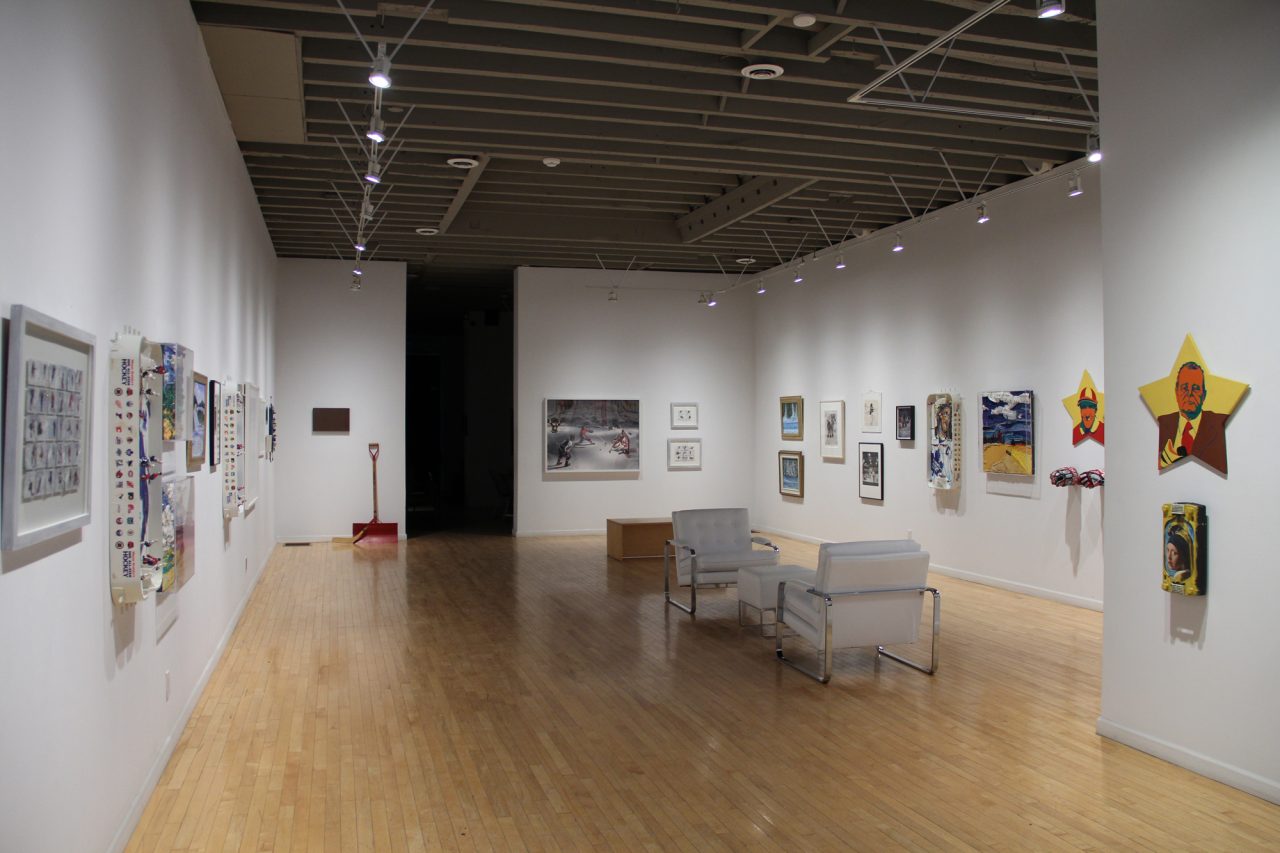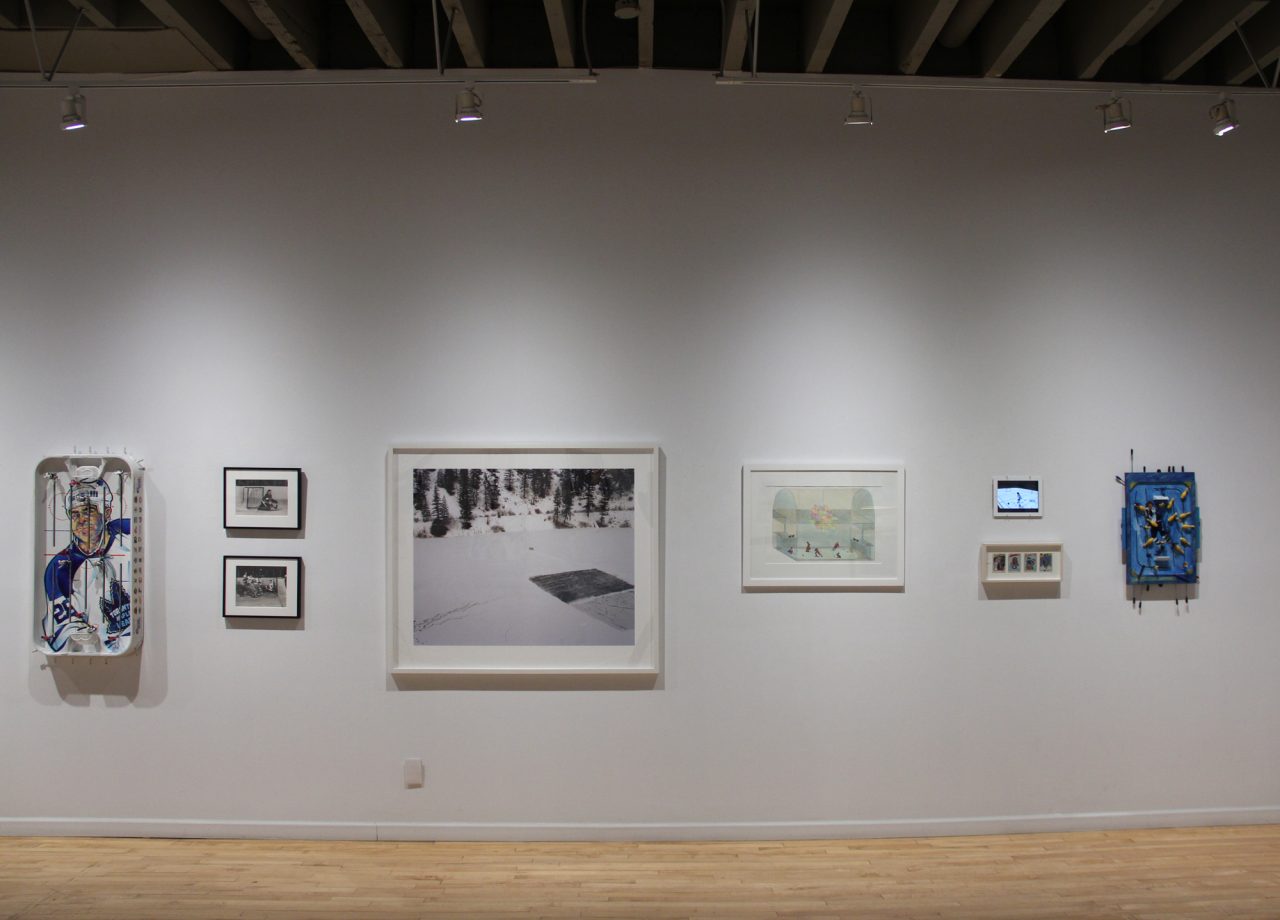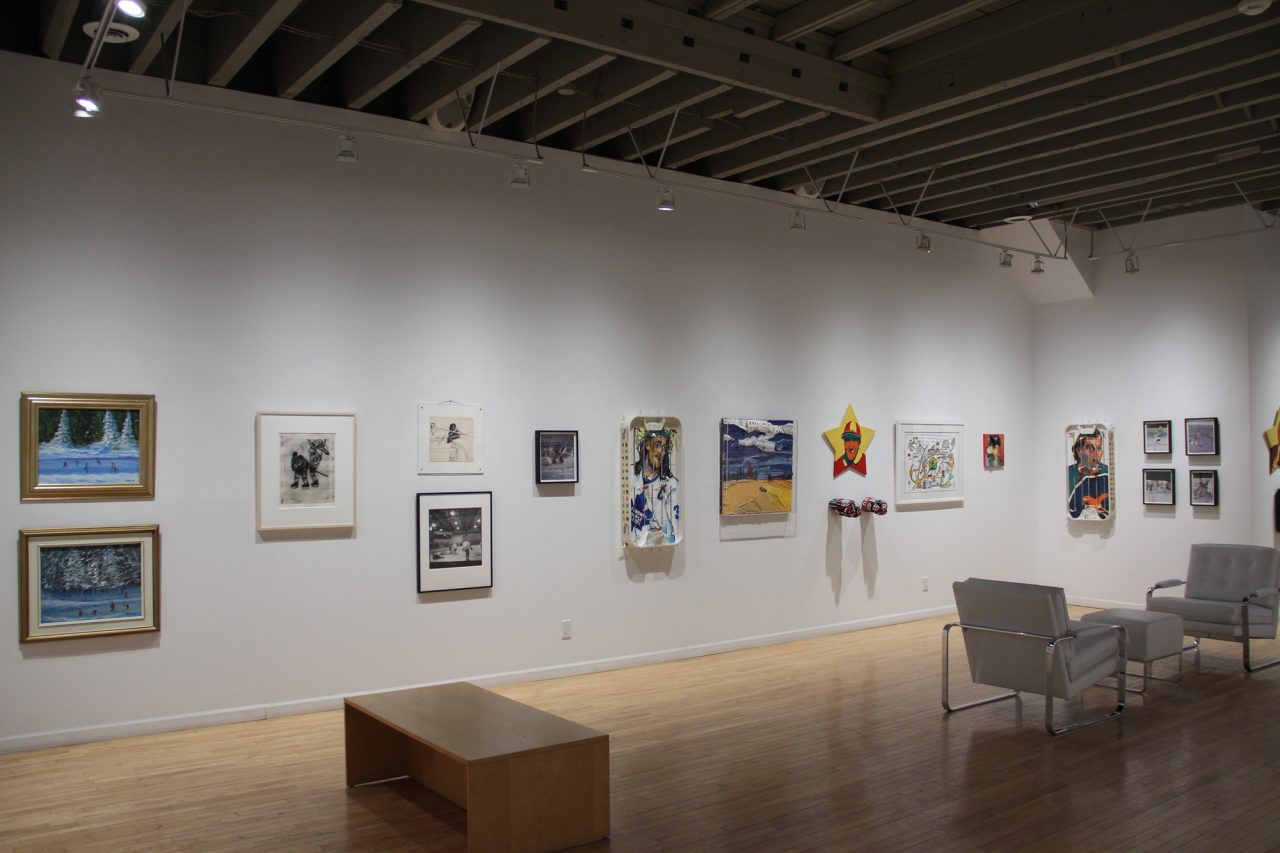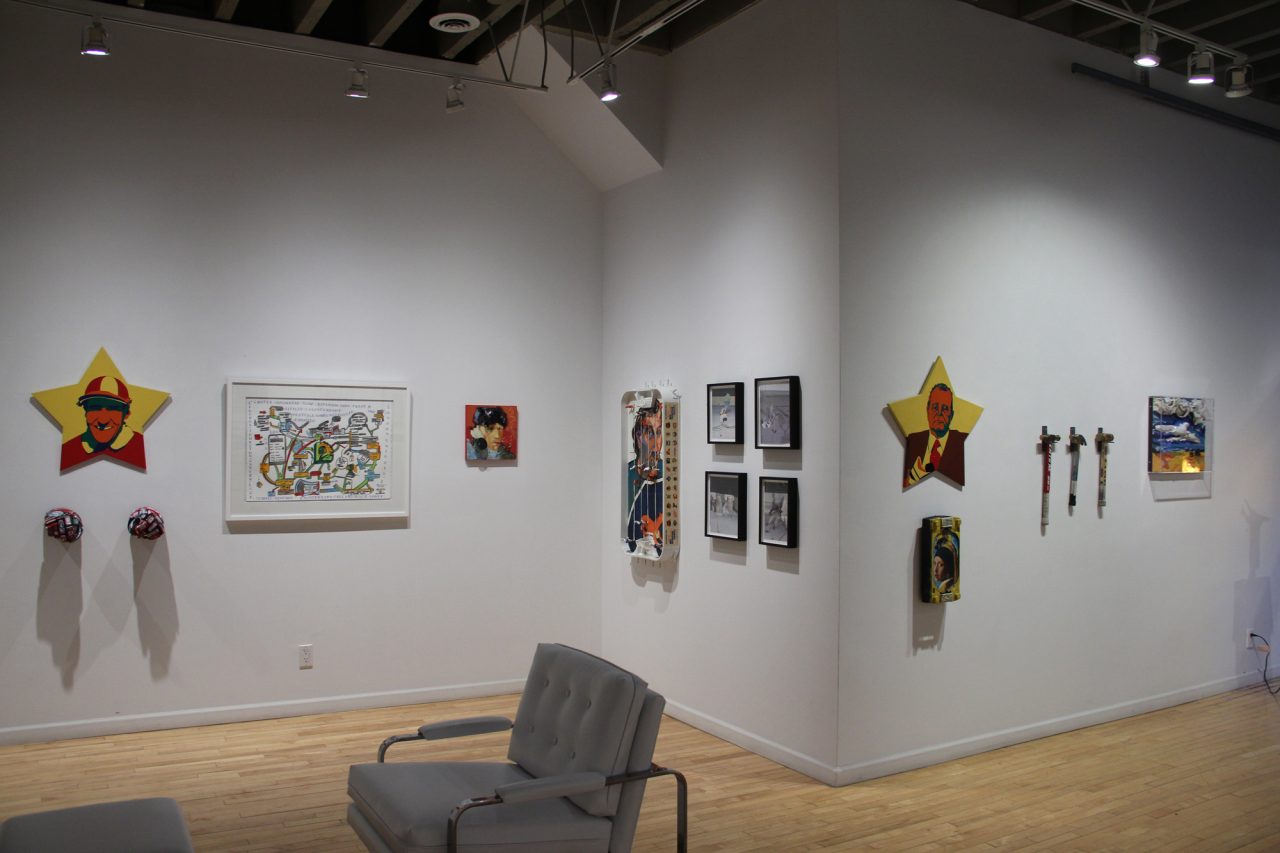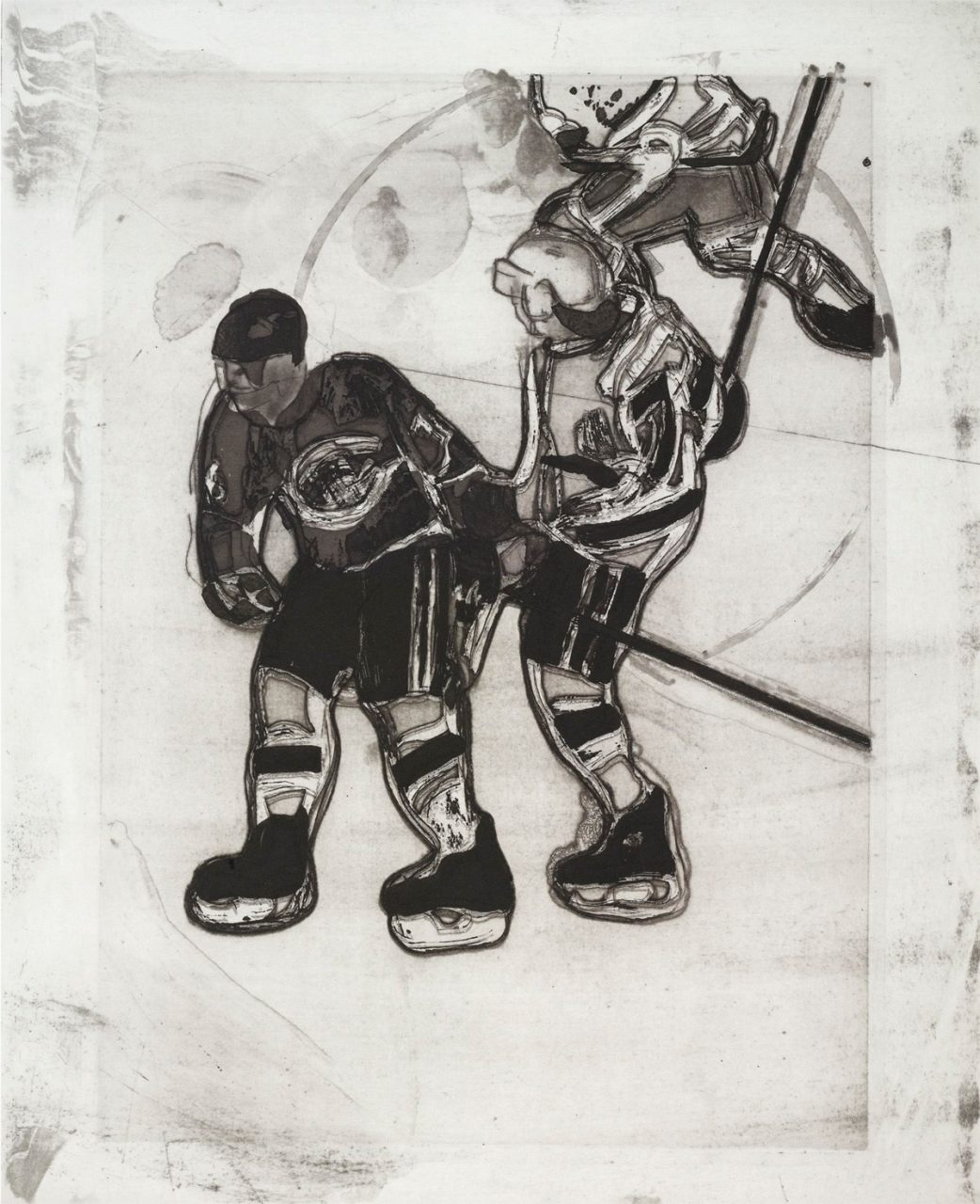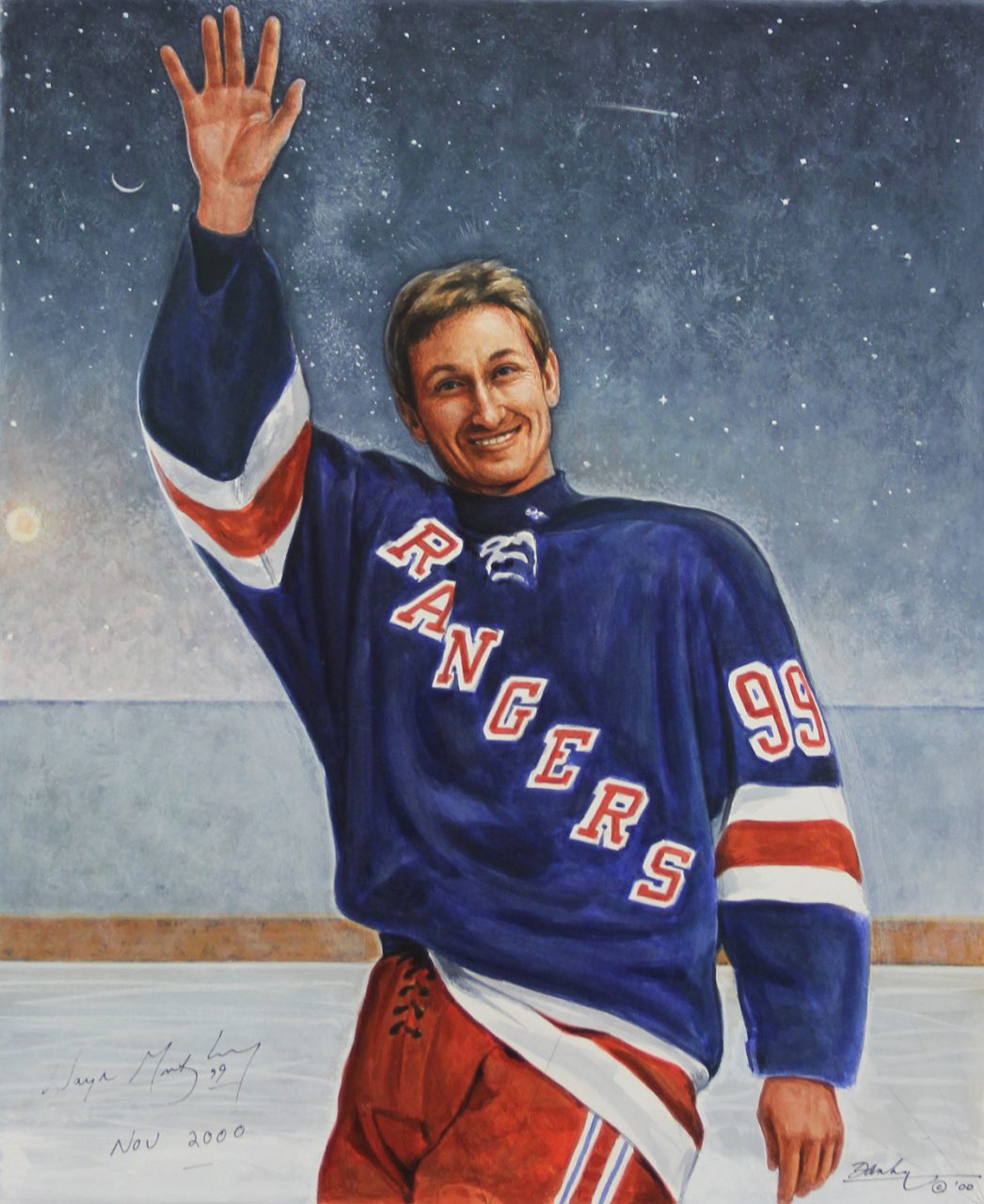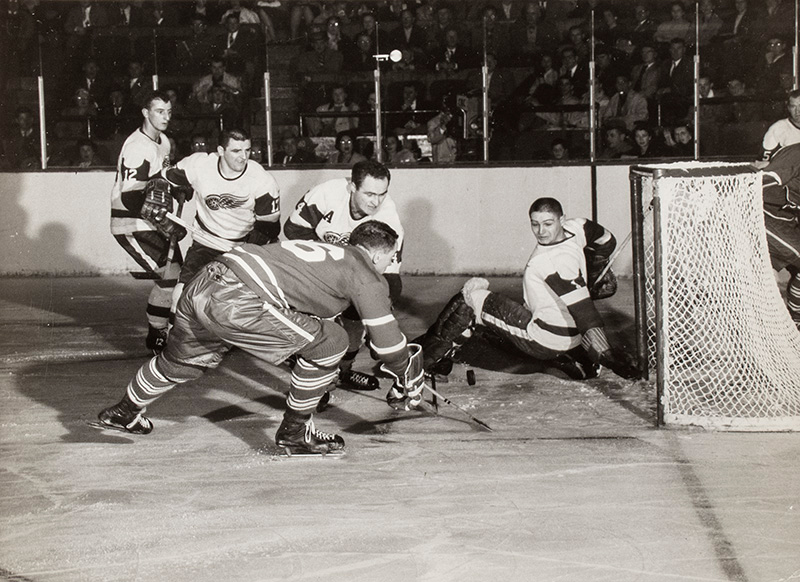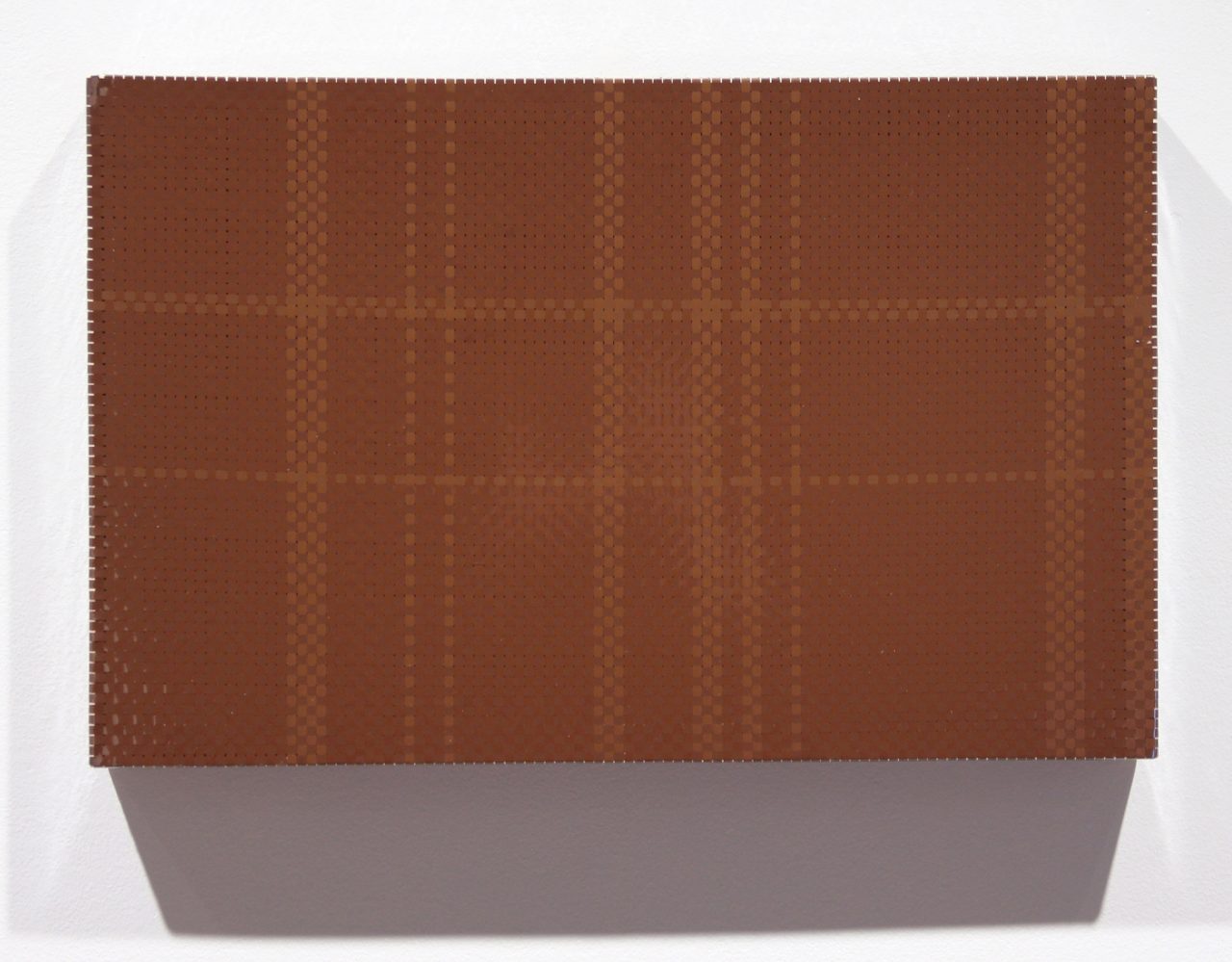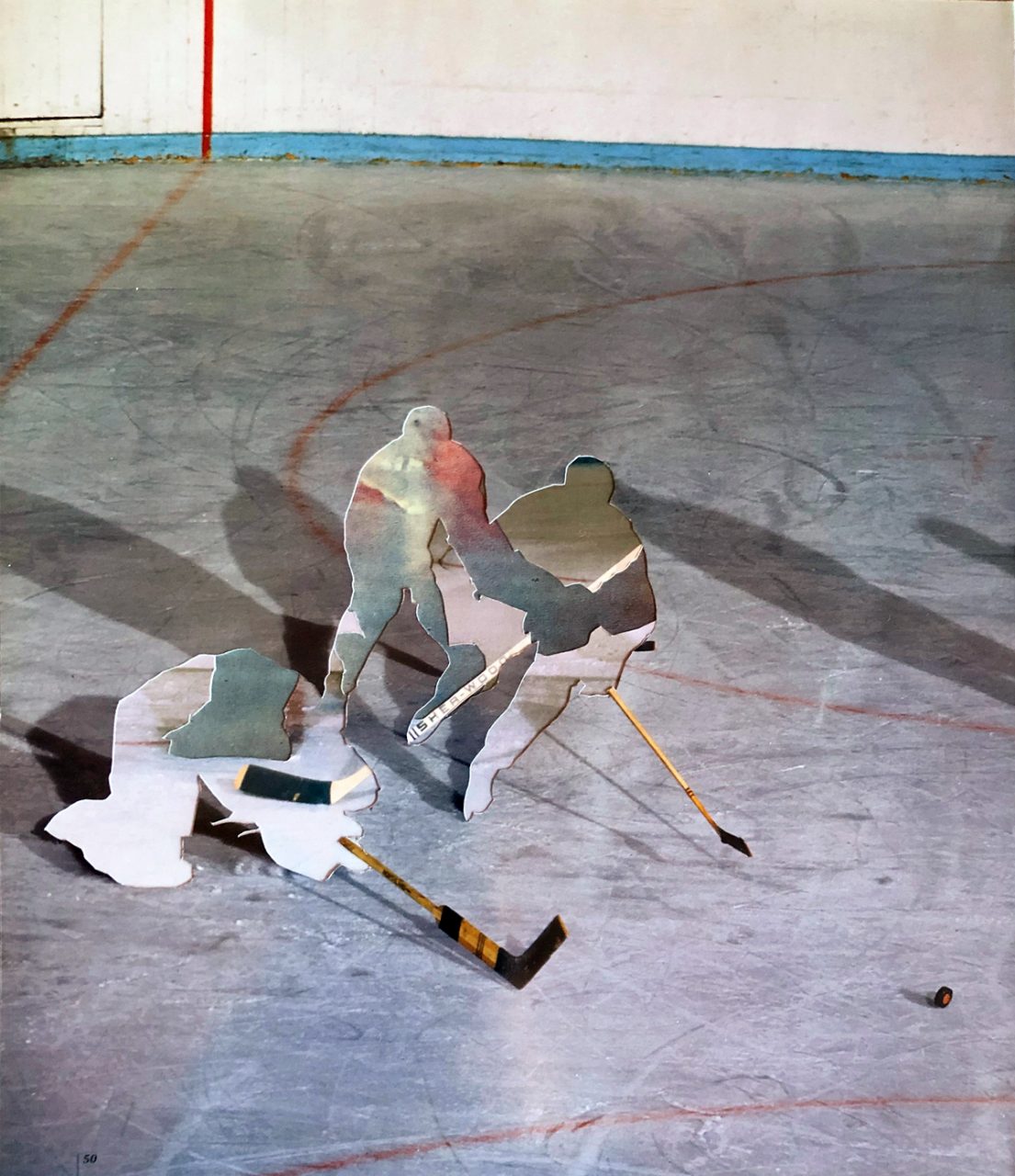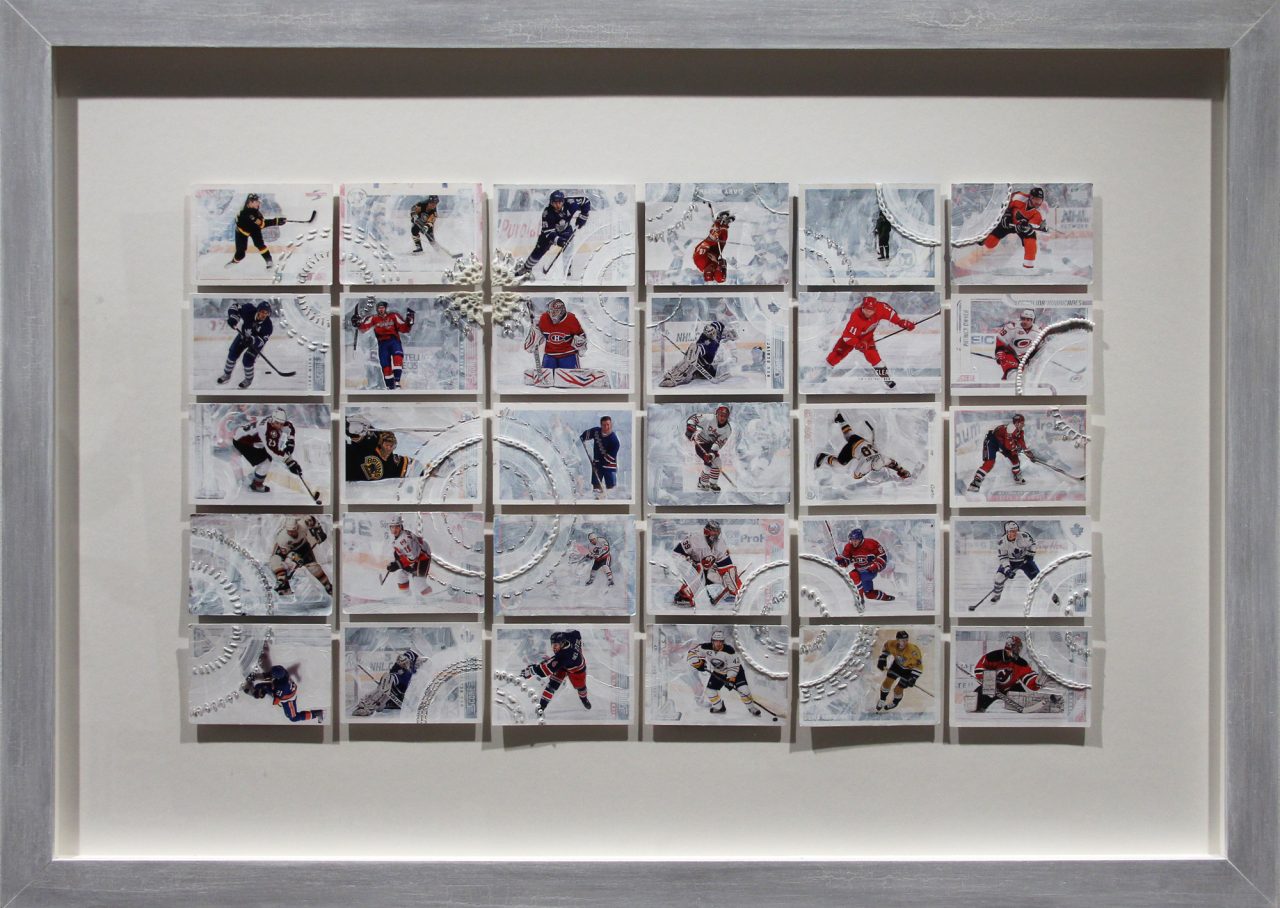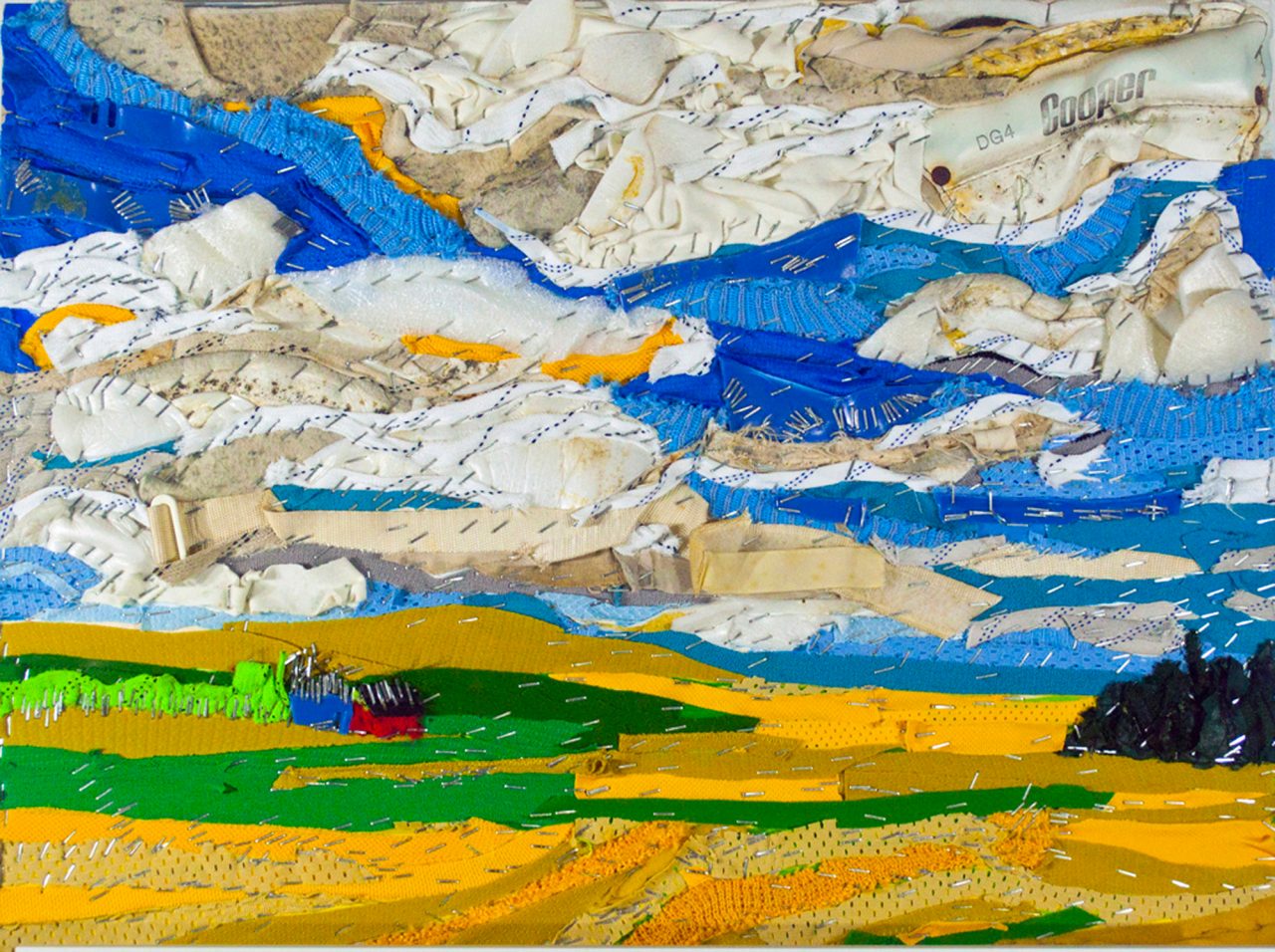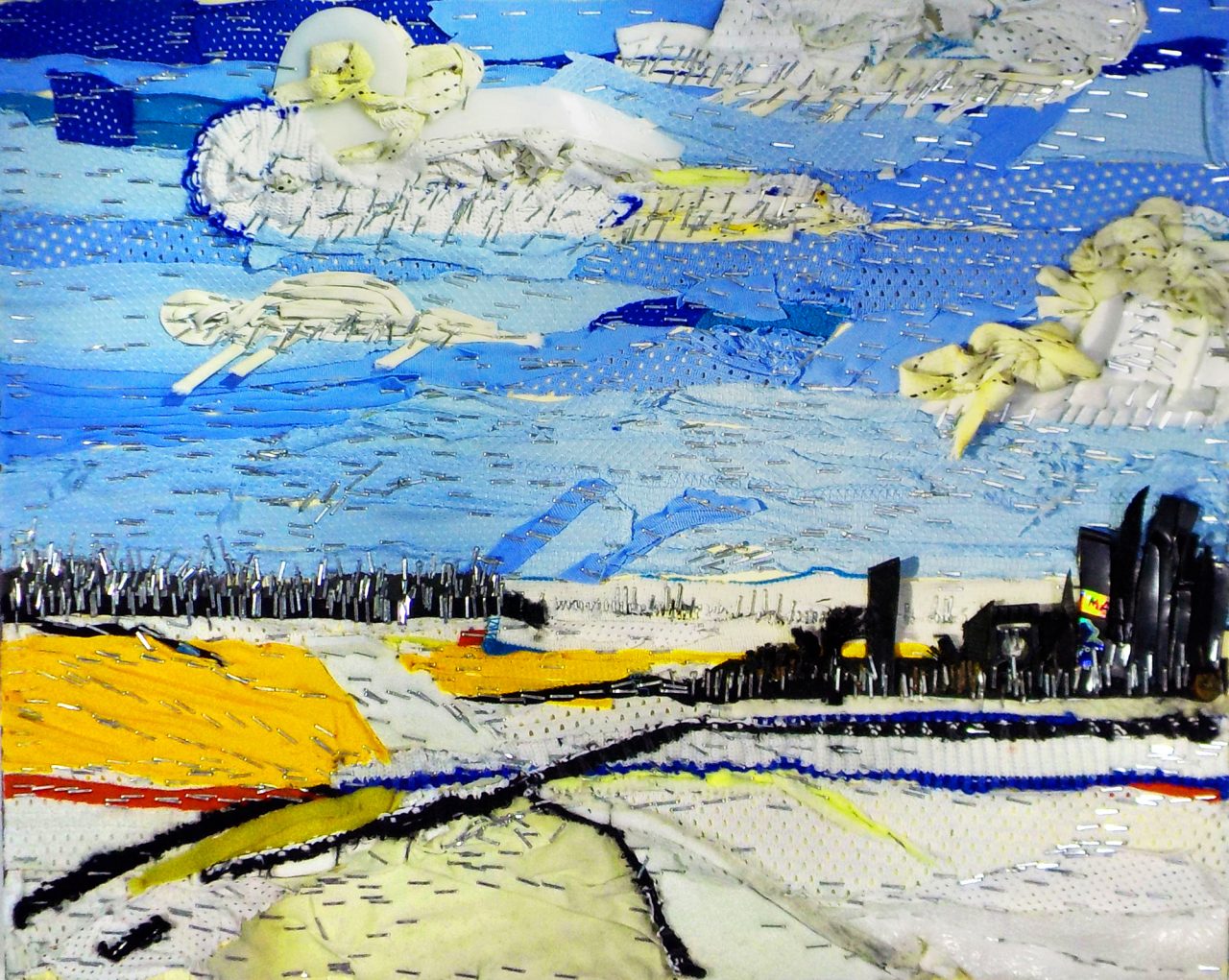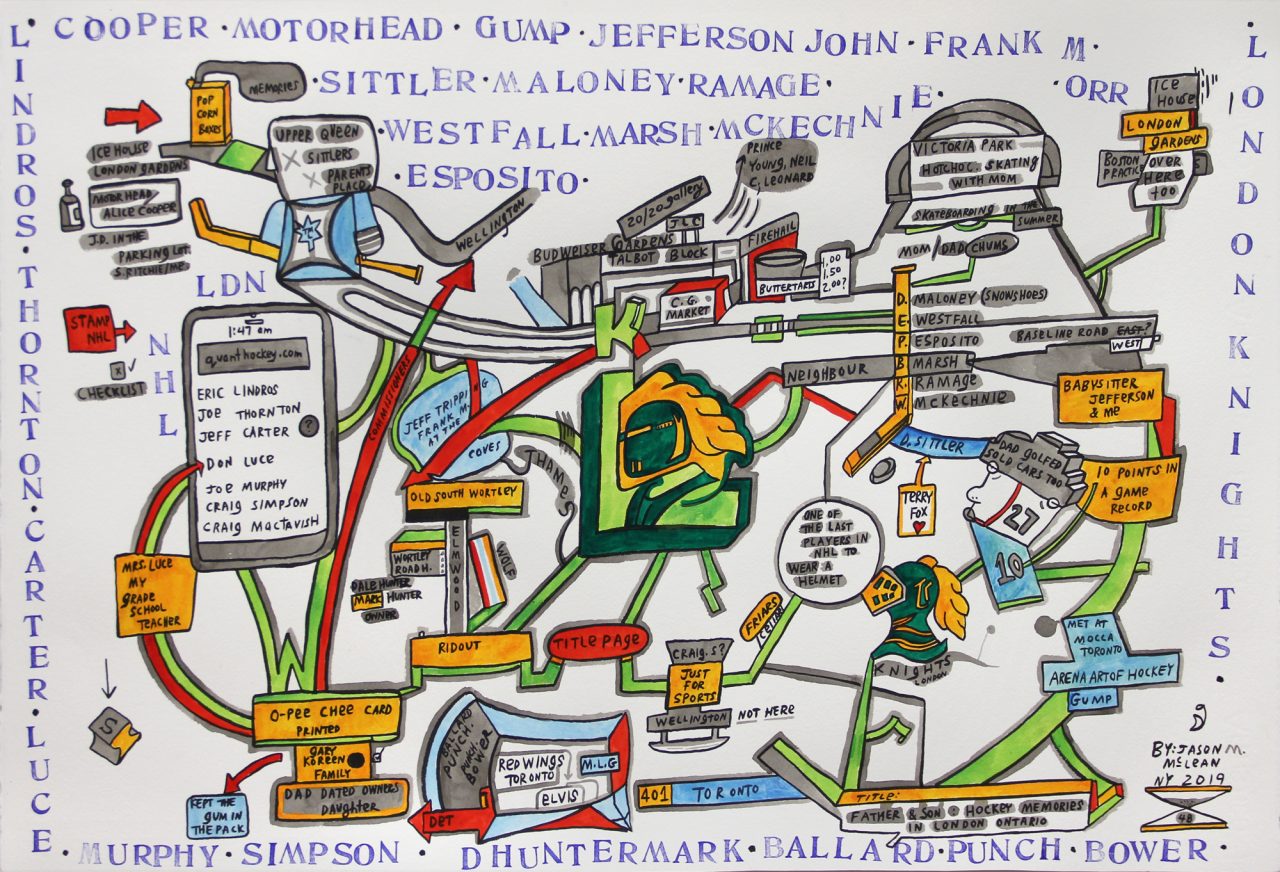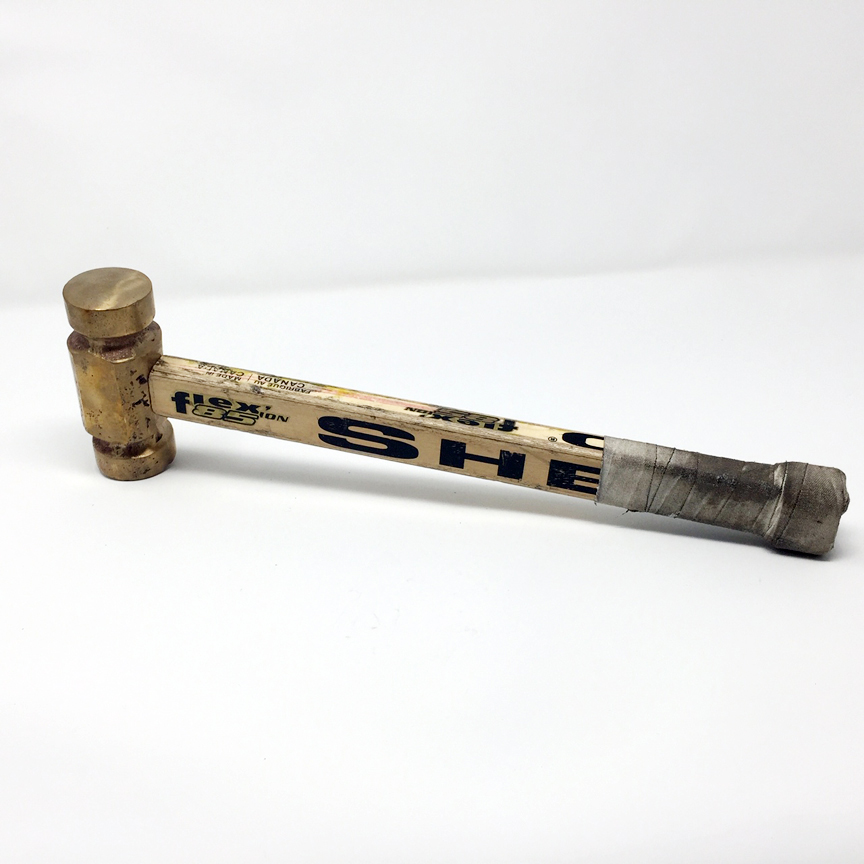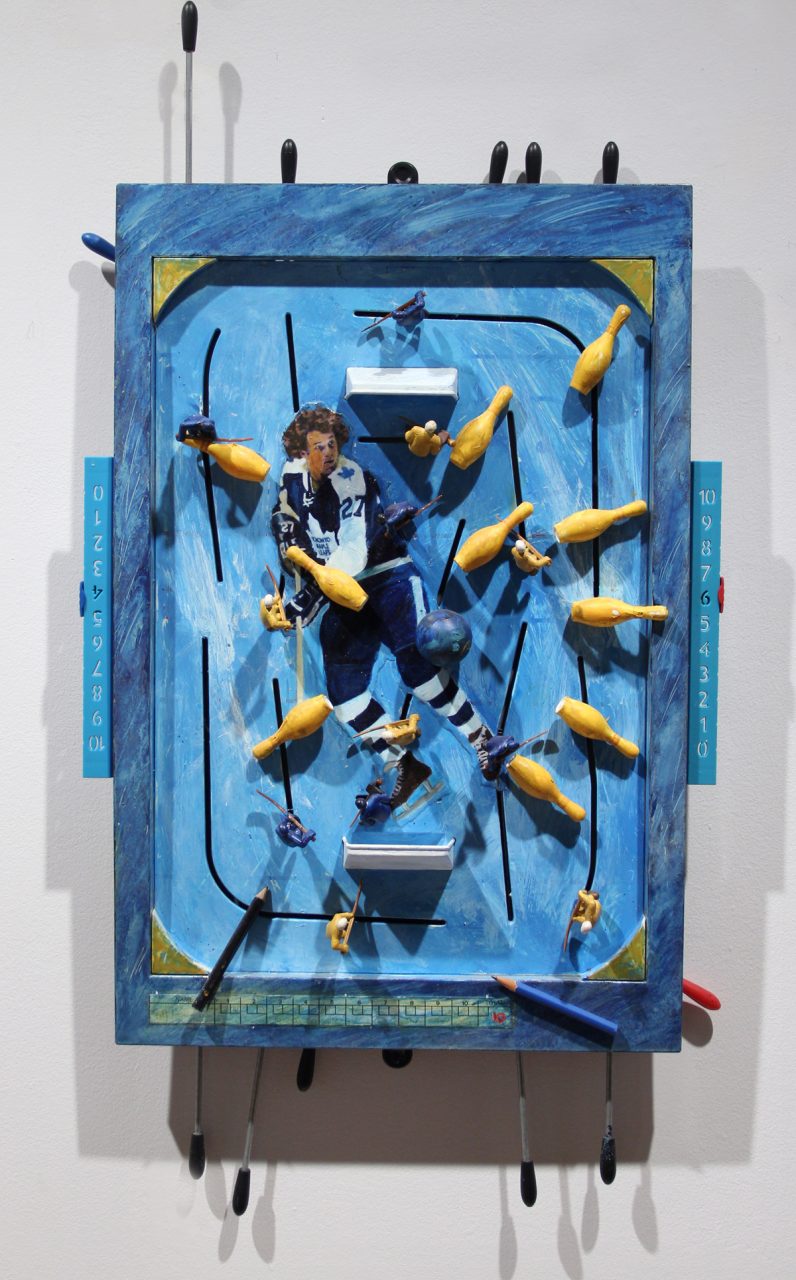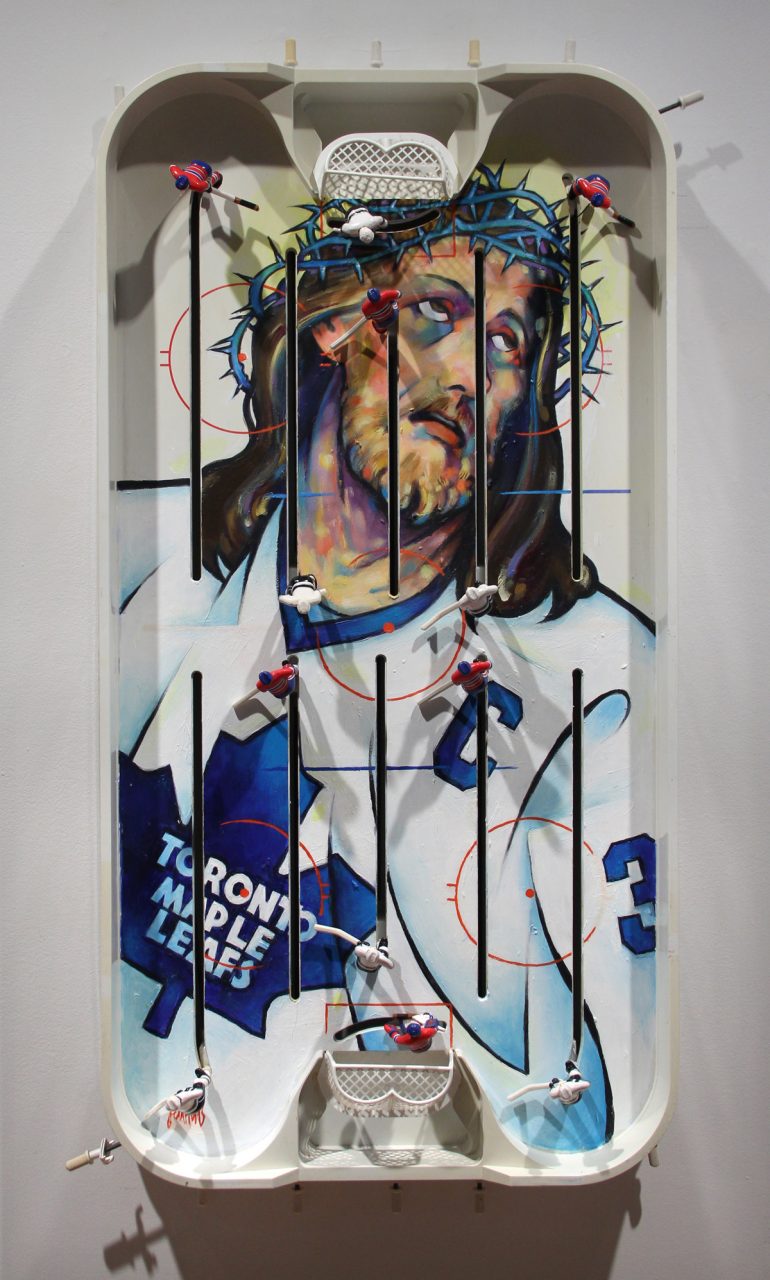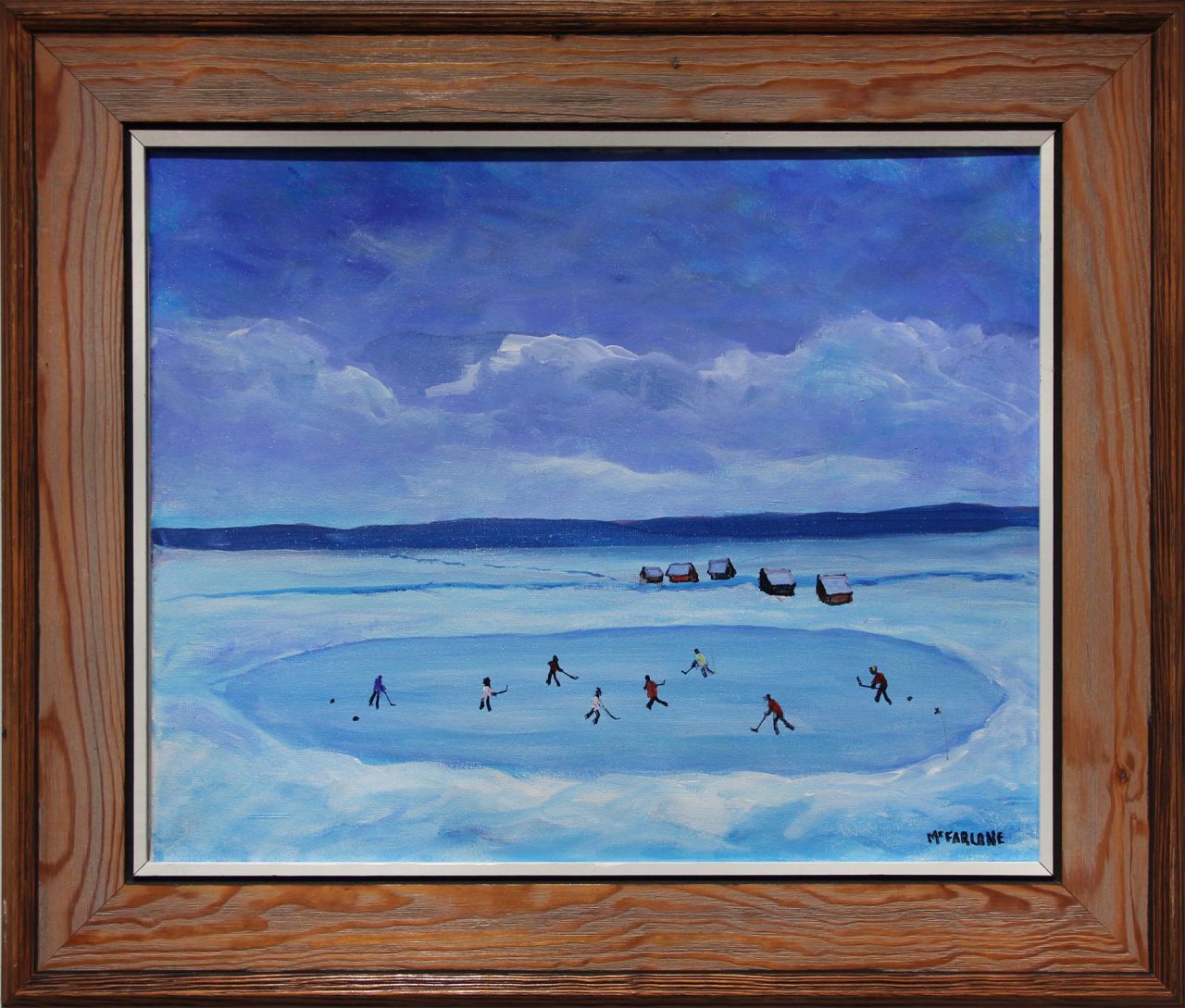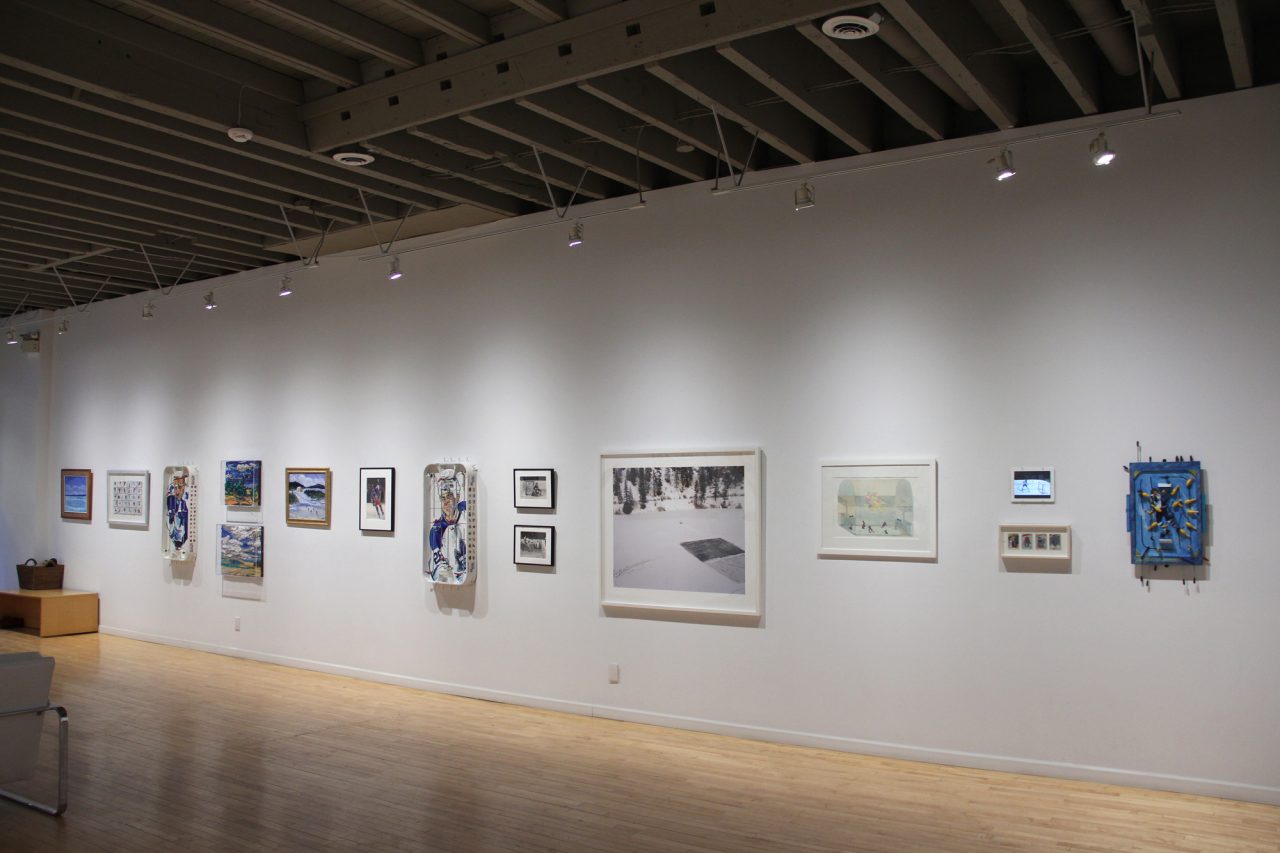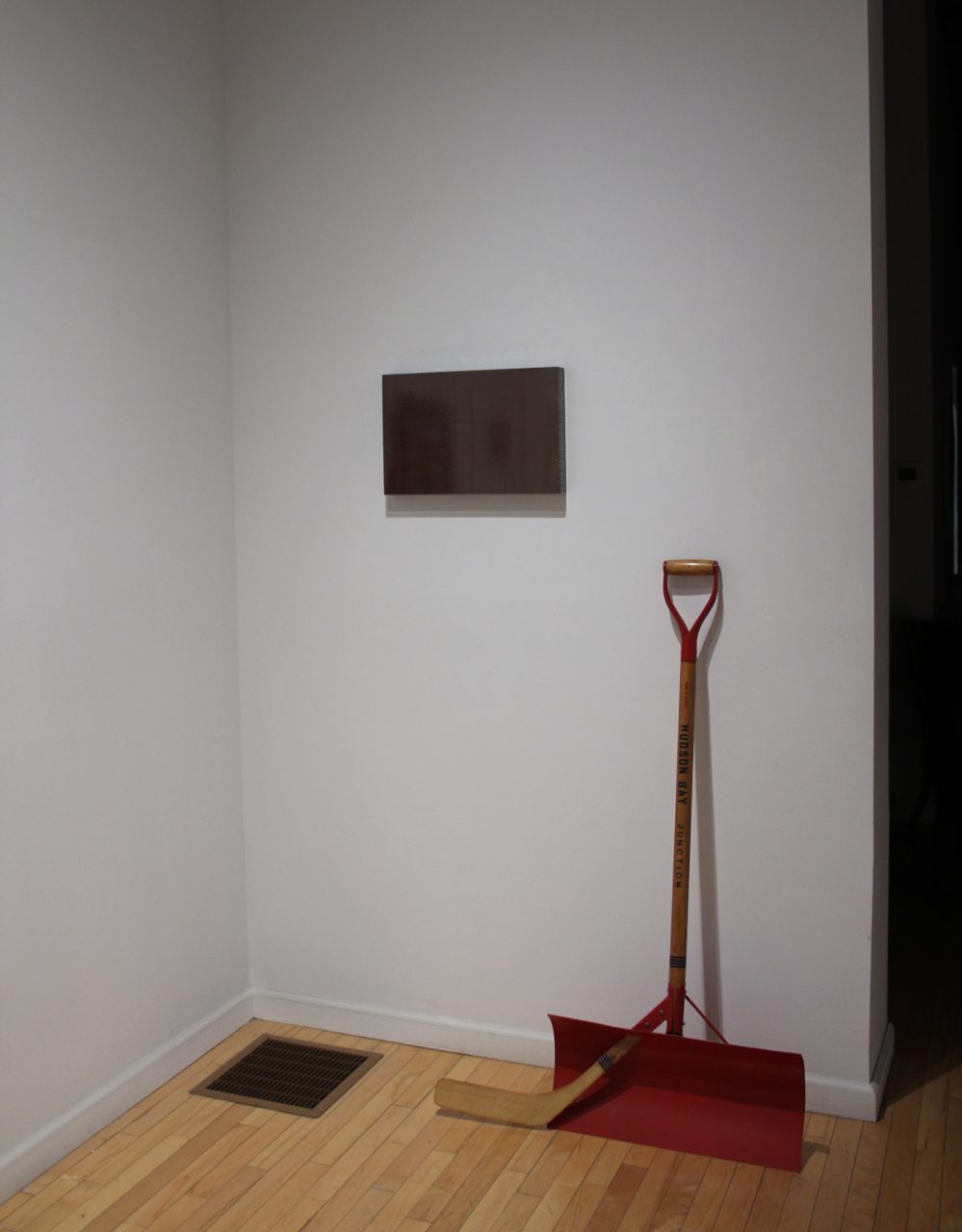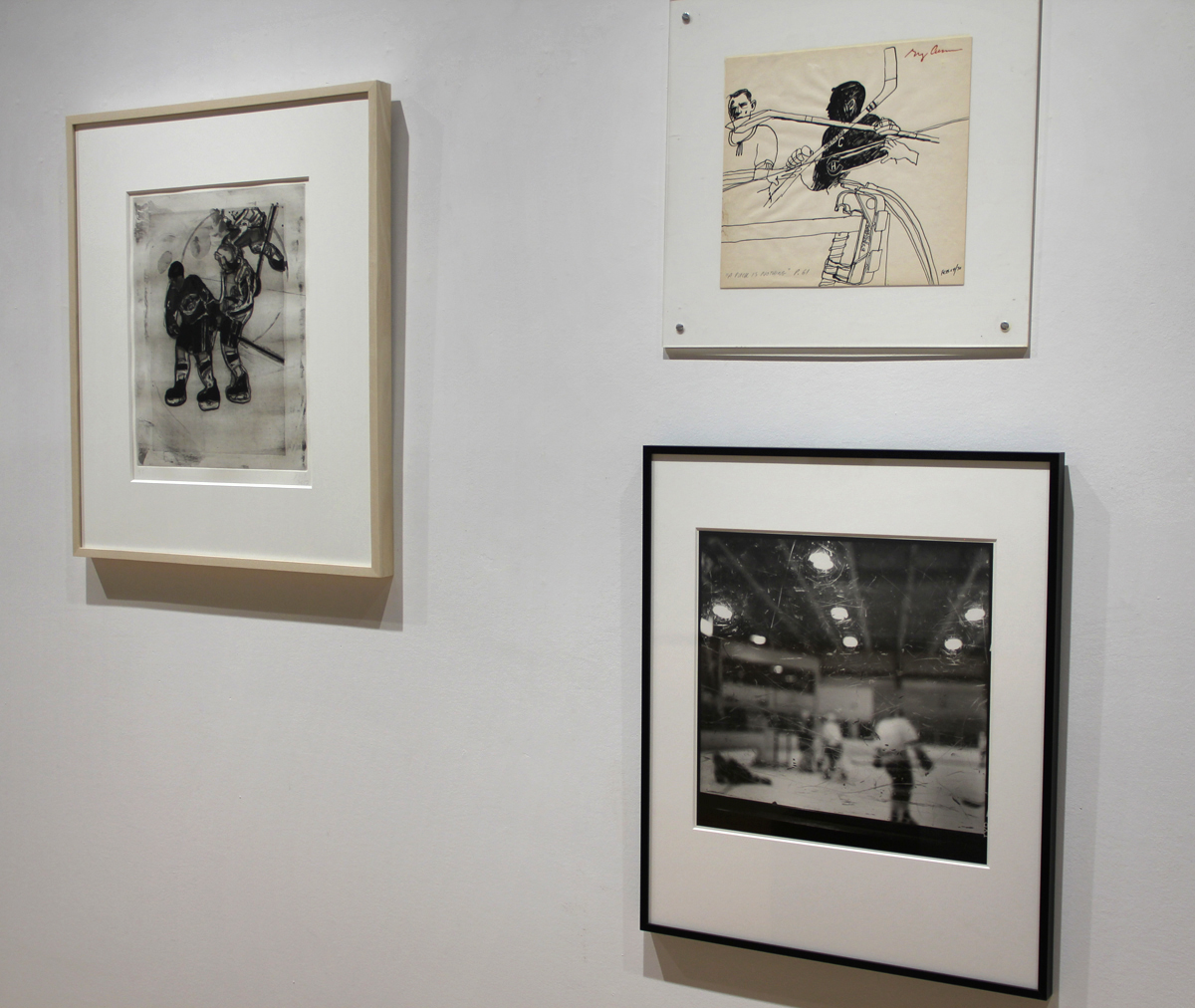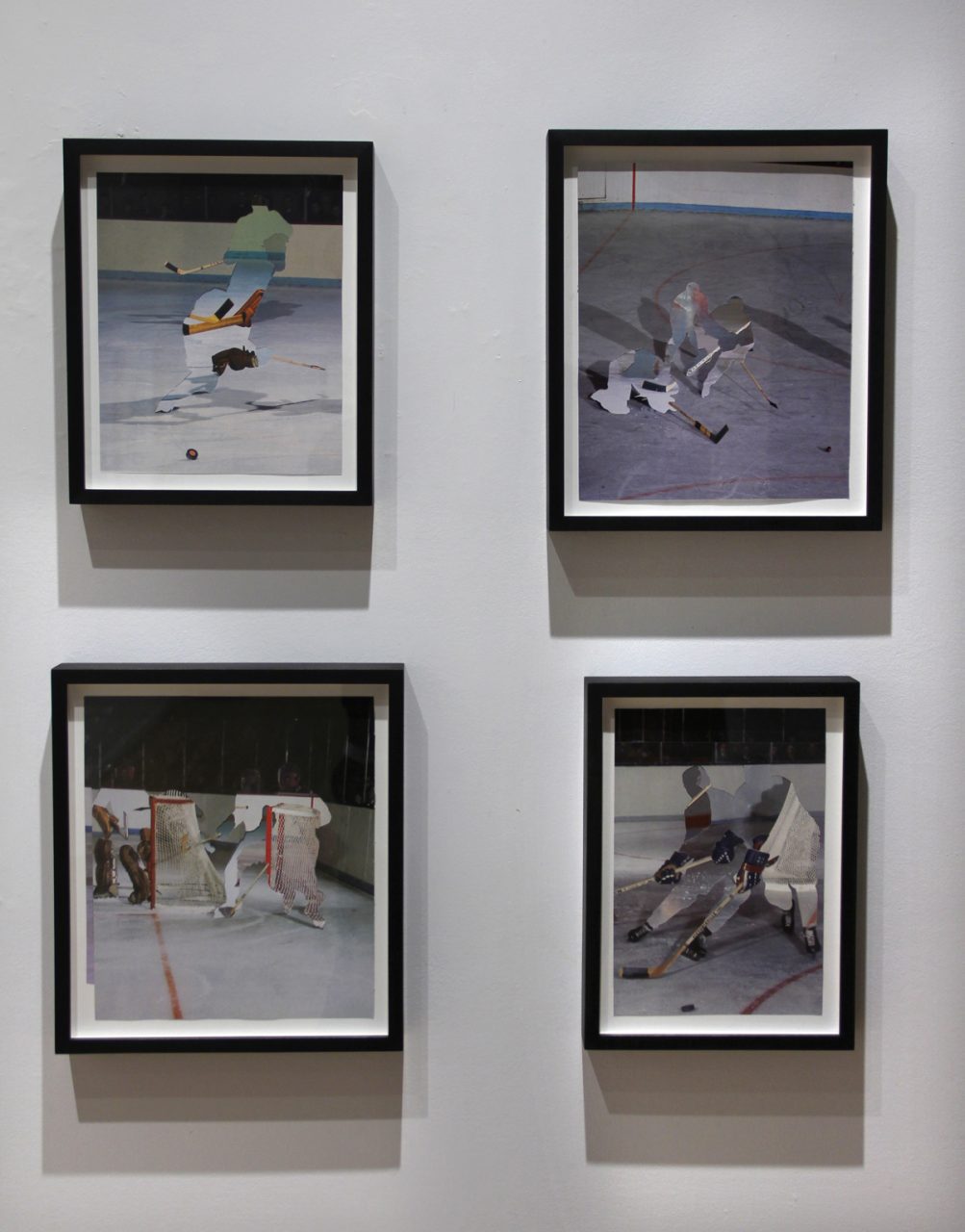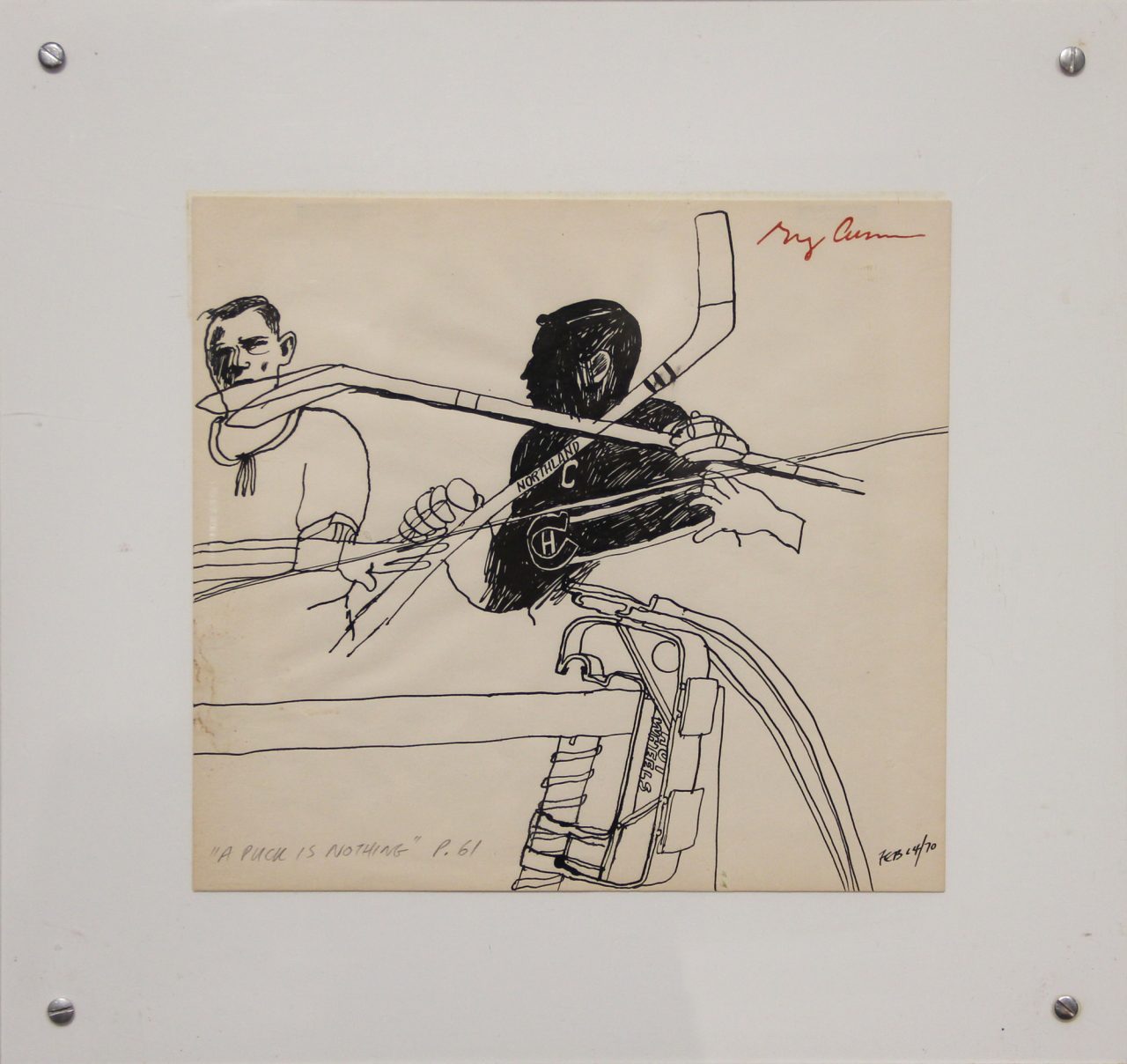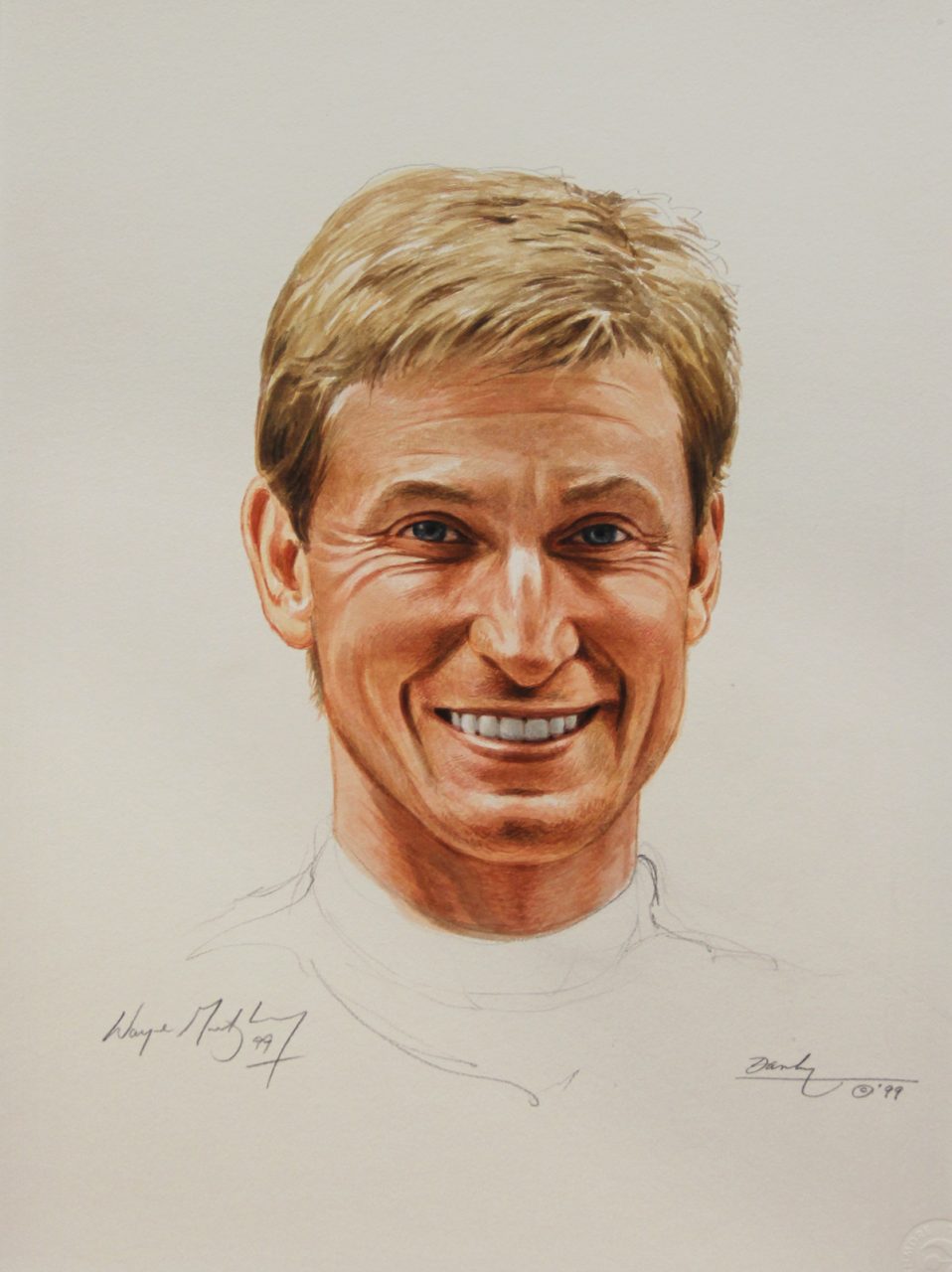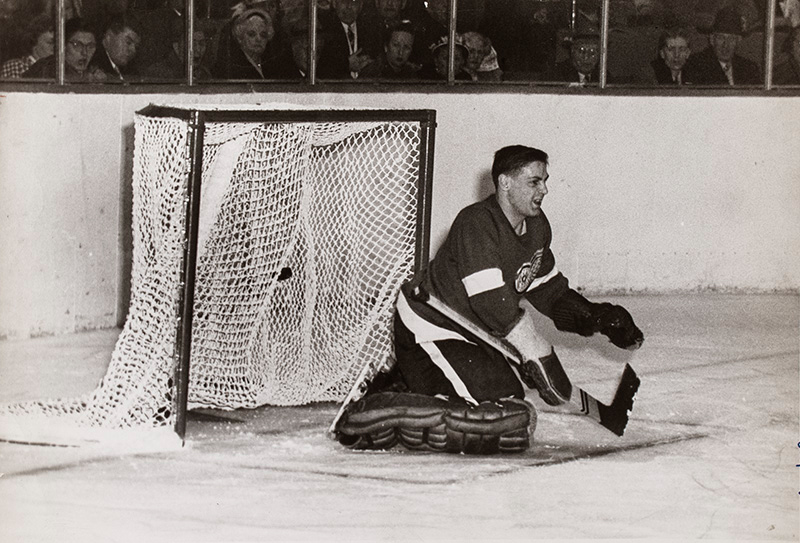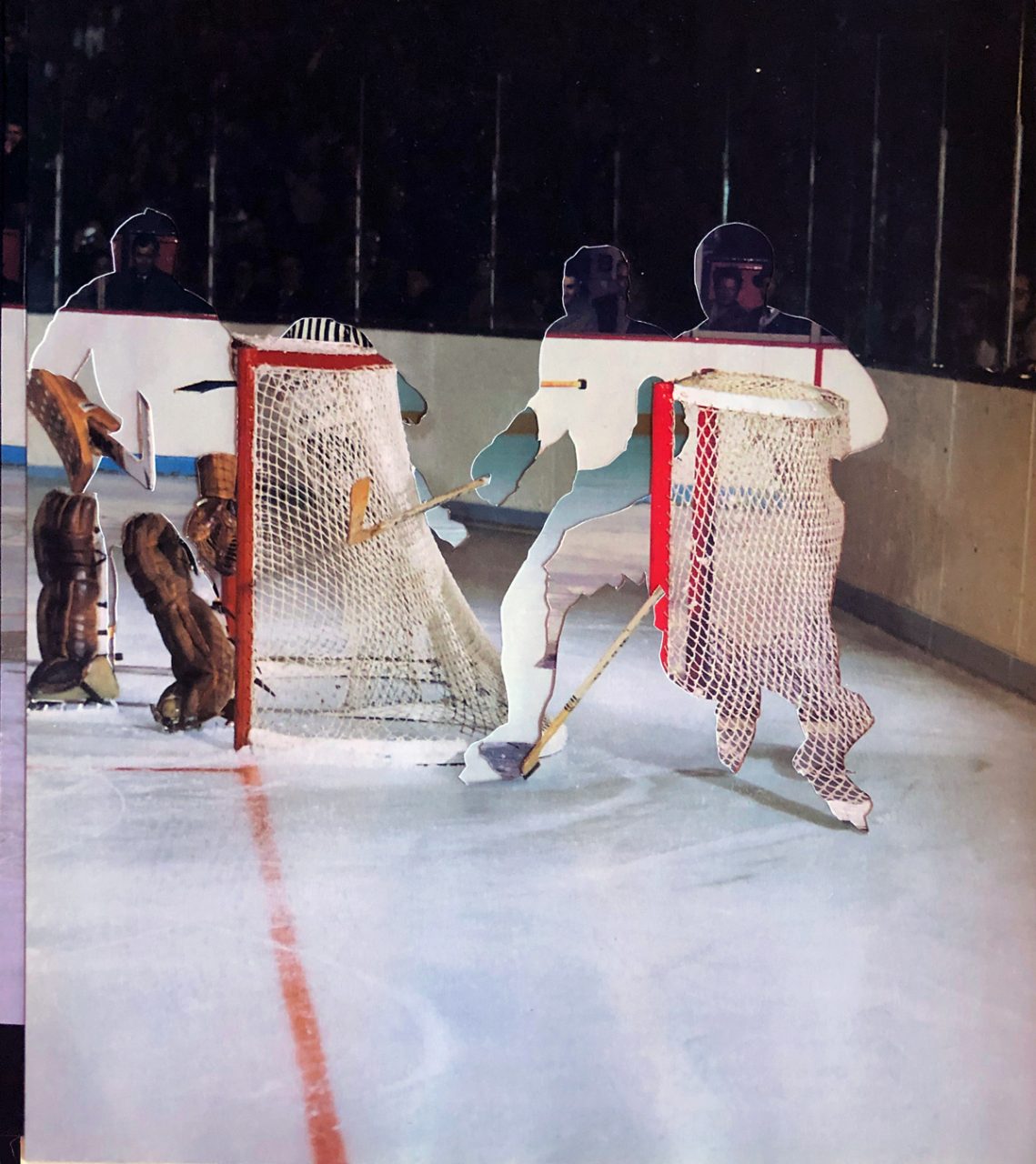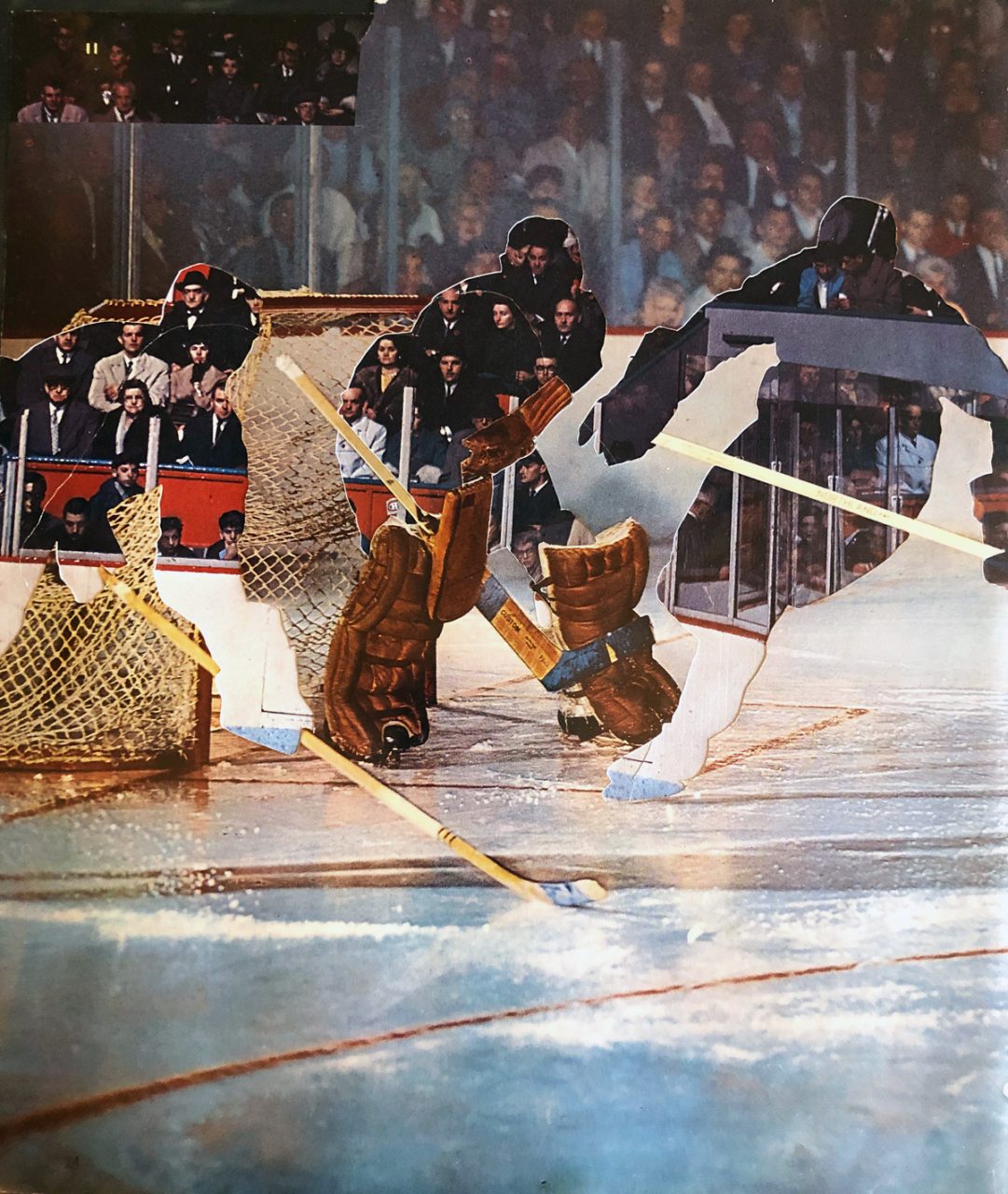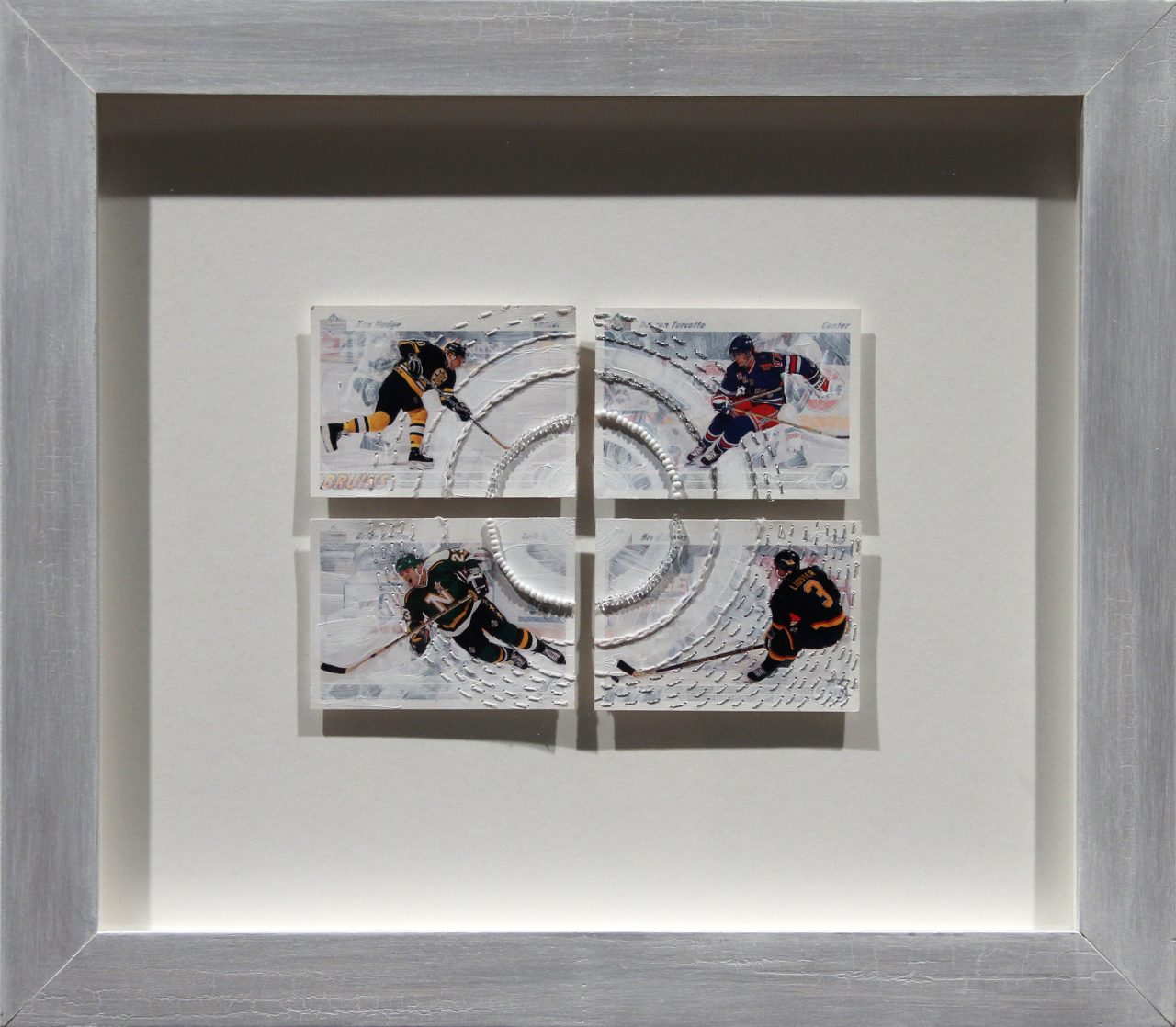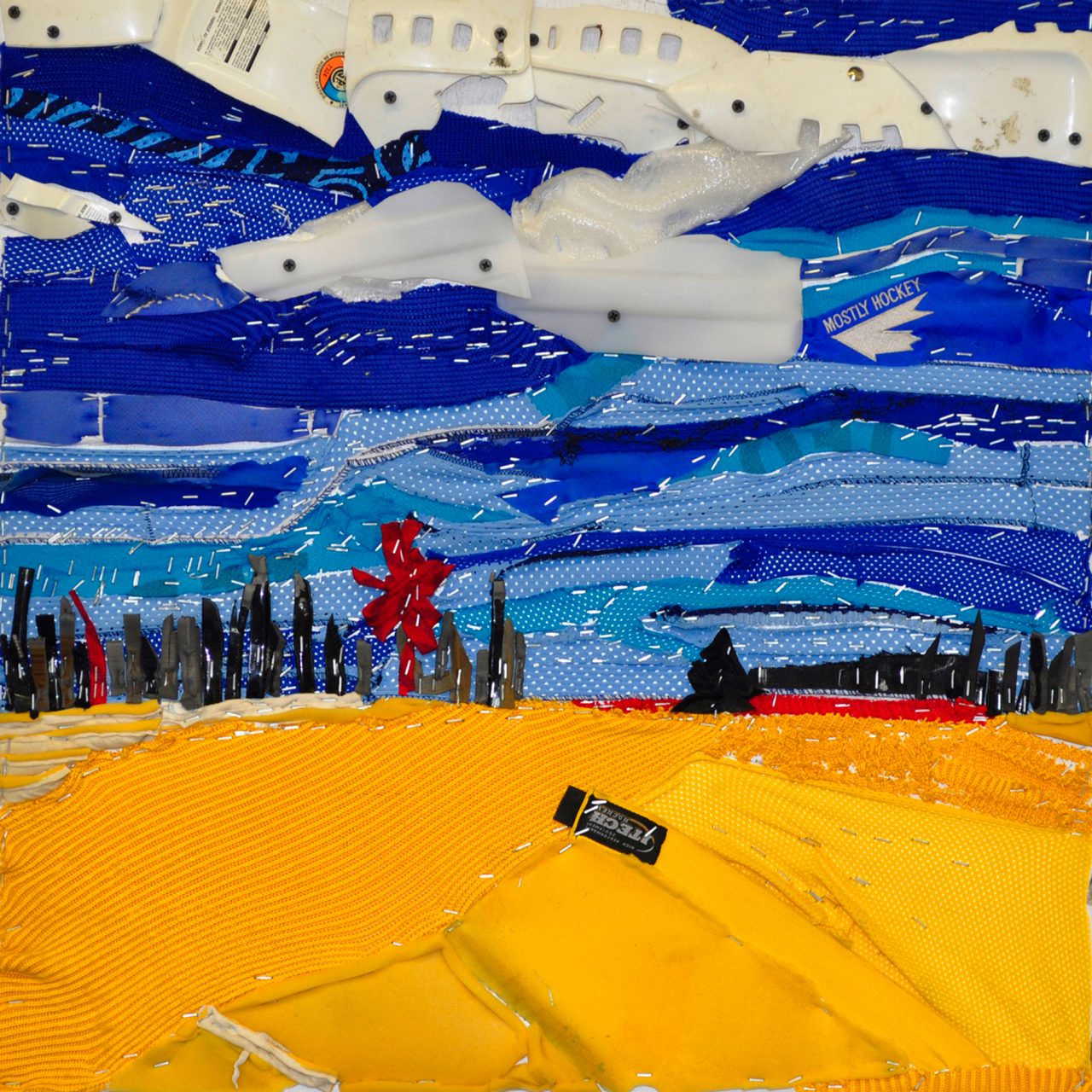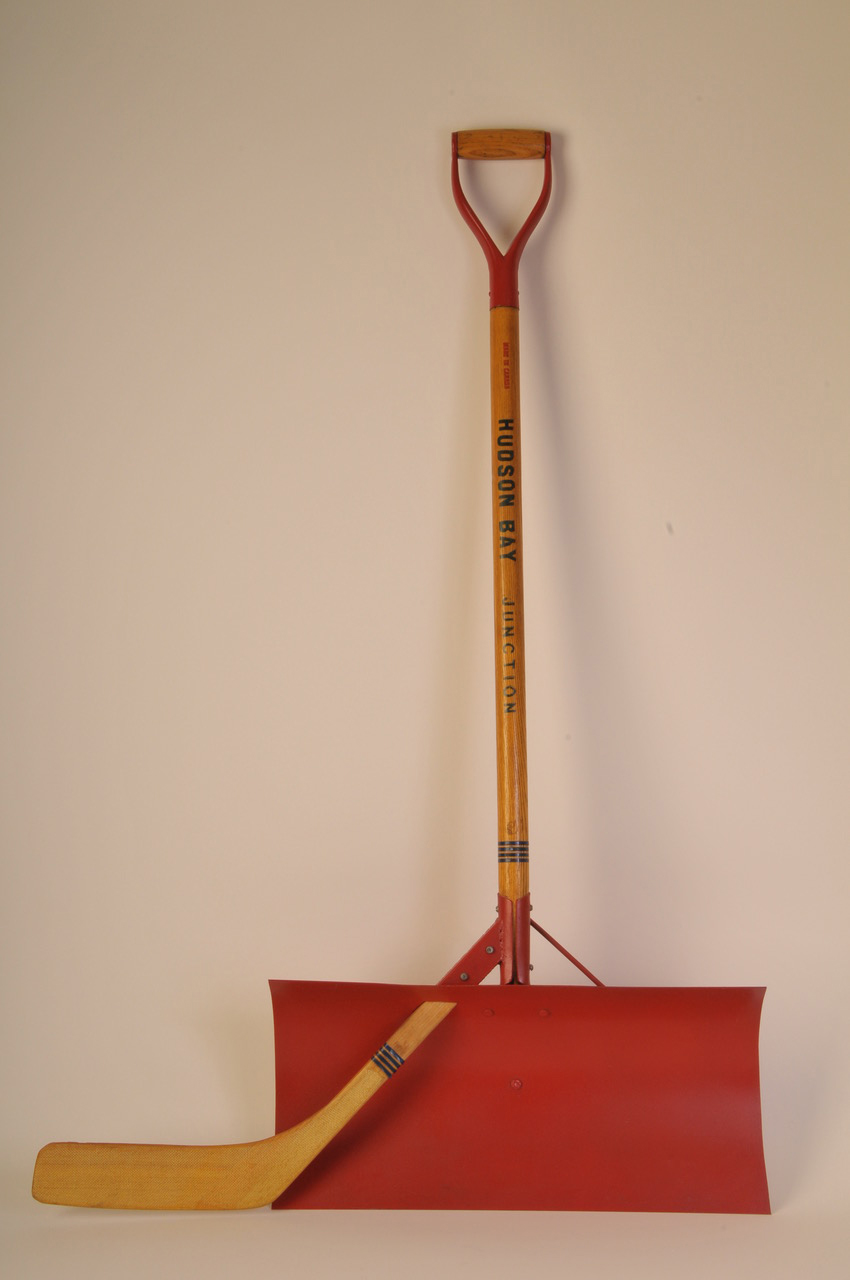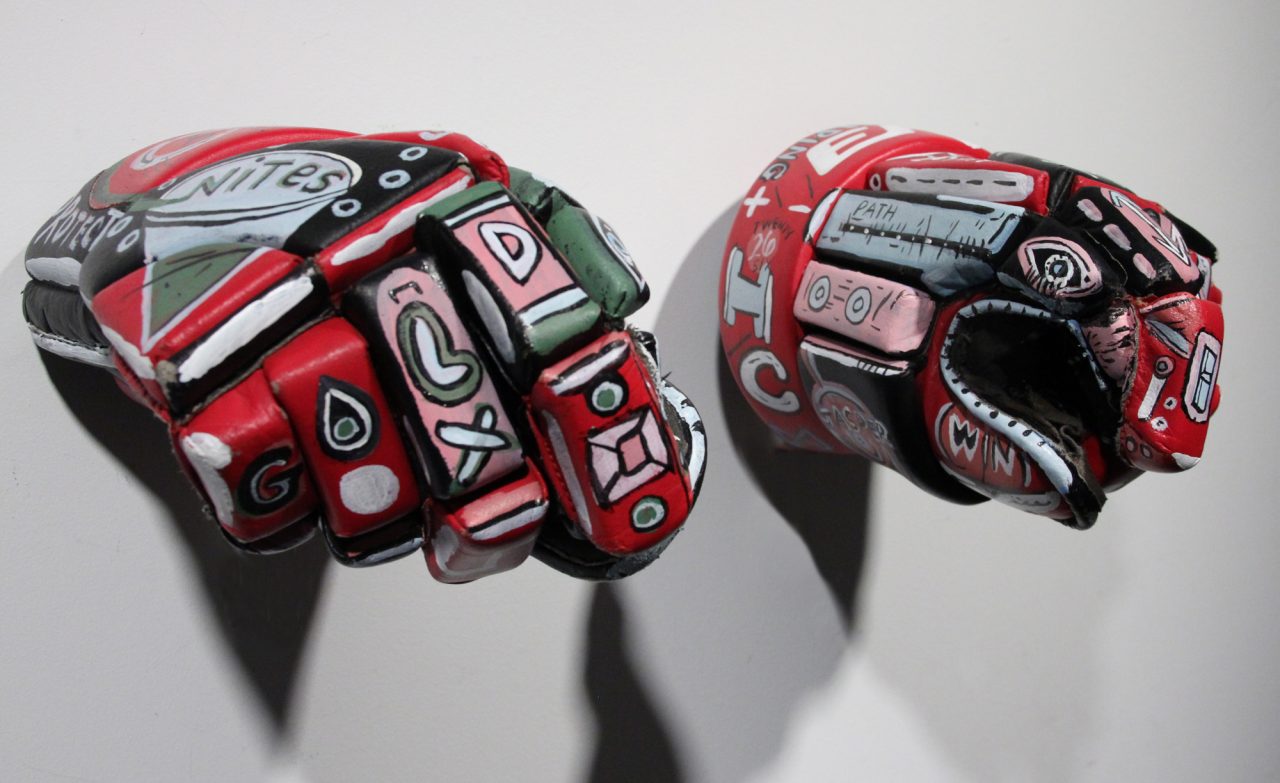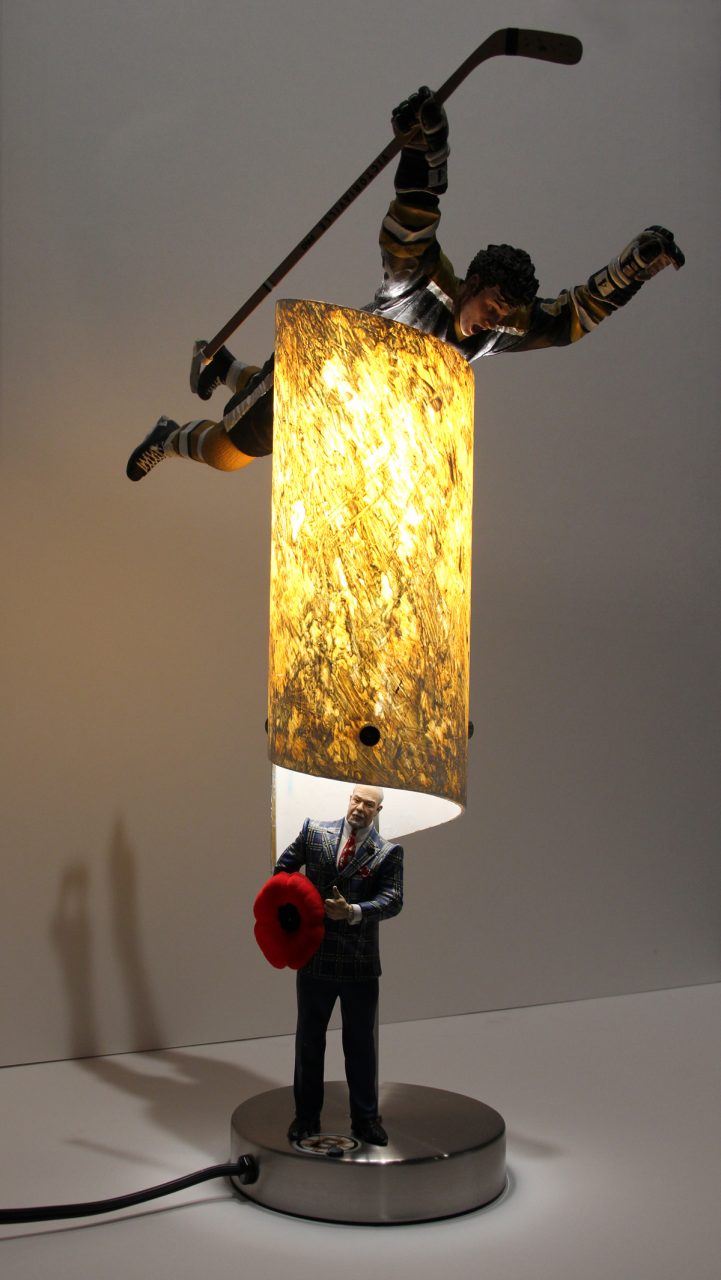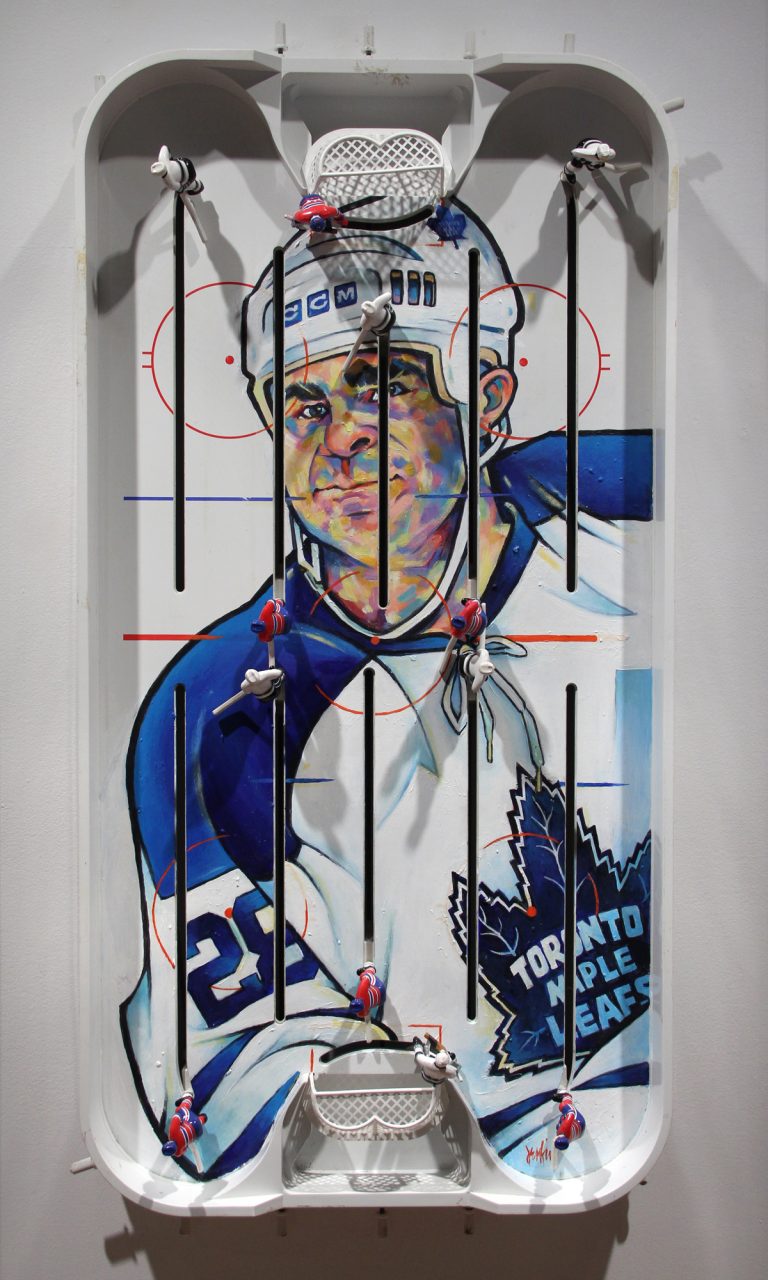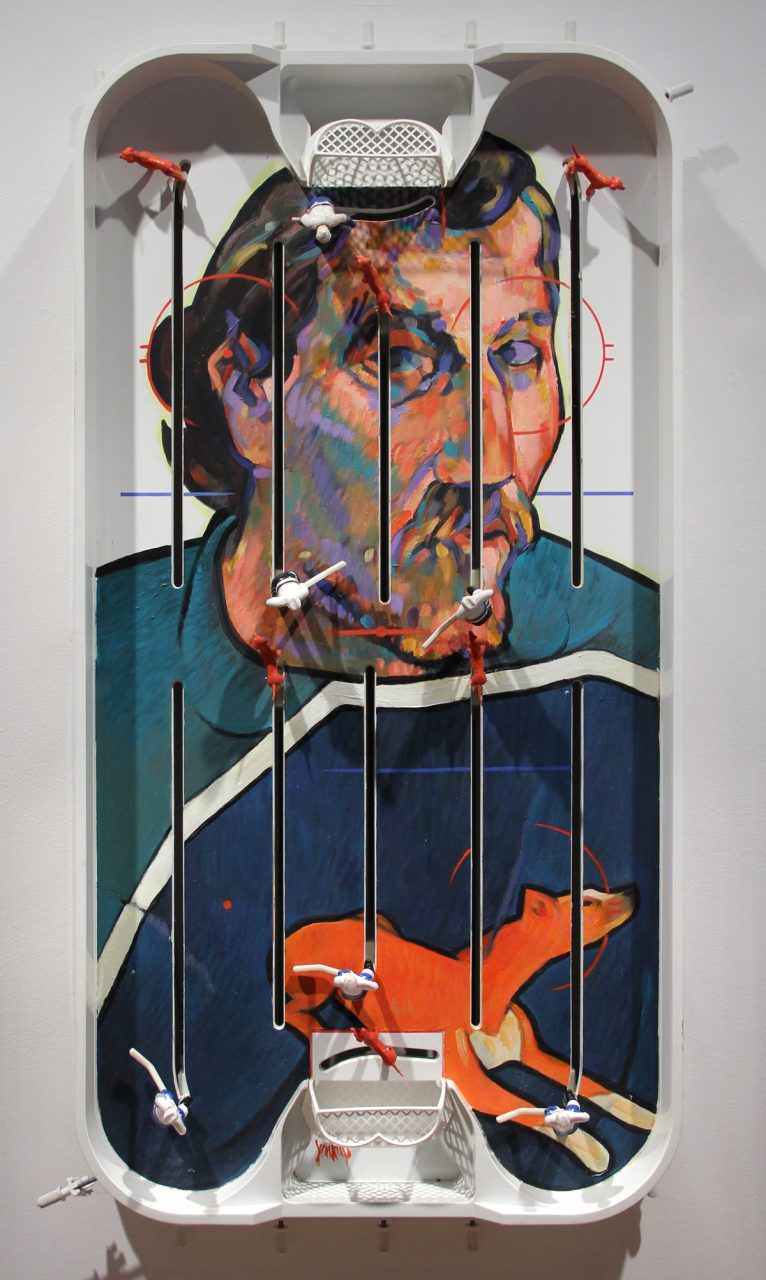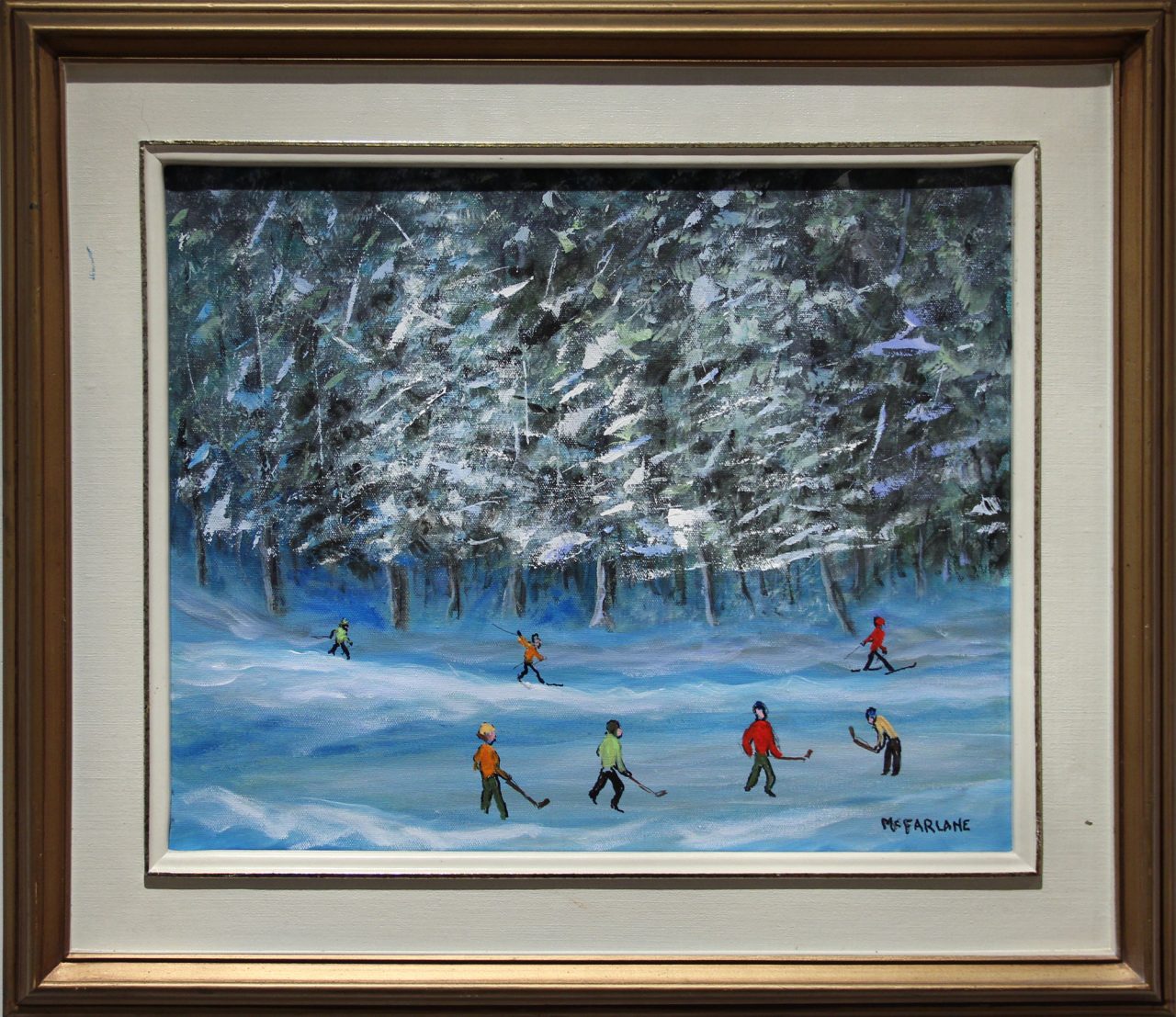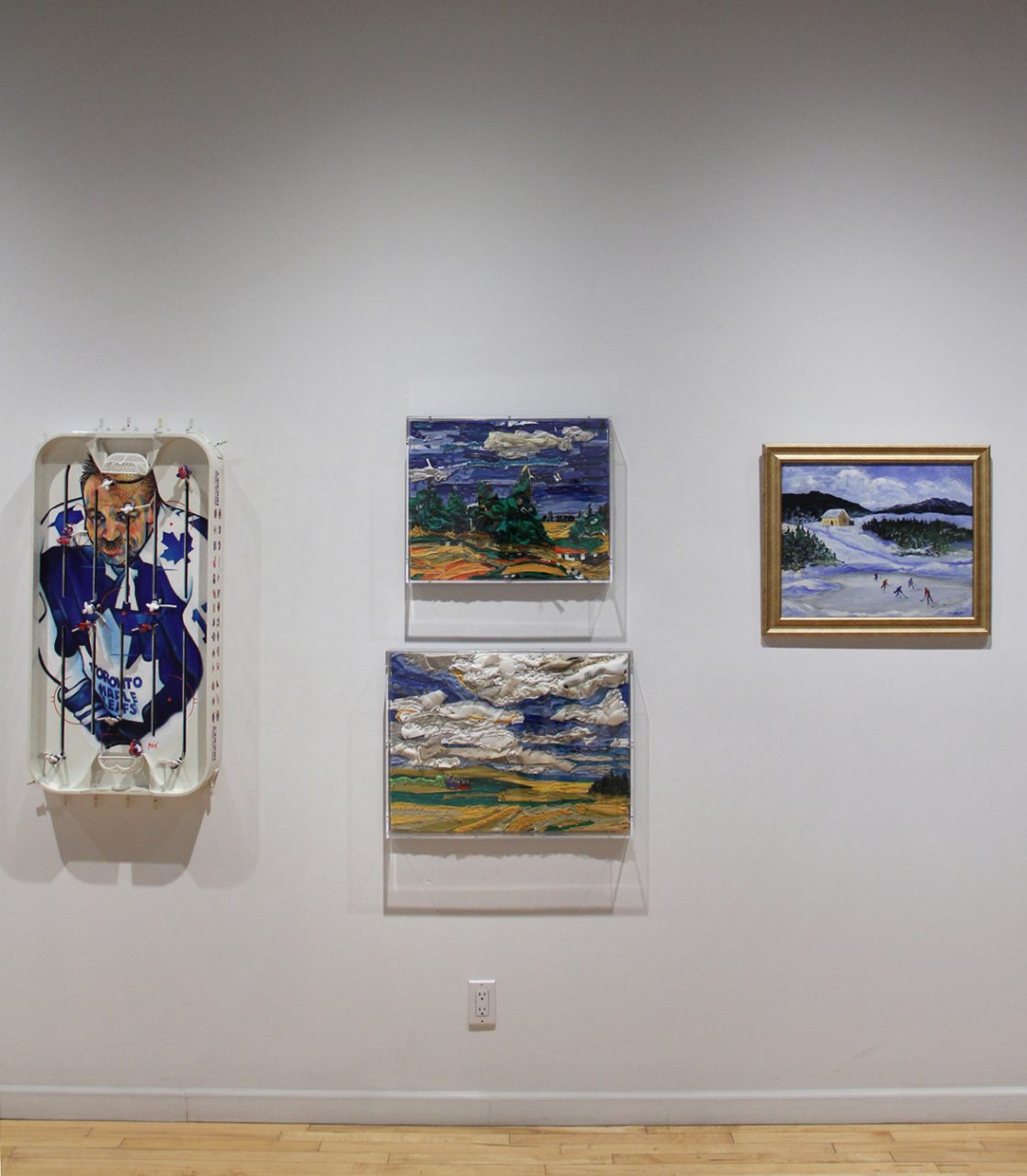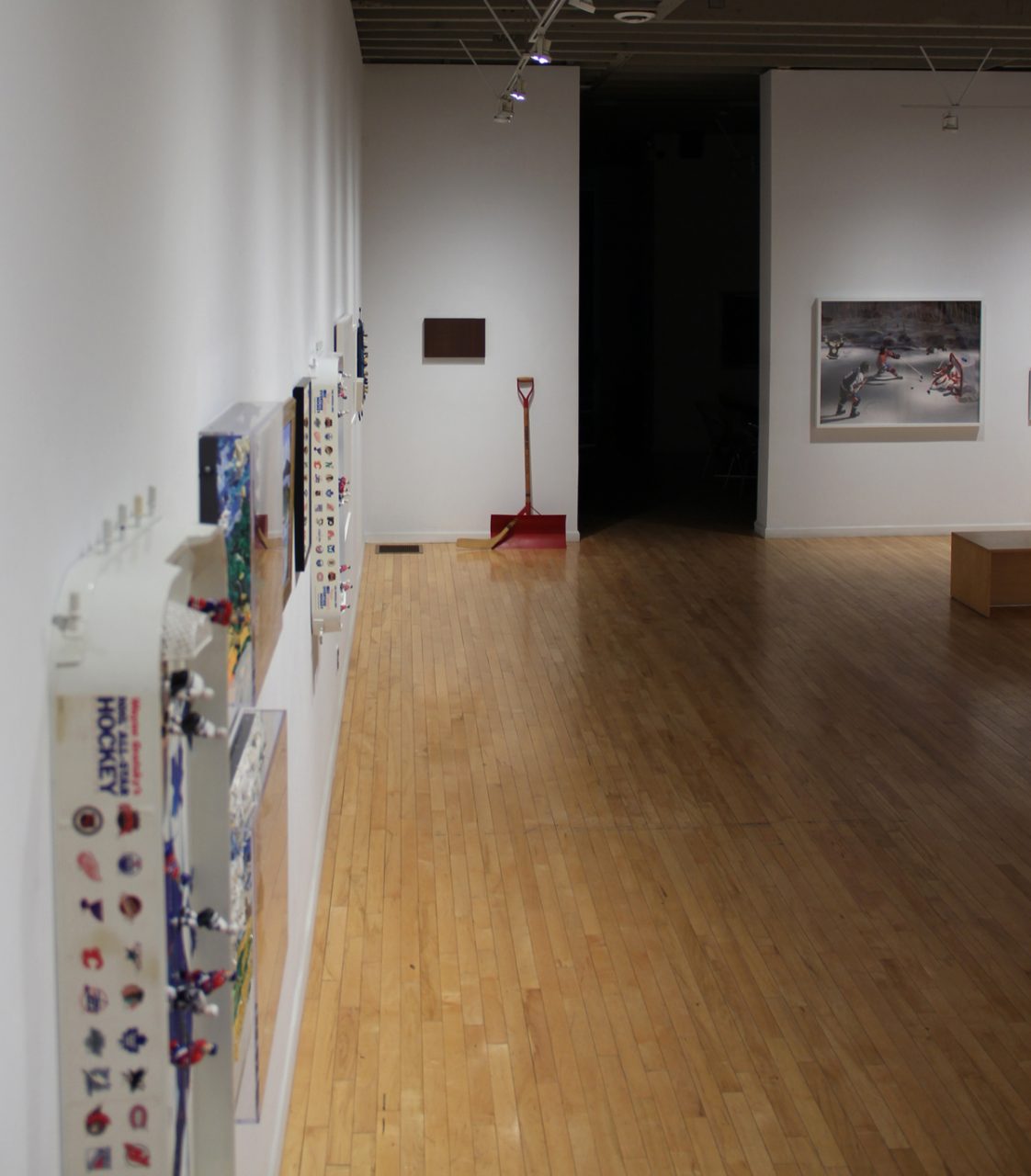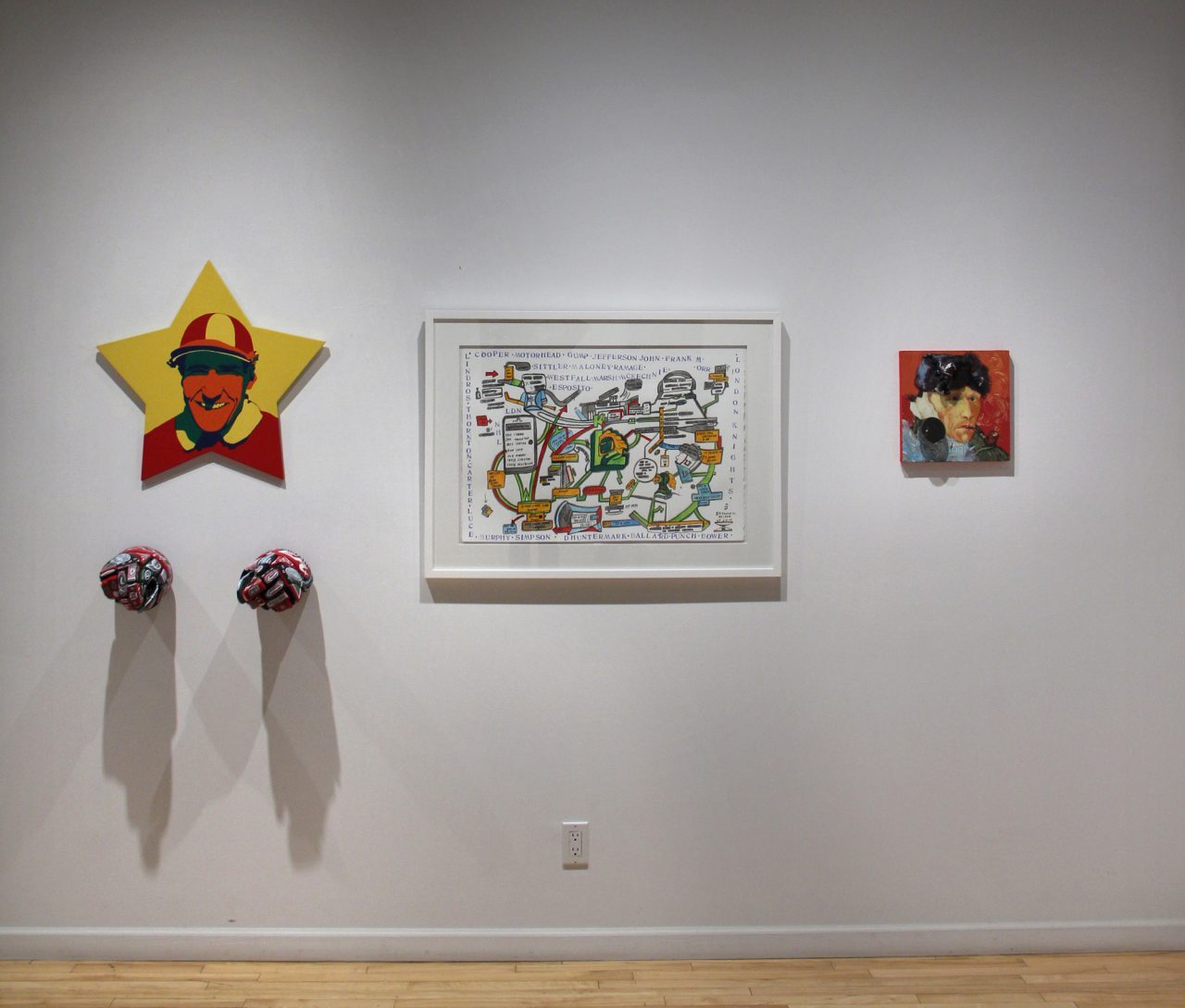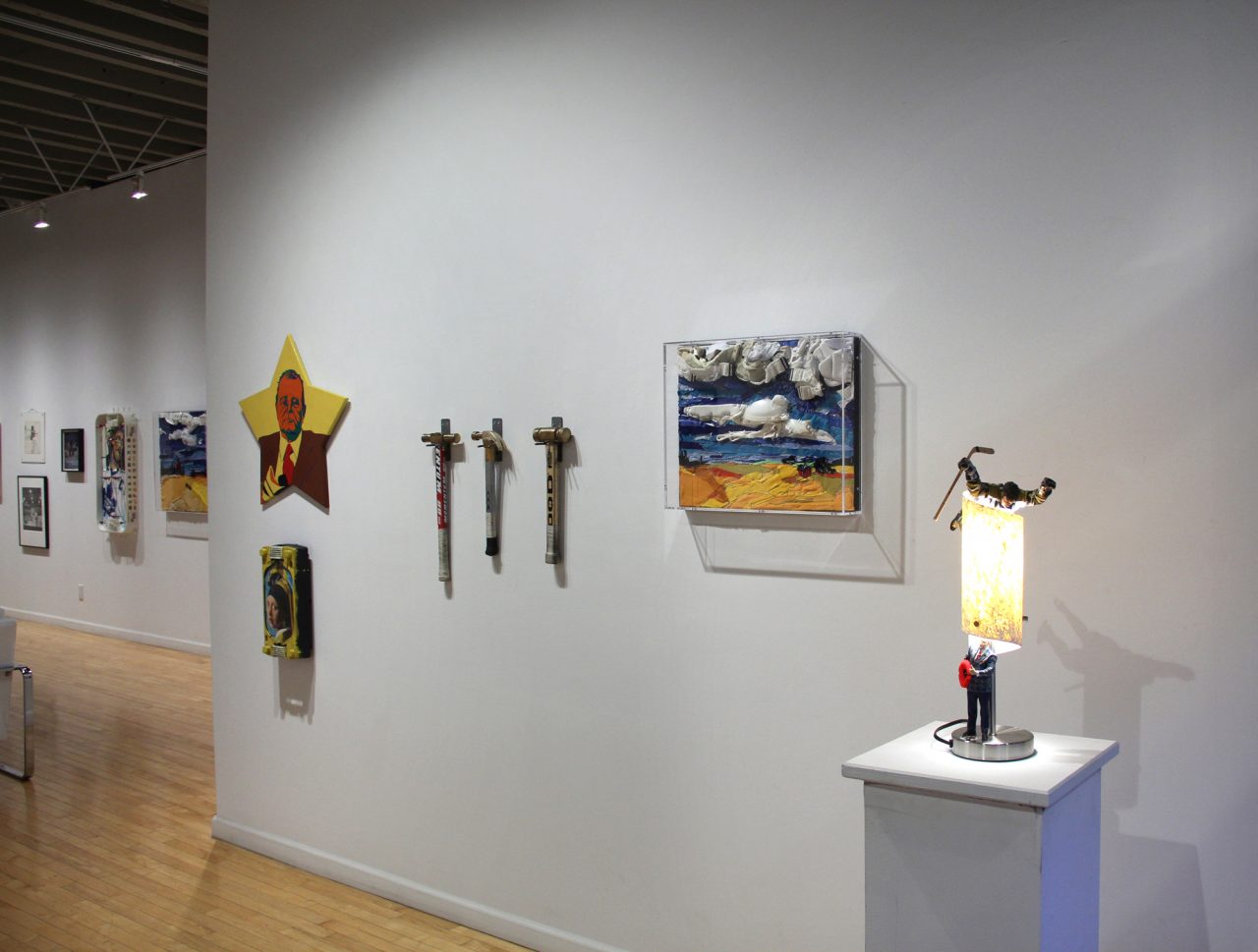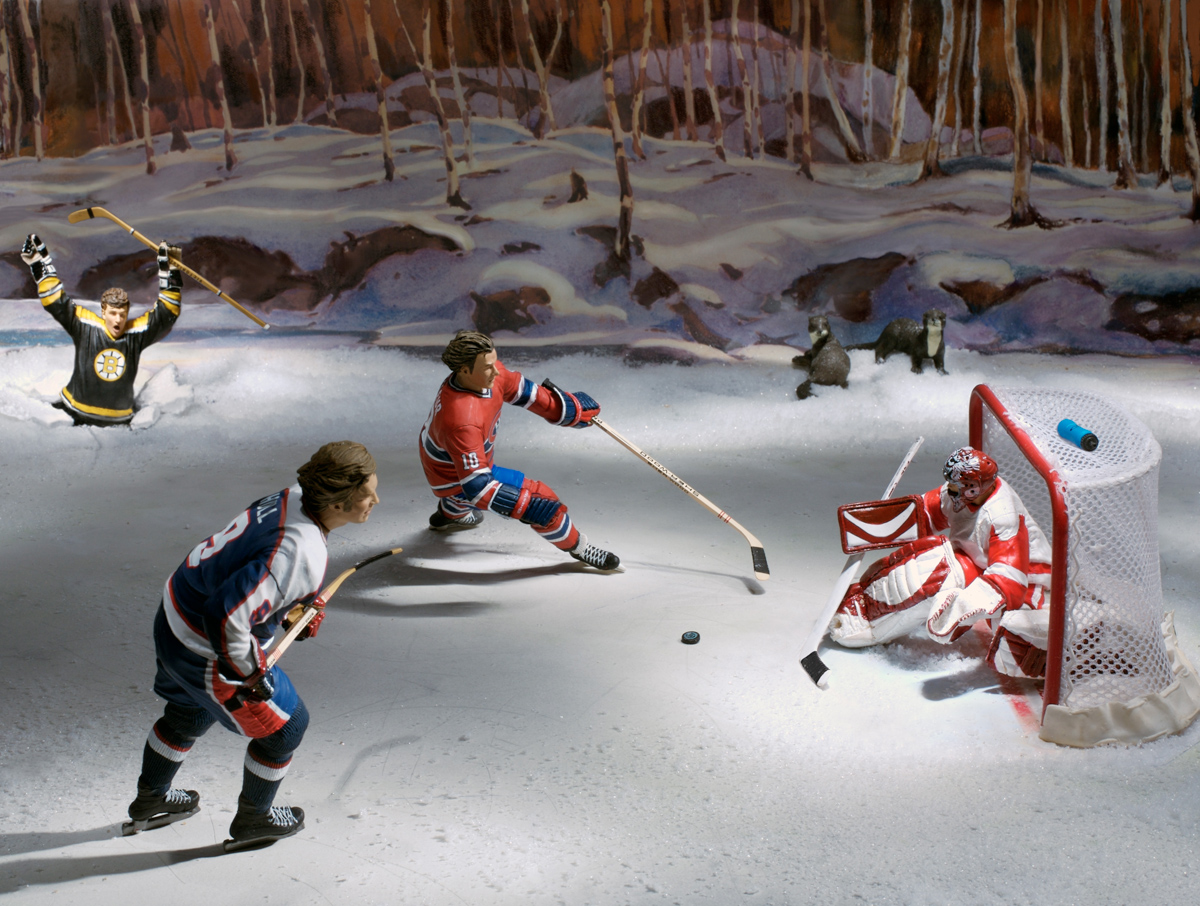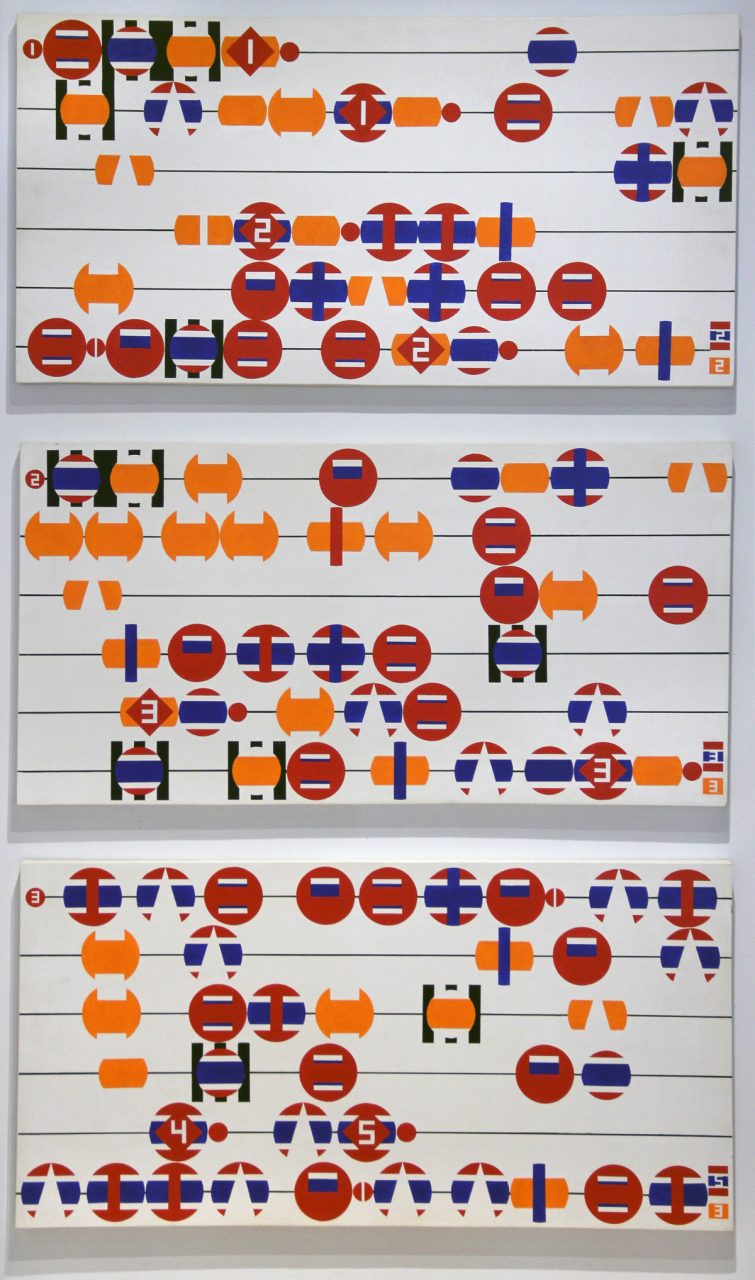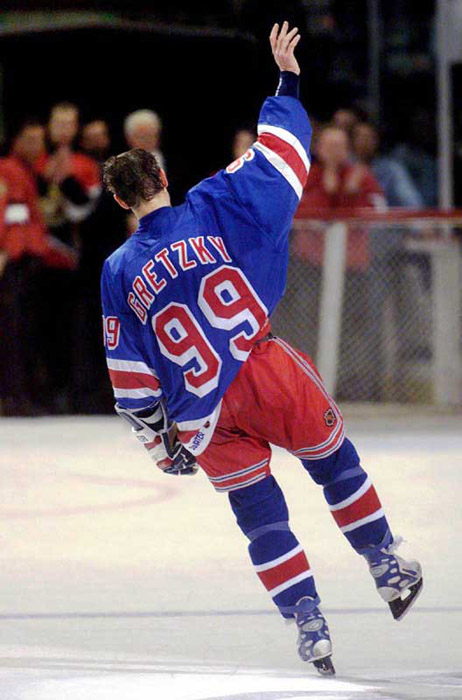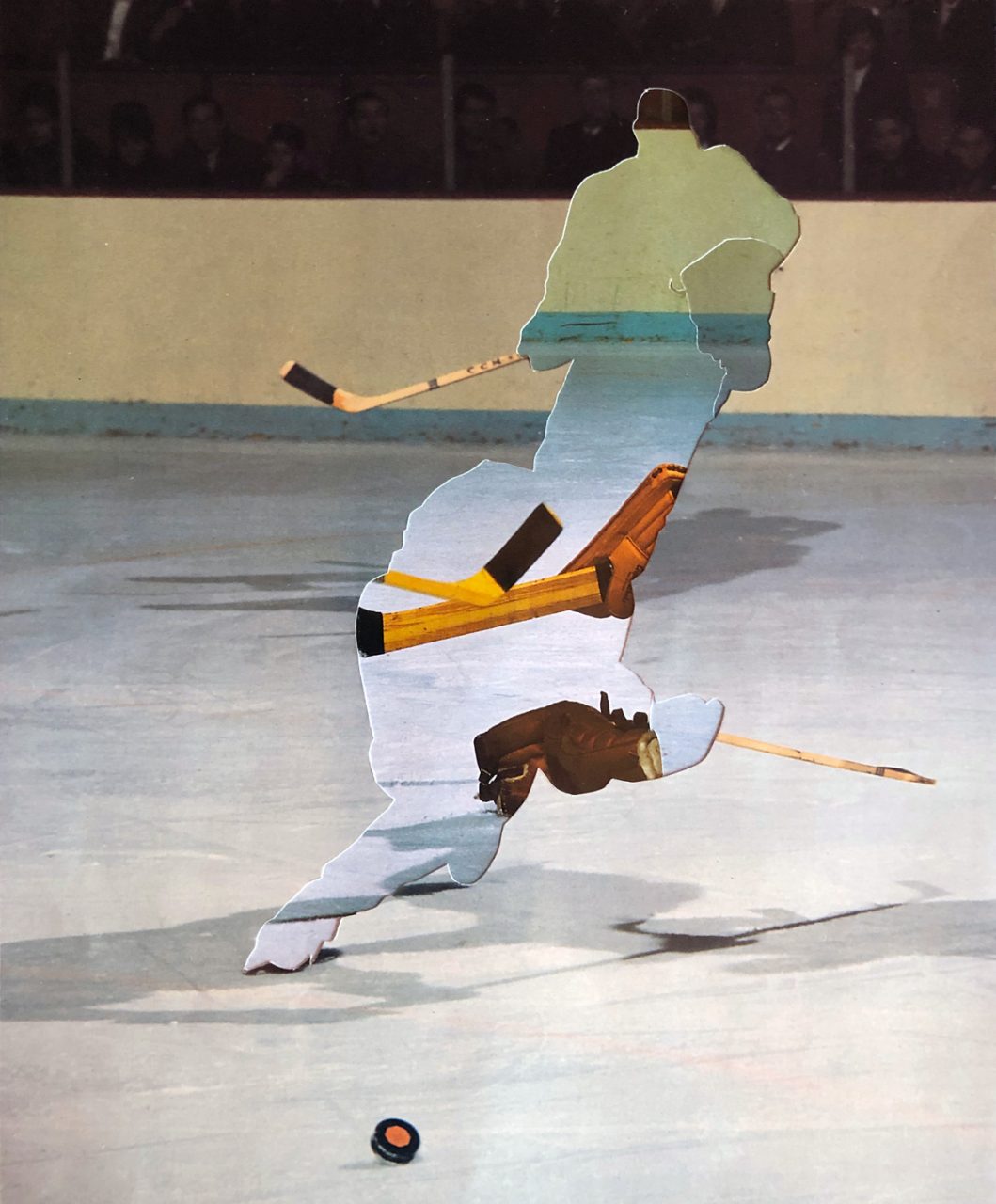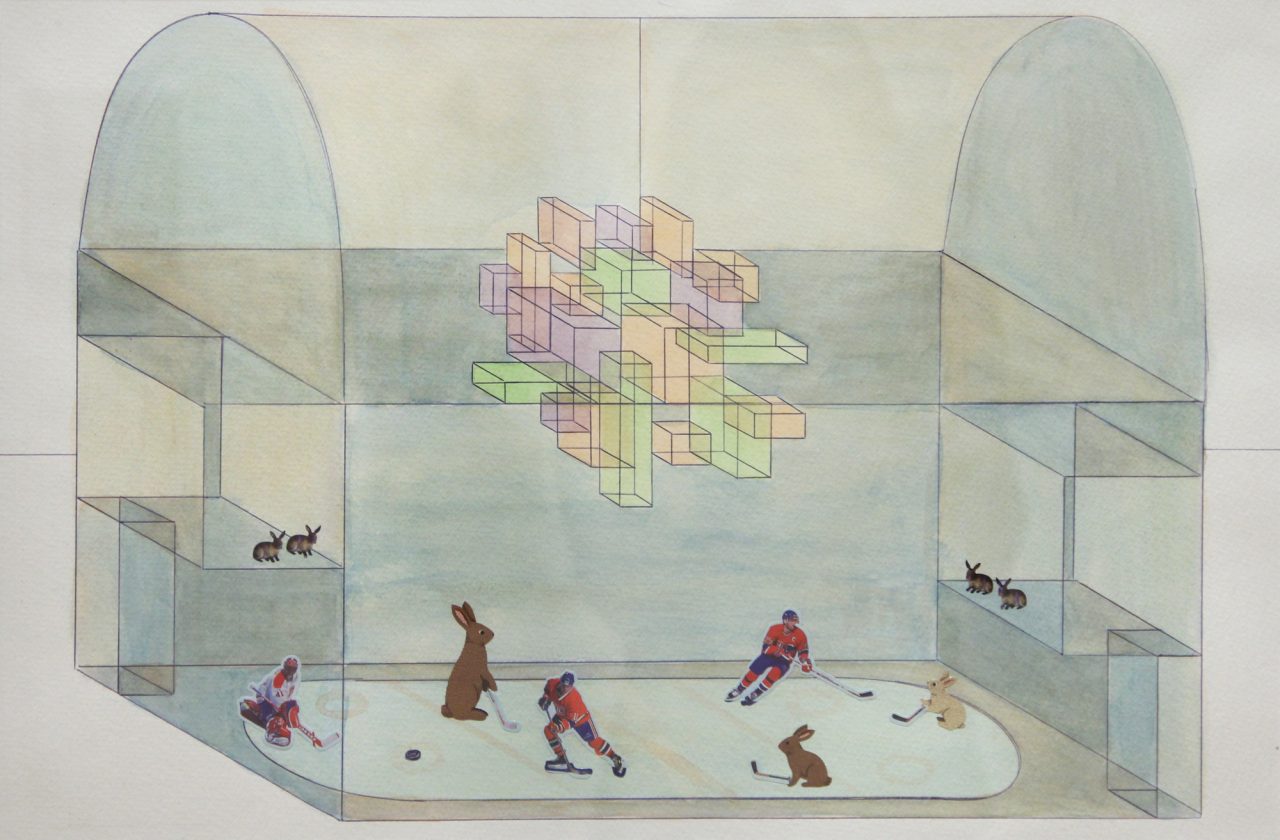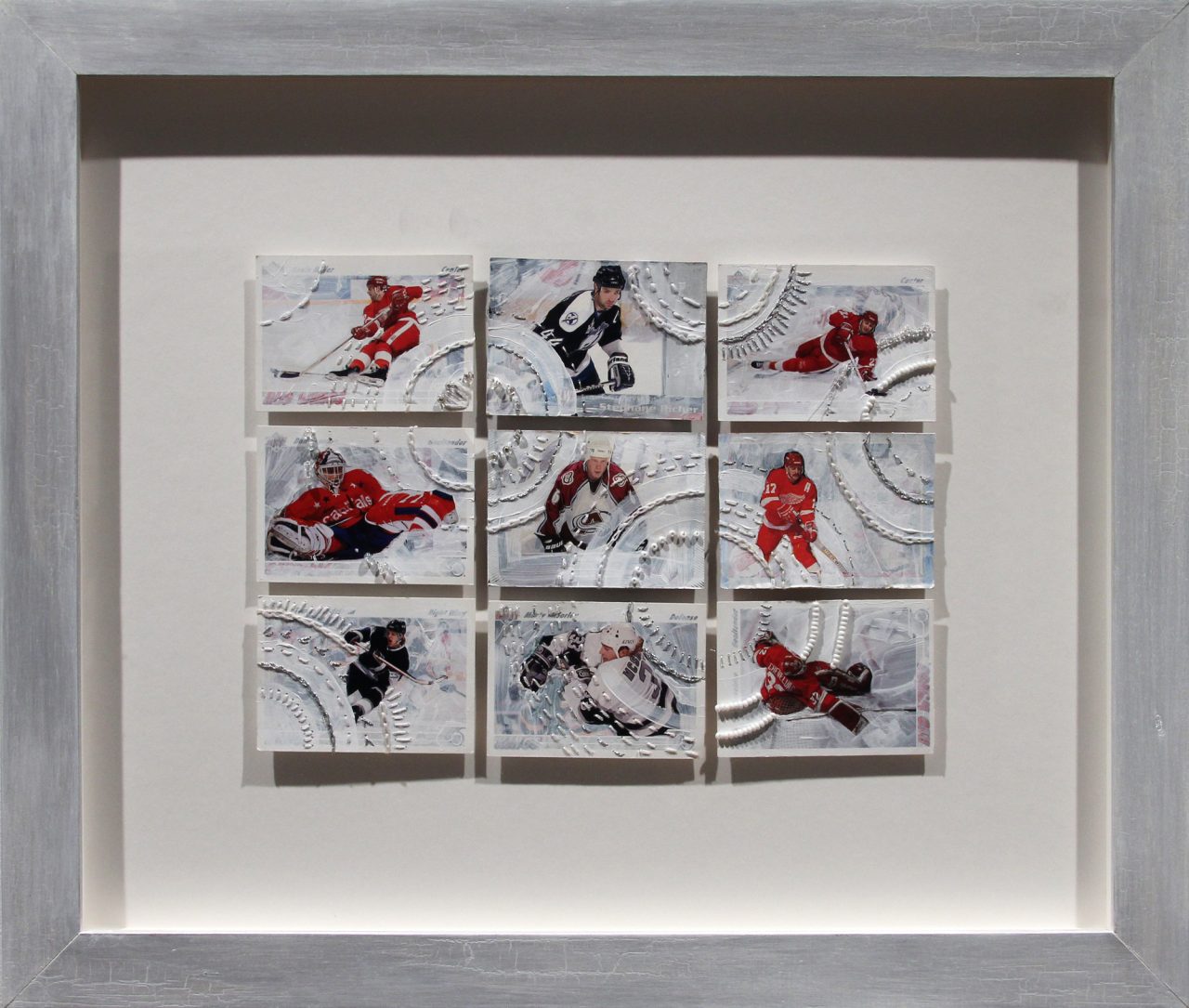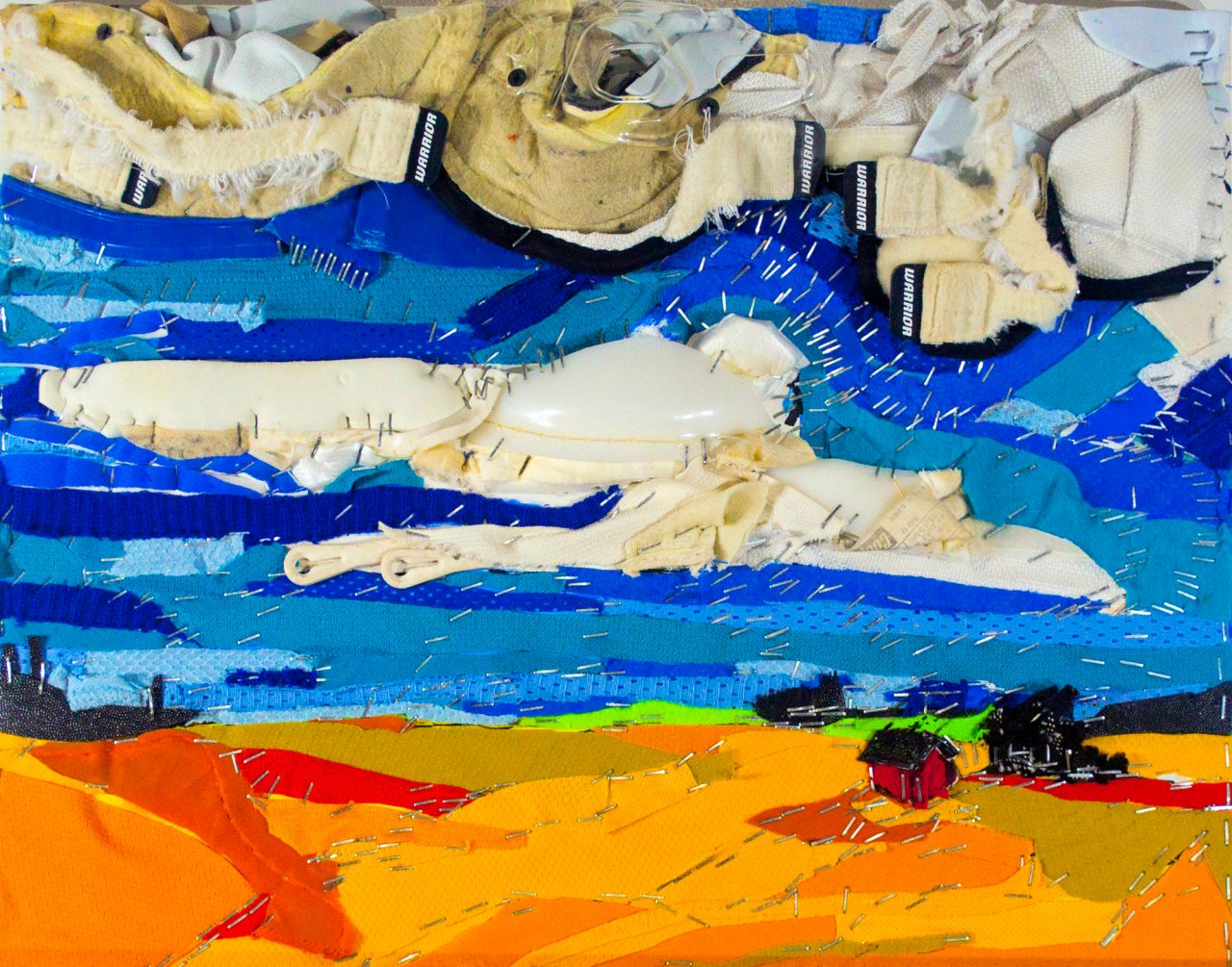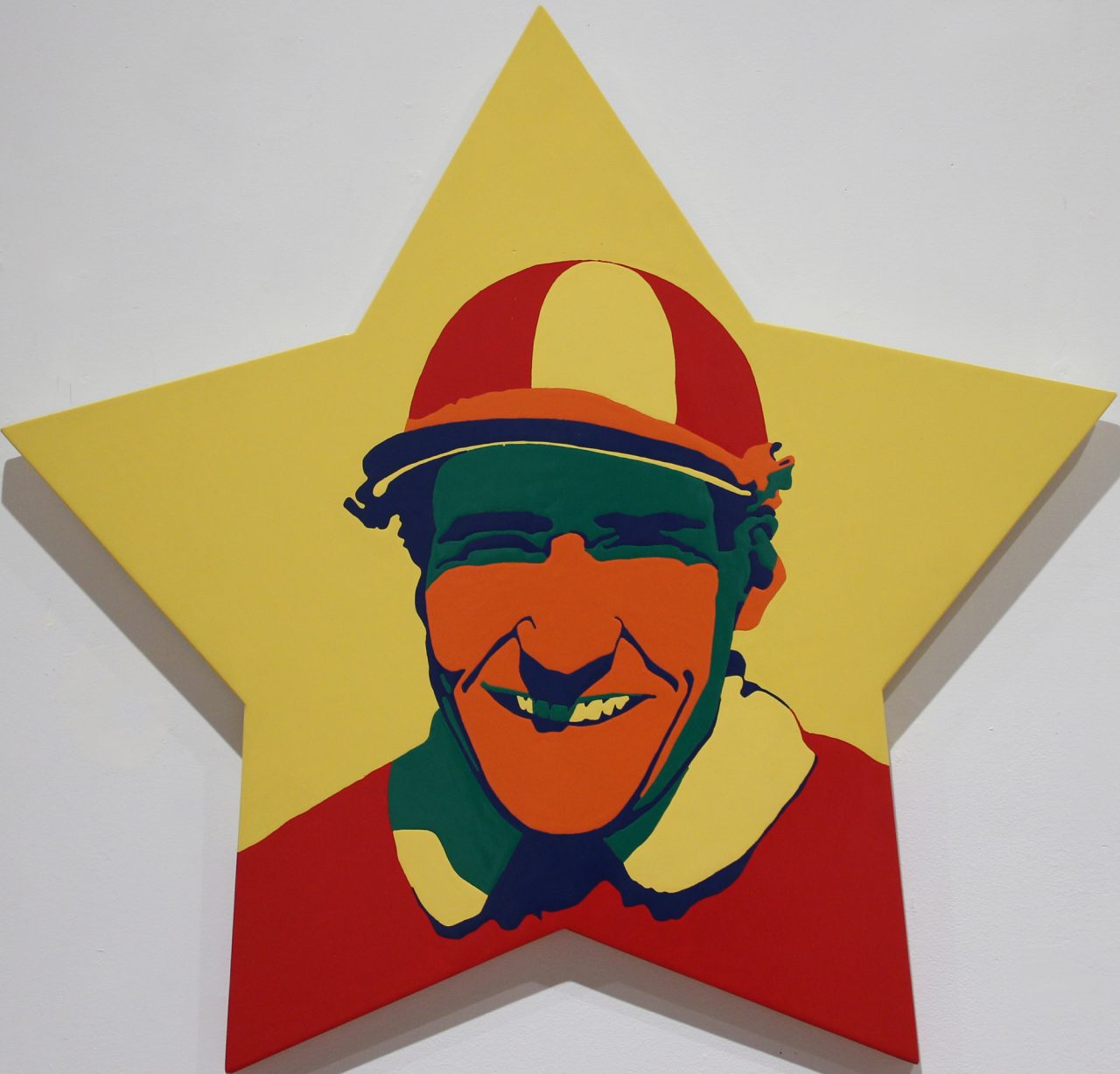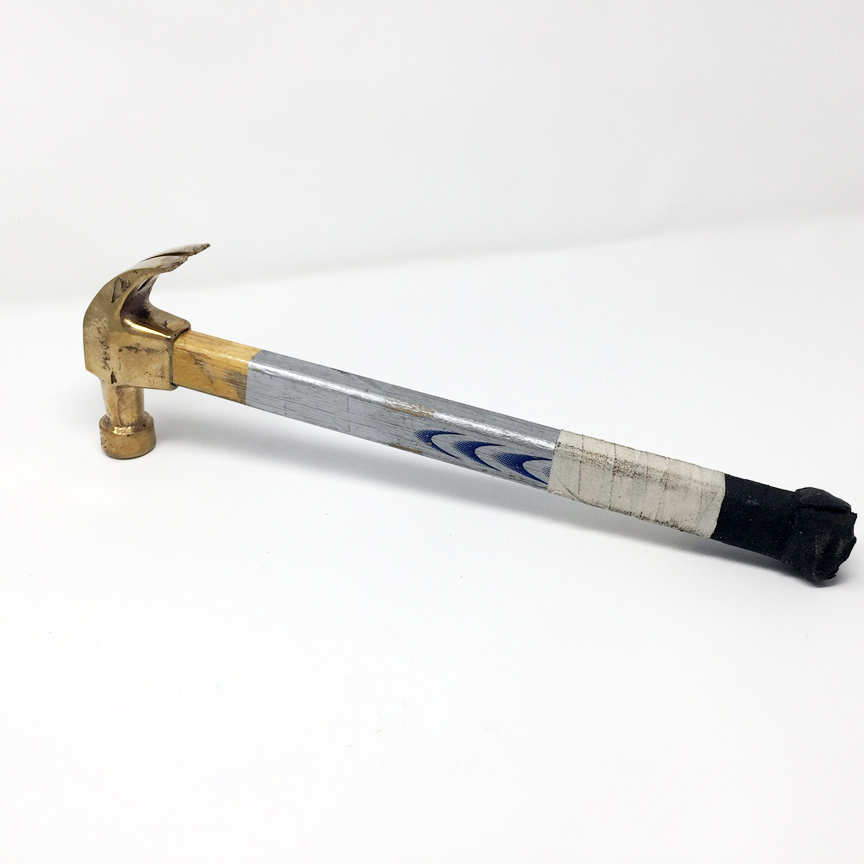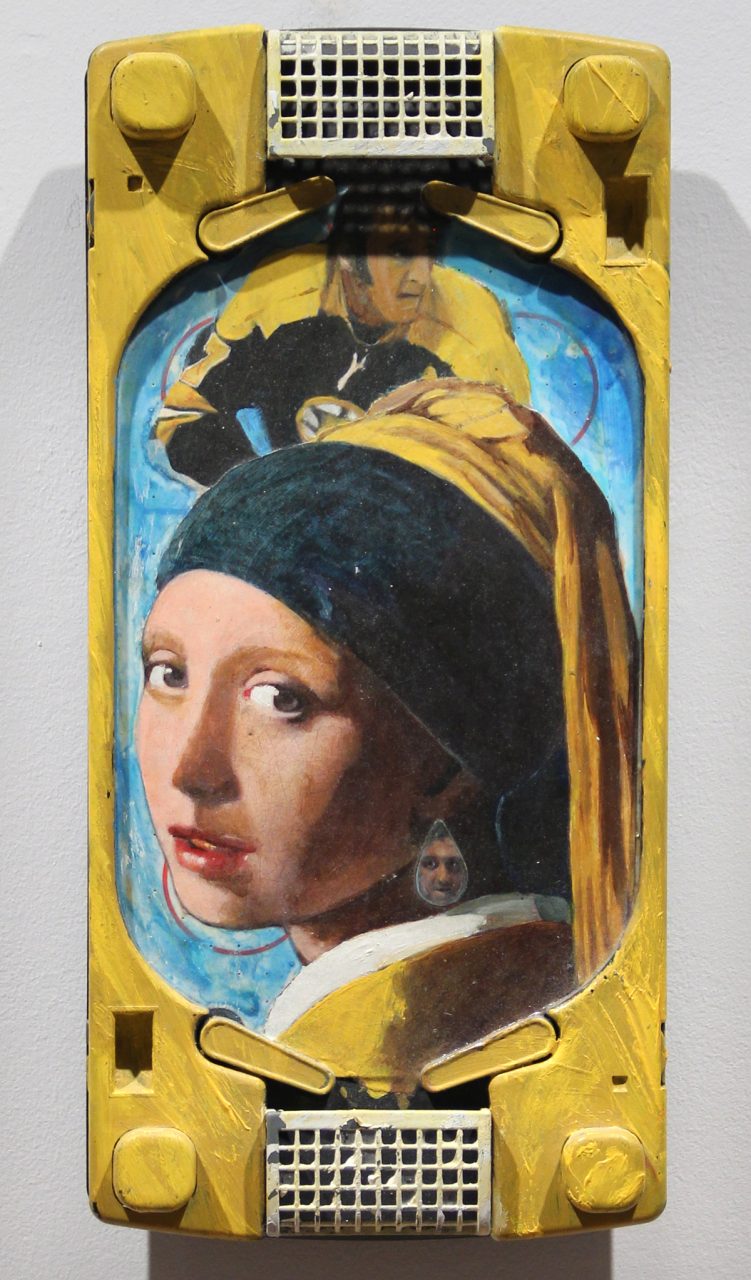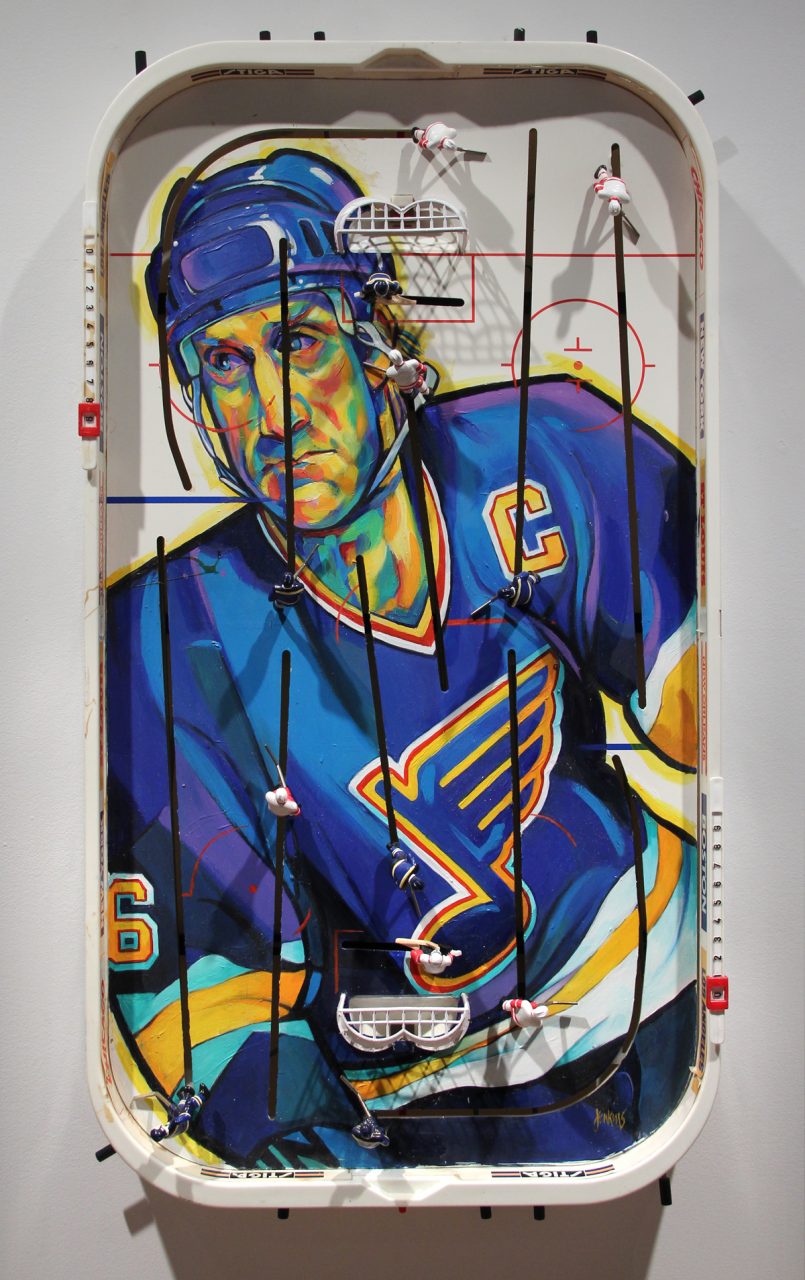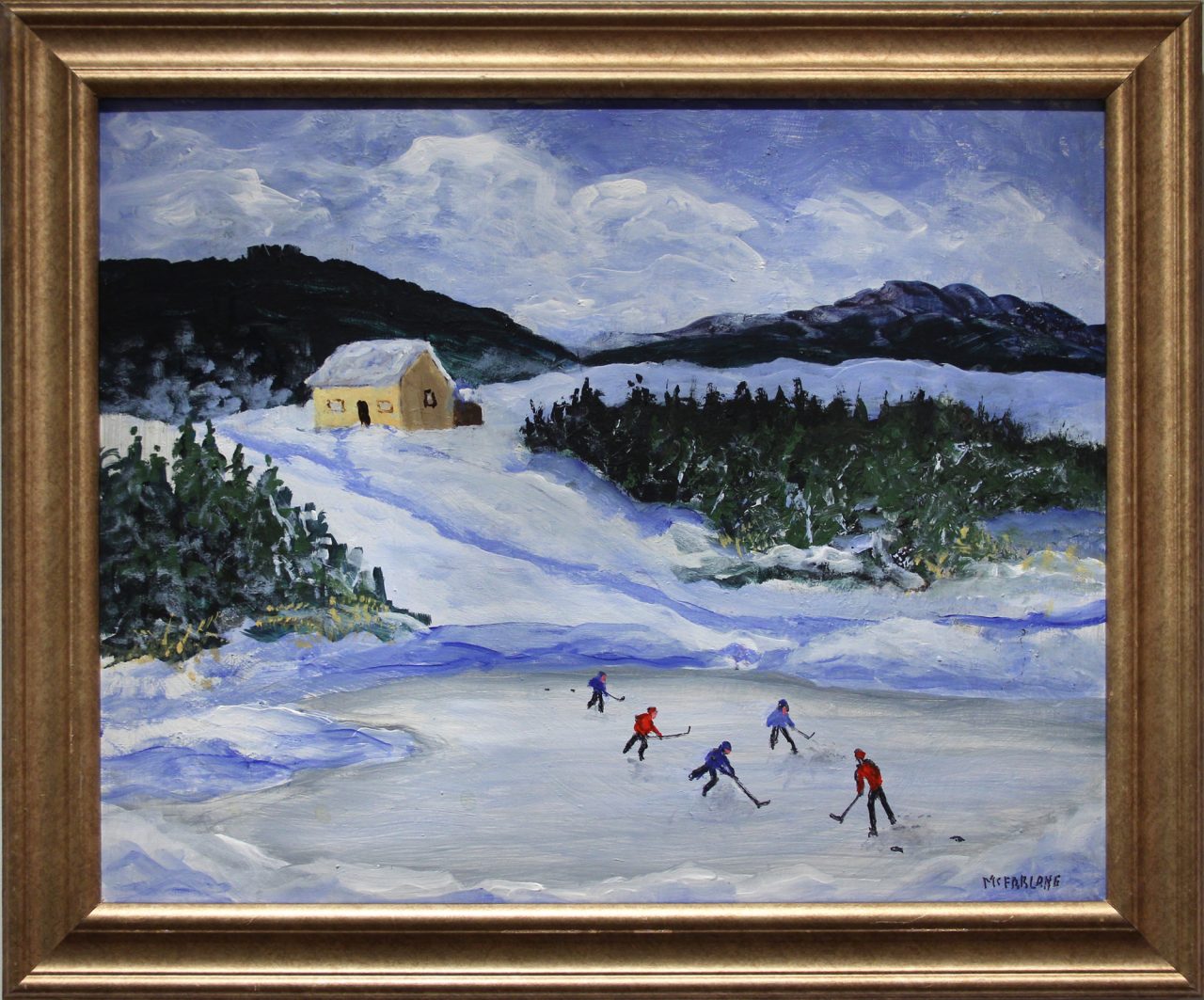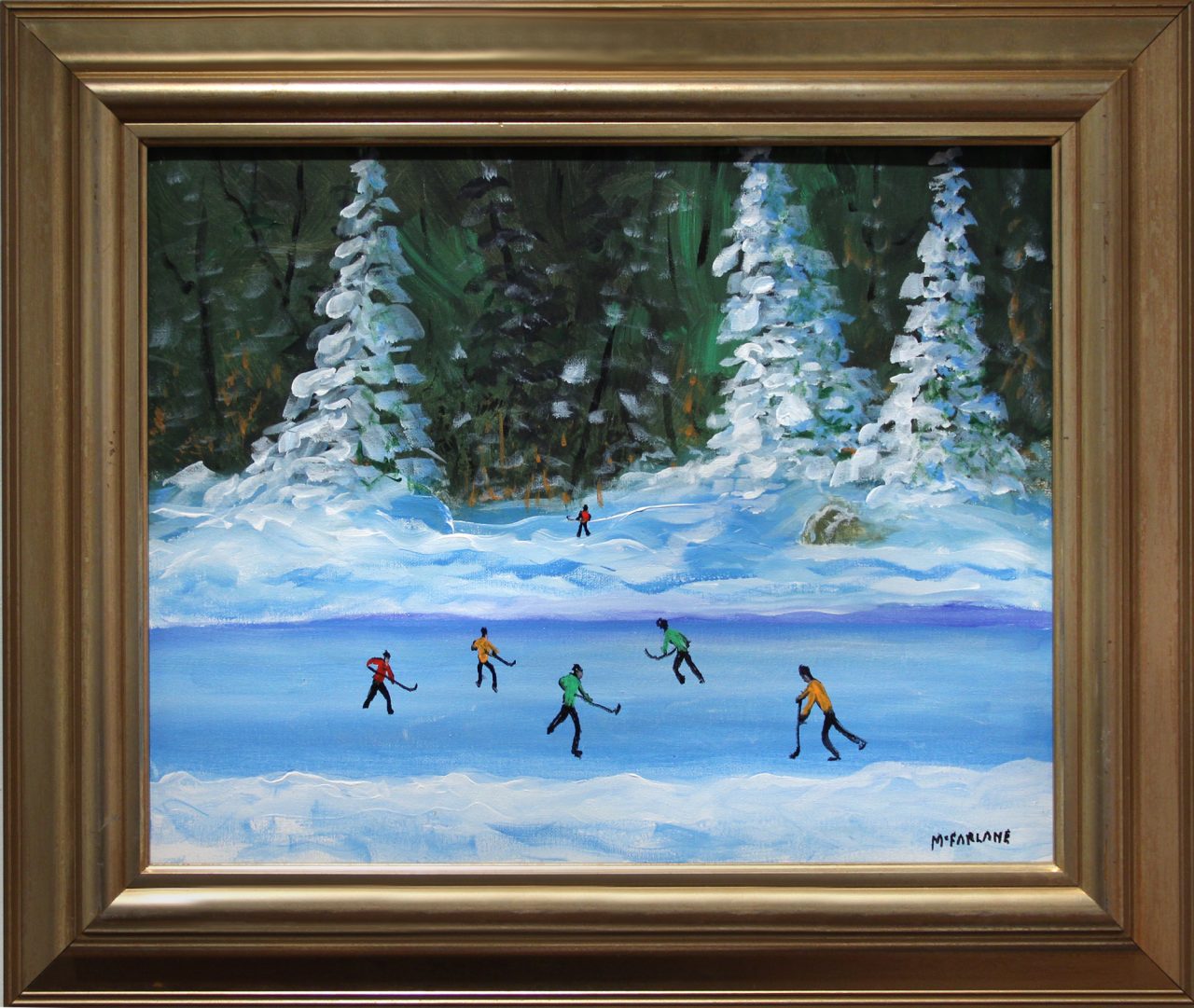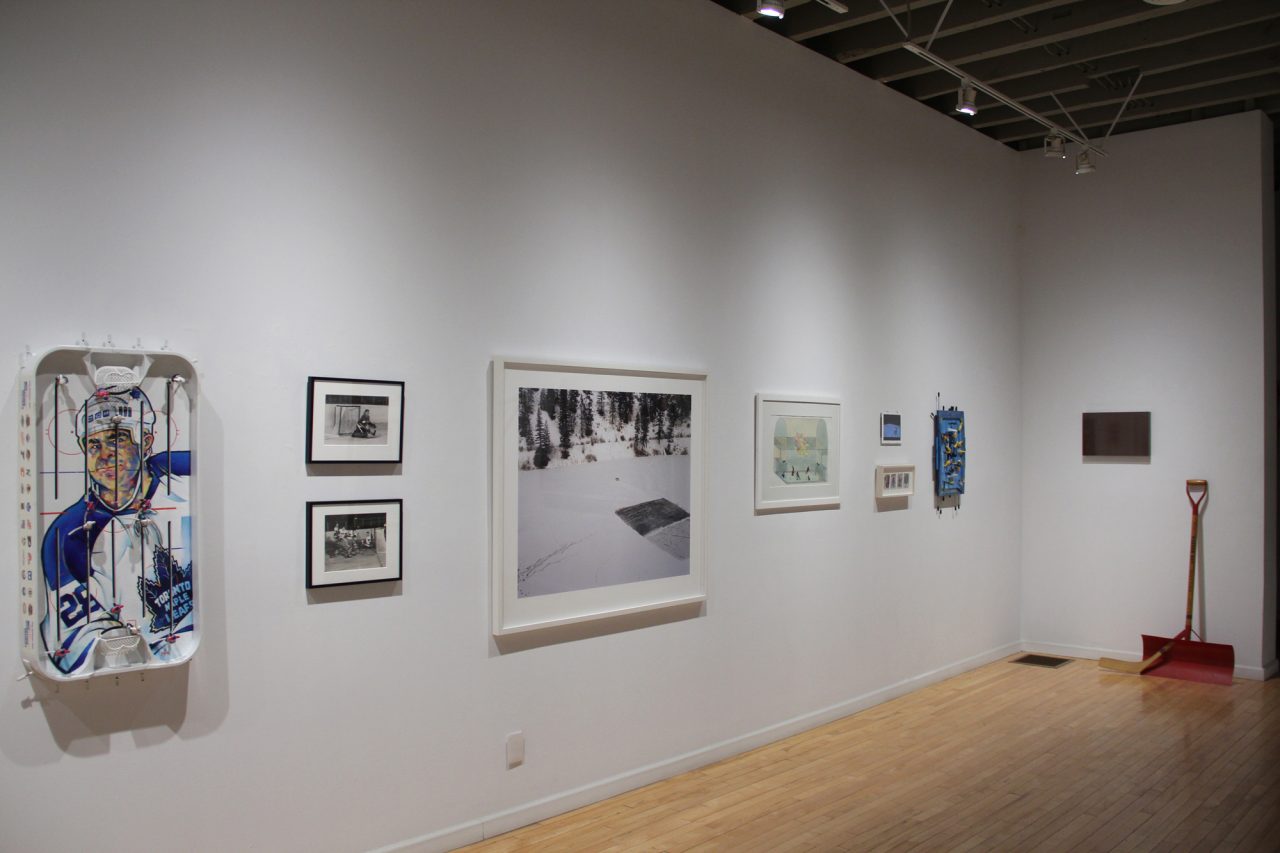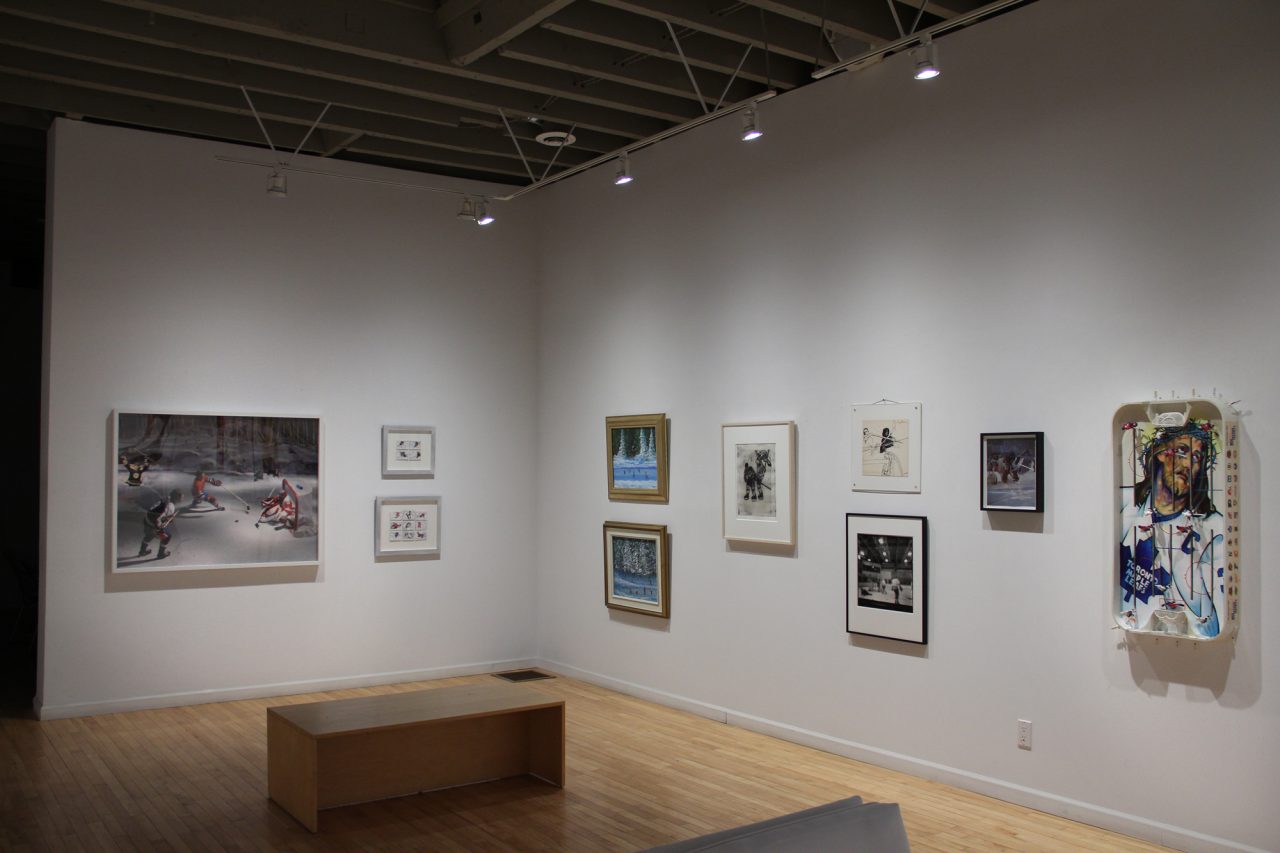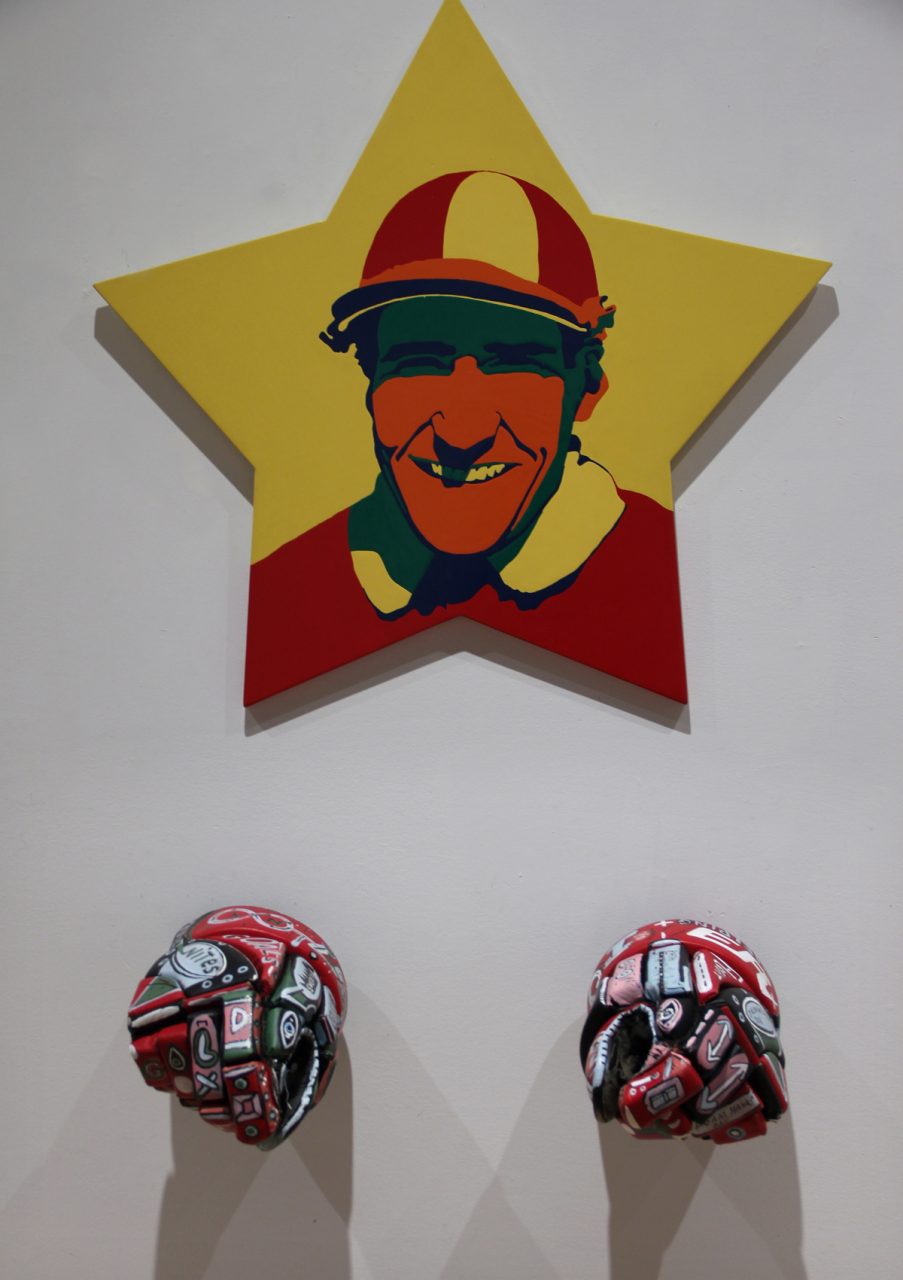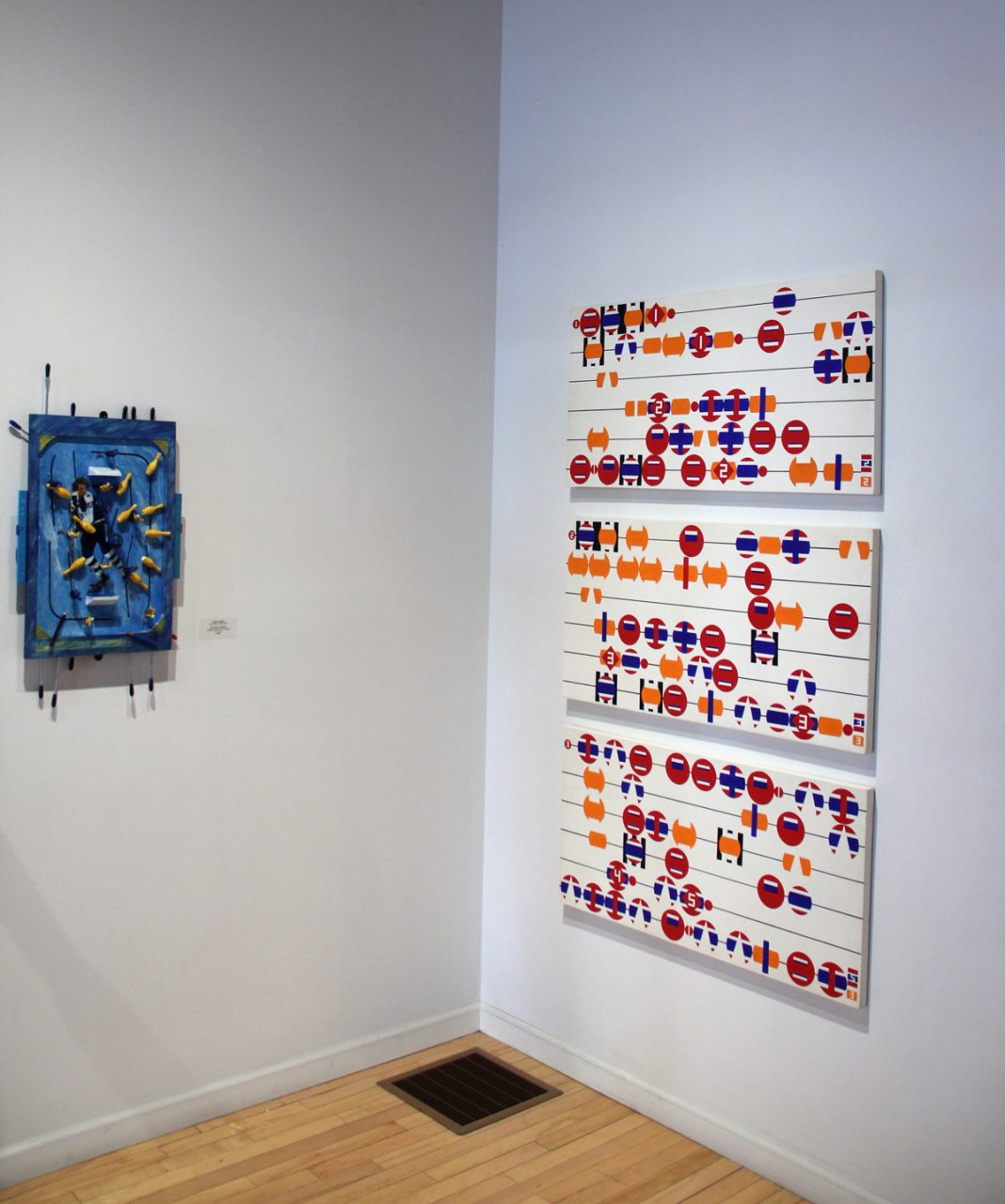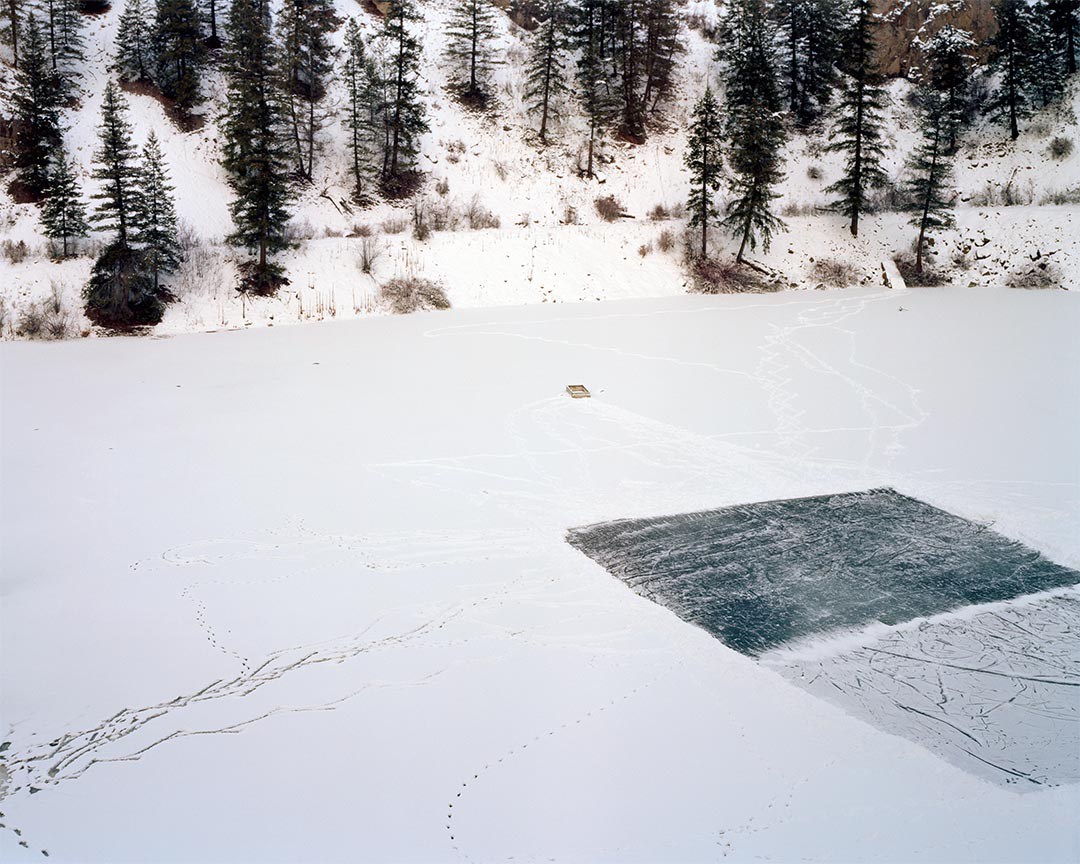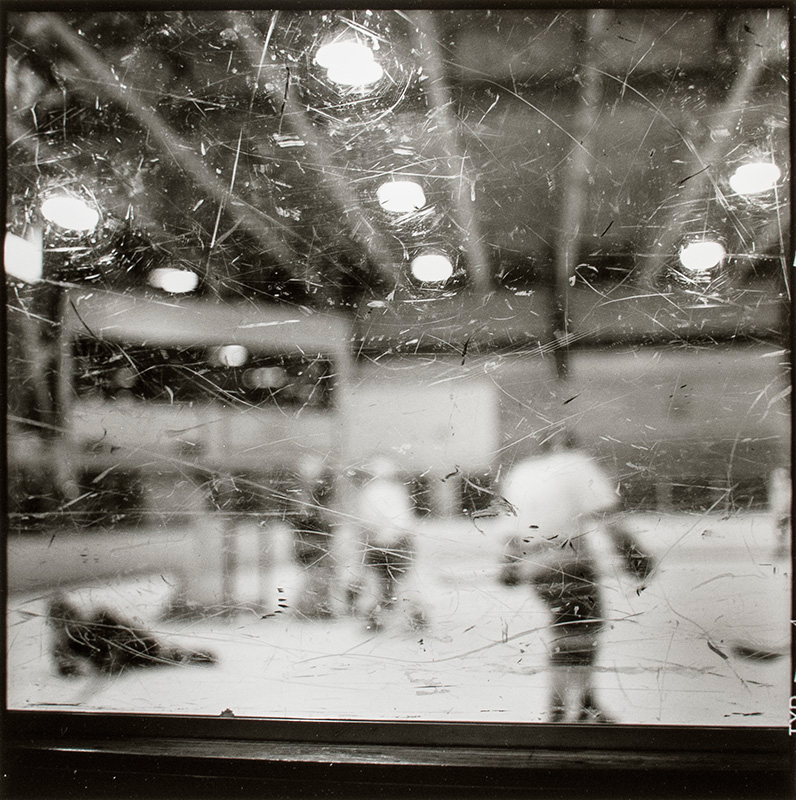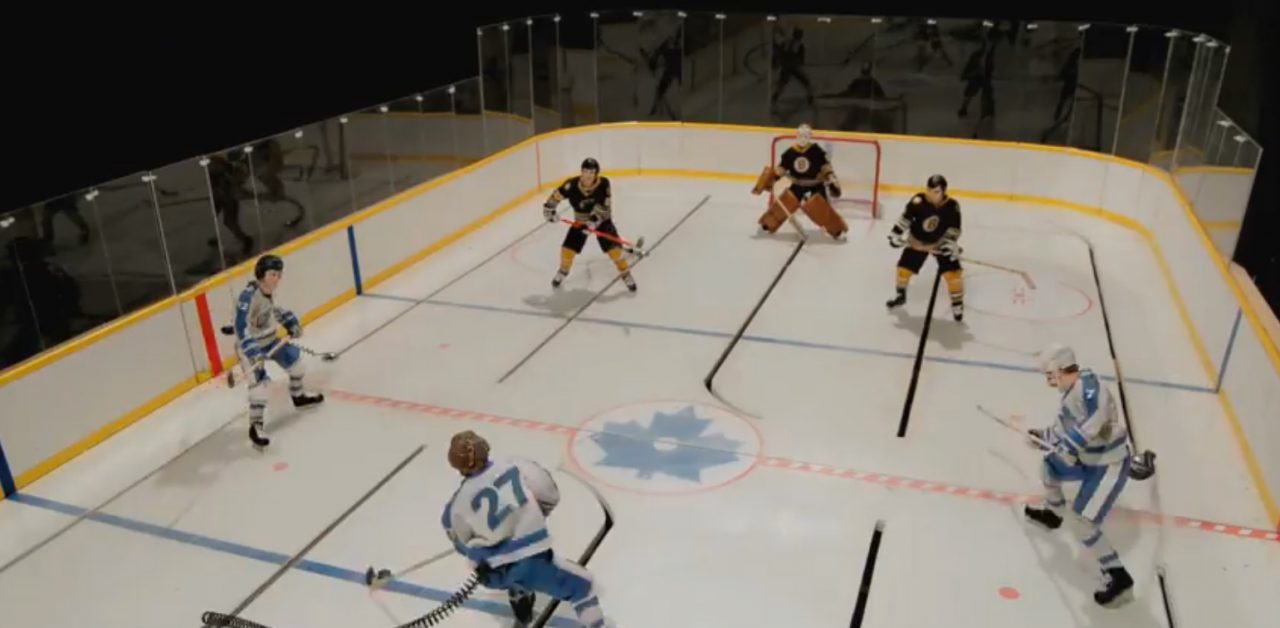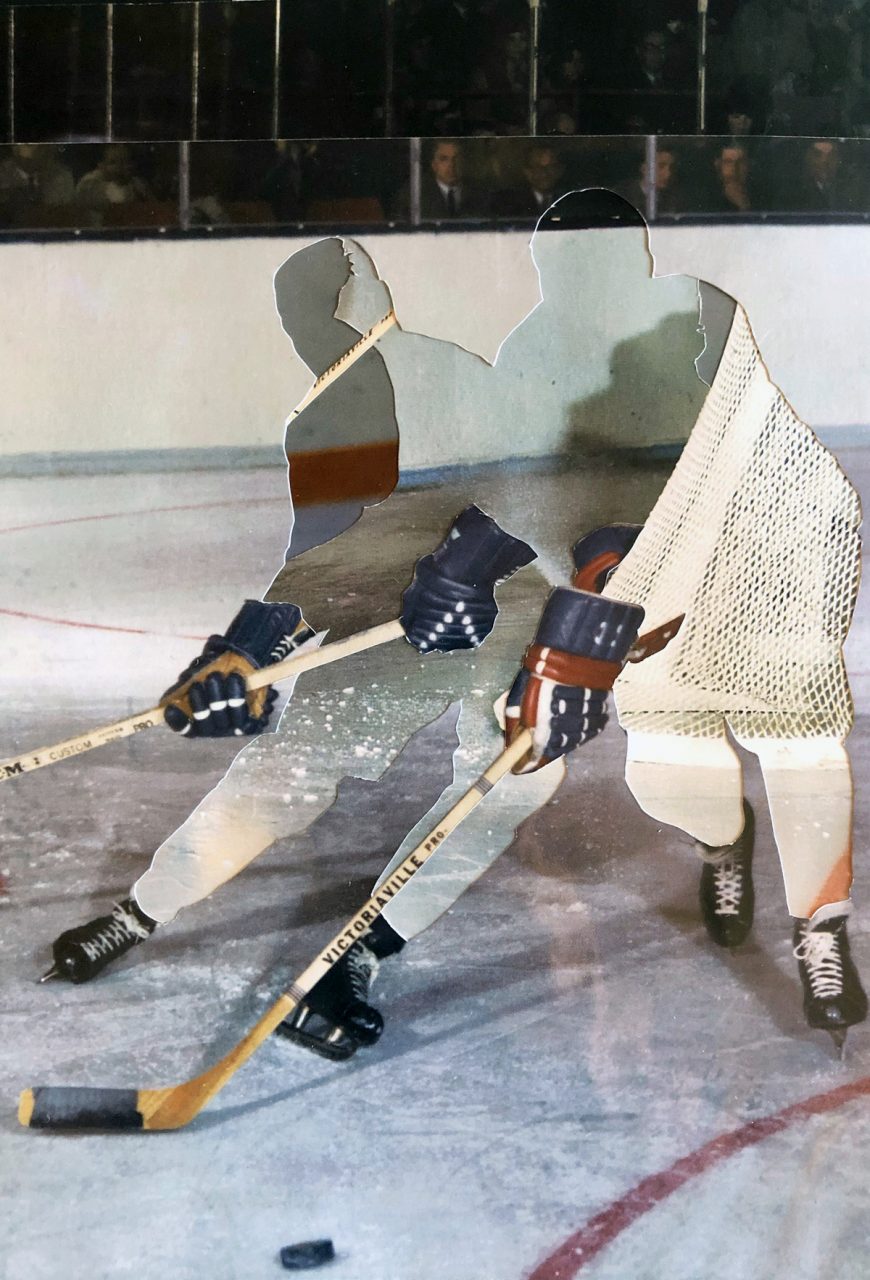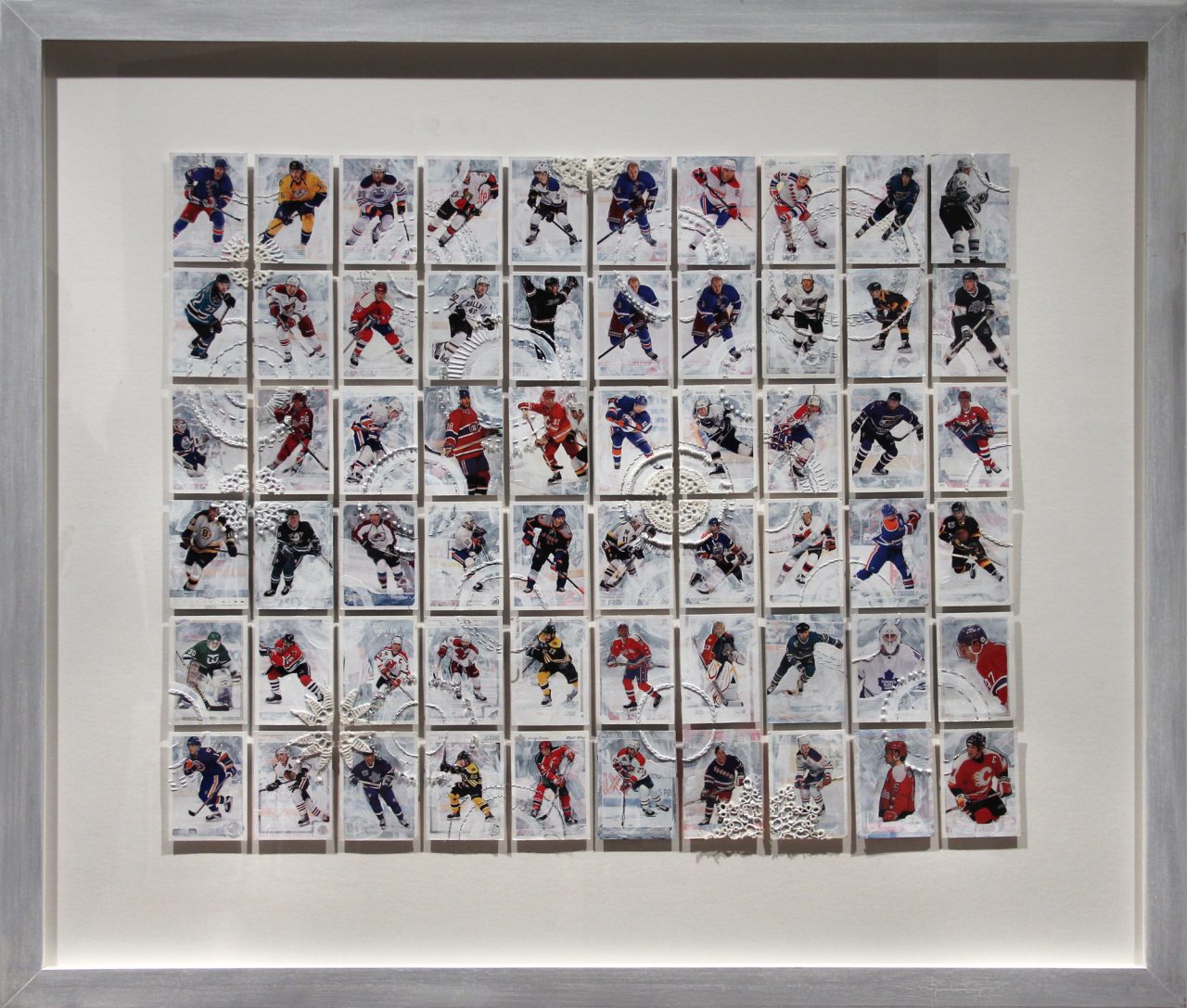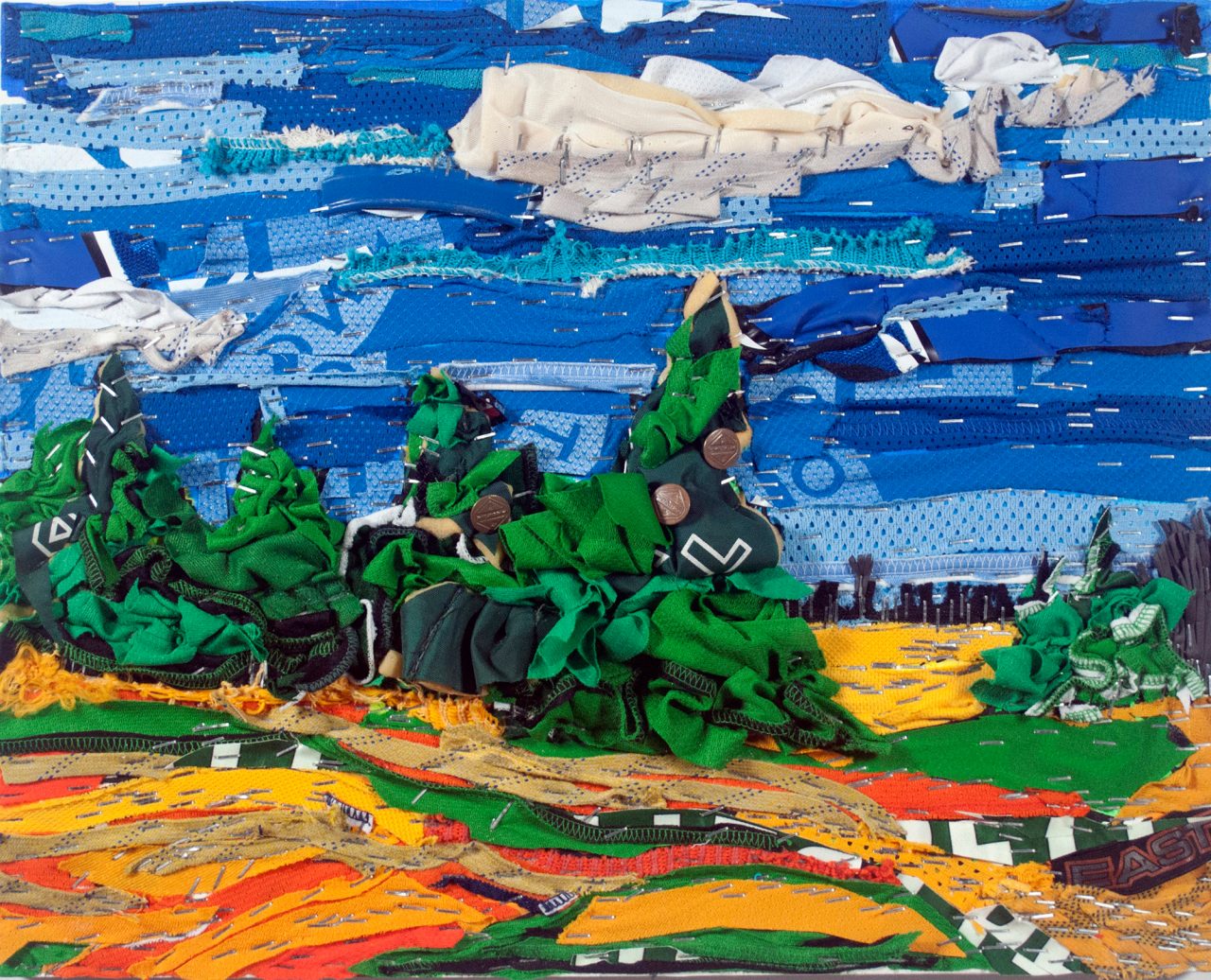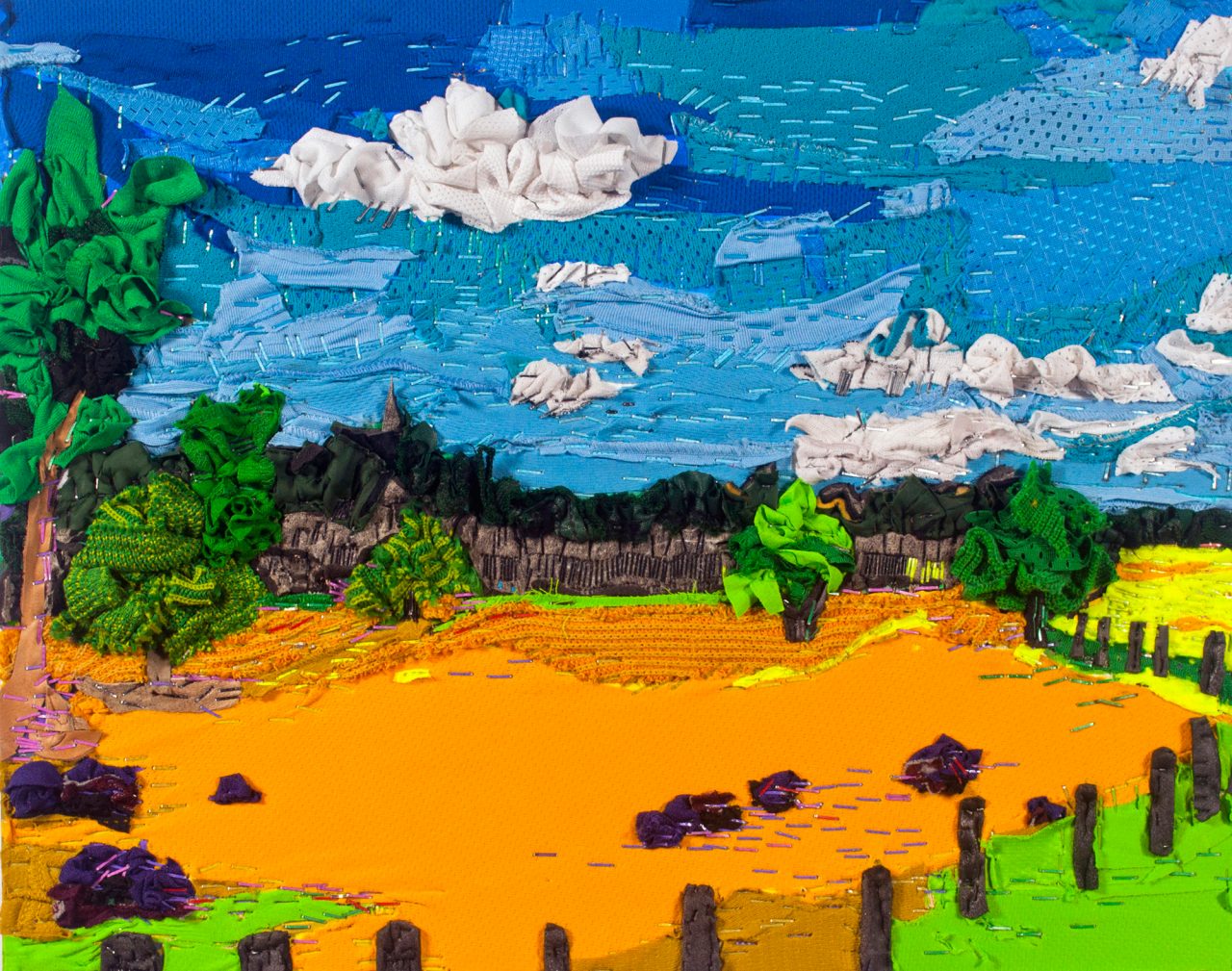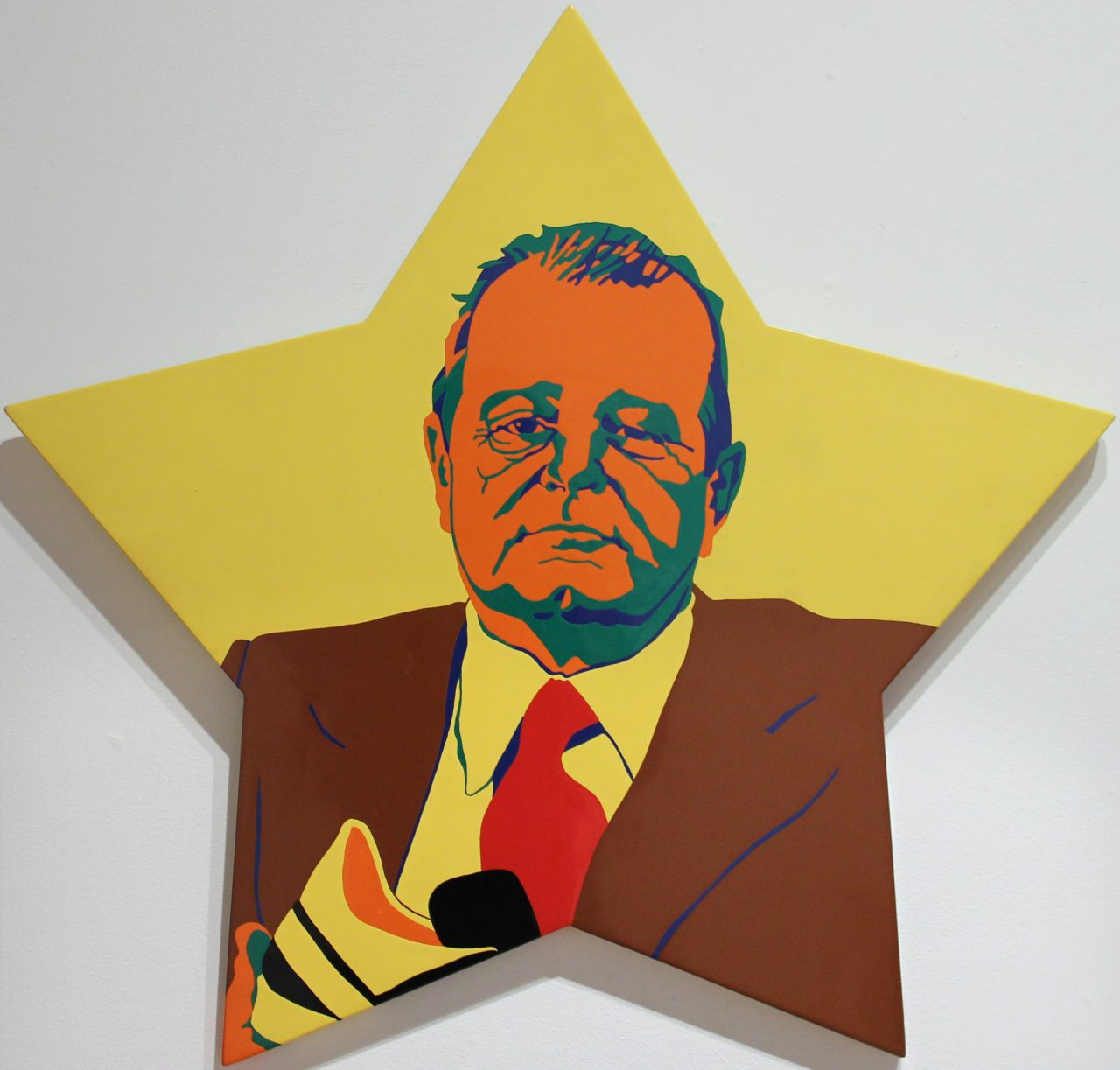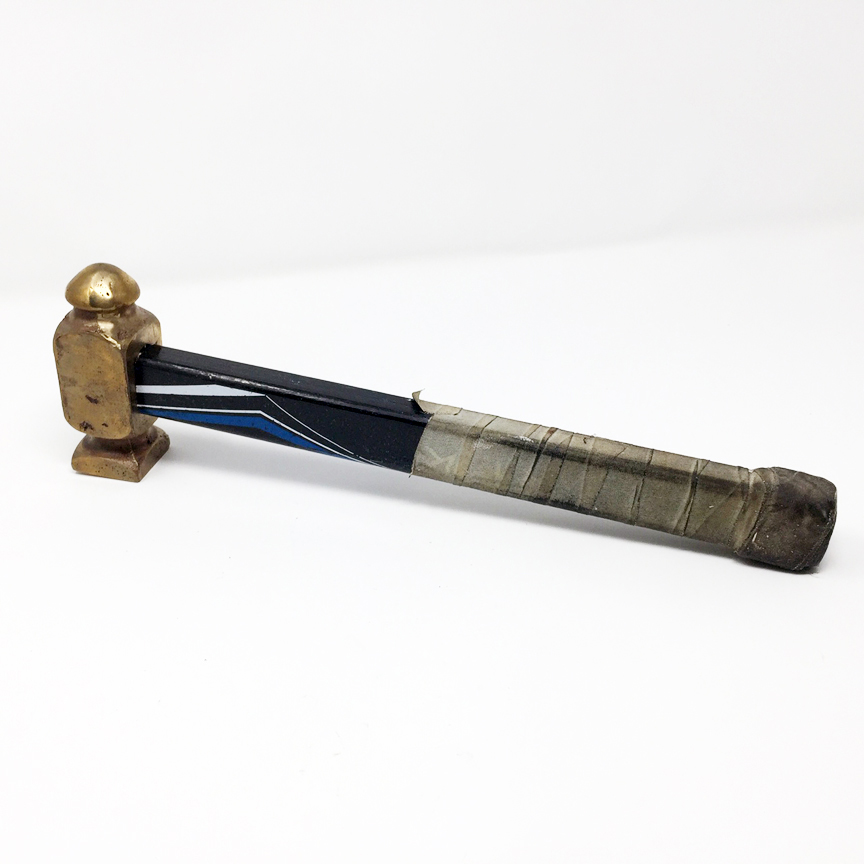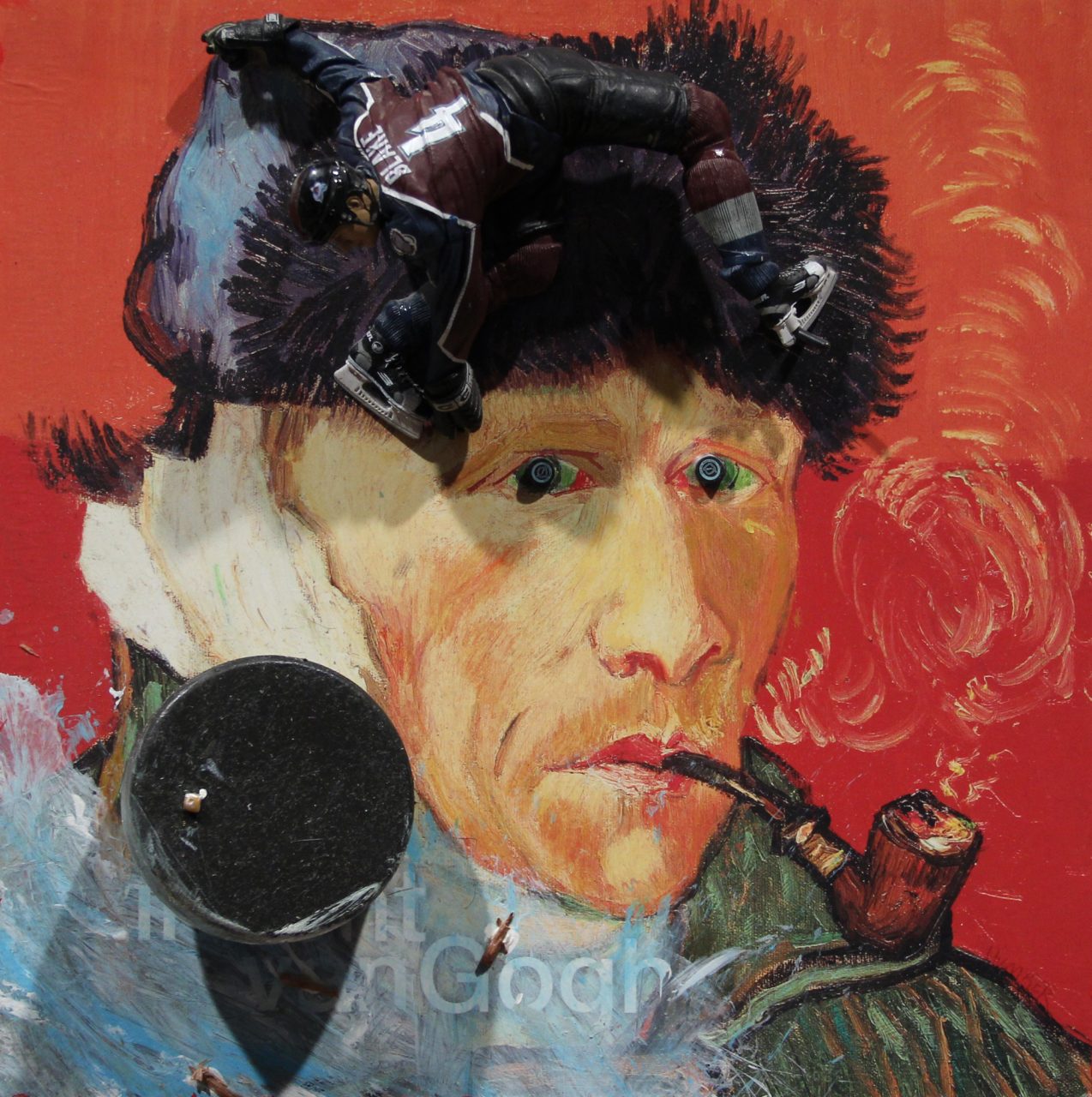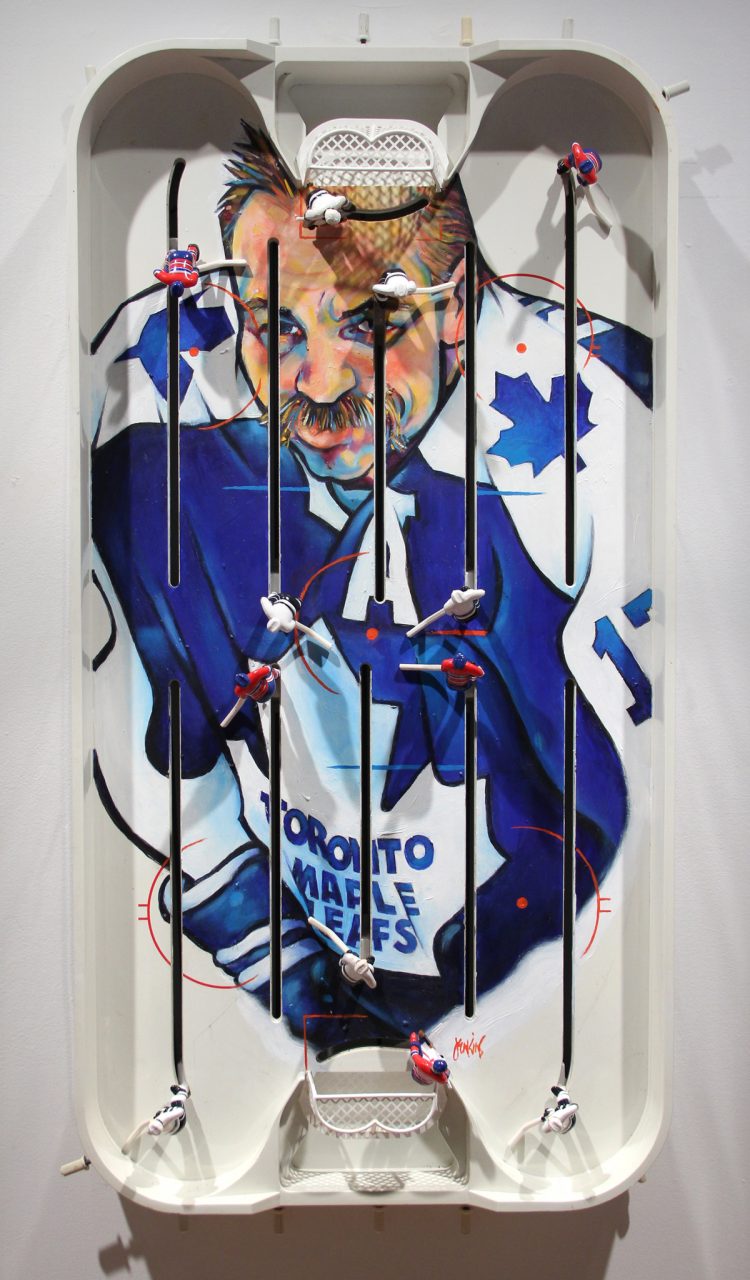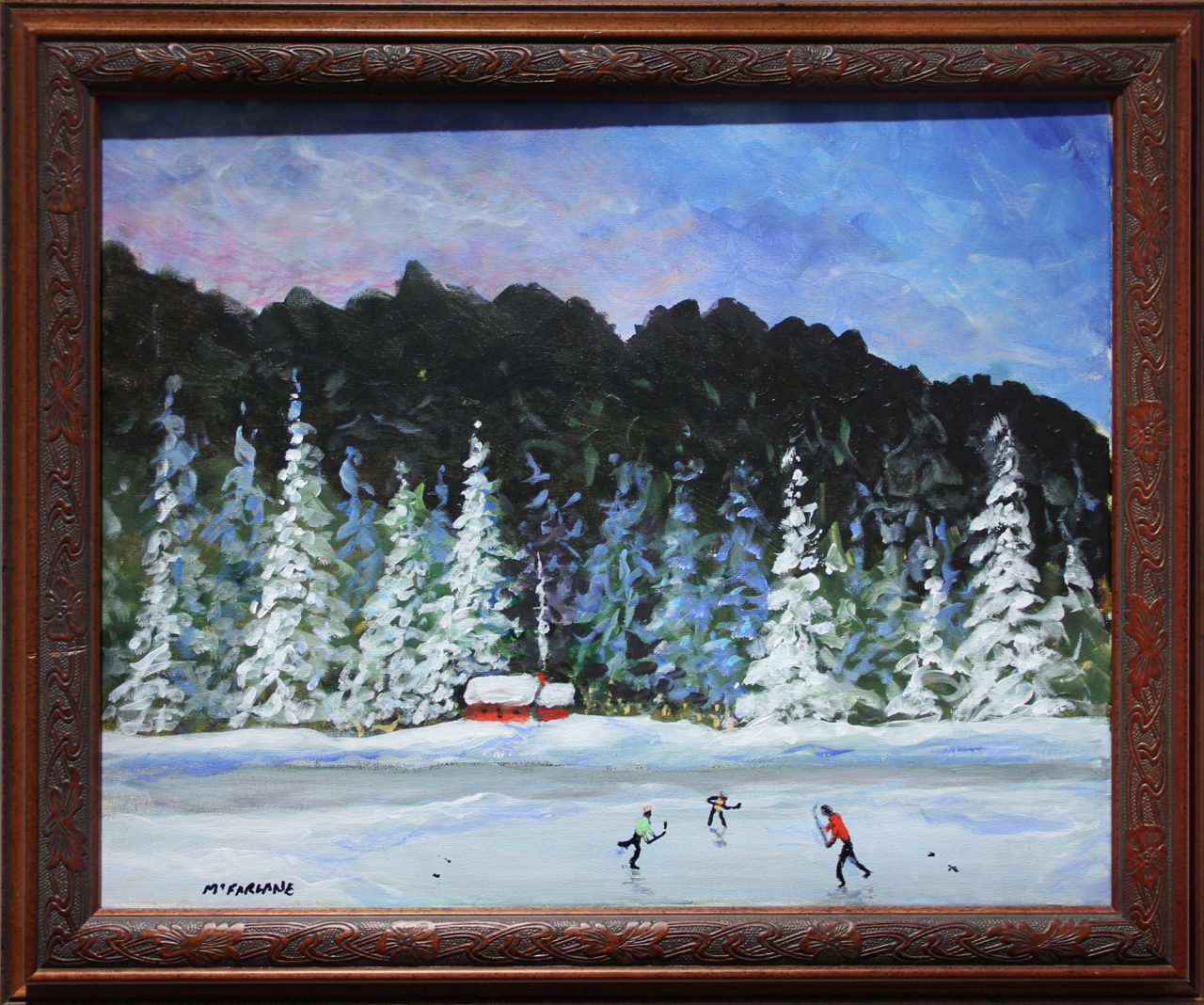The HOCKEY SHOW – November 30 – January 4, 2020
For December we have curated a hockey-themed exhibition featuring the following artists: Bob Bozak, Paul Butler, Greg Curnoe, Fred Chartrand, Scott Conarroe, Ken Danby, Peter Doig, Mauro Fiorese, Simon Hughes, Larry Humber, Anthony Jenkins, Brian McFarlane, Jason McLean, Janet Morton, Graeme Patterson, Liz Pead, Roch Smith, Robyn Thomas, Diana Thorneycroft, The Turofsky Brothers and Jack Whyte.
I have wanted to curate a hockey show for some time. It could be argued that hockey is the glue that holds Canada together. Hockey Night in Canada is such an institution coast to coast and has impacted multiple generations of families, small towns and cities. Londoners are either Detroit Red Wing or Toronto Maple Leaf fans, which makes us unique.
Connecting original art with such a beloved sport is perhaps an art in itself. I took to skiing more than hockey, so I never considered myself a “hockey guy”. Maybe this qualifies me to be objective and to have an open mind to what is “hockey art”. I have curated this exhibition by connecting to the world of artists who are interested in images of hockey. Most also play hockey.
In 2008 the Art Gallery of Nova Scotia launched a major touring exhibition called “ARENA – The Art of Playing Hockey”. This exhibition included works by over 60 Canadian artists. Our exhibition features works by 20 artists. Many, but not all, are in both exhibitions.
Our hockey show is very much the clash of kitsch to contemporary art. Included will be historic black and white photos of goalie Terry Sawchuk, landscapes made with hockey equipment, altered hockey cards, painted hockey memorabilia, amateur frozen pond hockey paintings and a hockey print by Peter Doig.
Through Larry Humber and Anthony Jenkins, I was able to connect with Brian McFarlane, a legendary CBC hockey broadcaster. Now retired, Brian has taken to painting naive pond hockey landscapes. We have included his paintings as well as Peter Doig’s classic print, “Subban and Nolan”. A former neighbour of McFarlane’s in Grafton, ON, Doig and McFarlane skated together at the local hockey arena and remain friends. If you are a collector, you will understand the wide gap in the art world of the above two artists. What connects them though, is hockey, just like our great country.
Michael Gibson
Thanks to Stephen Bulger Gallery, Ken Danby’s Estate and Paul Petro Contemporary Art
Artist Biographies
Bob Bozak (born 1944 in Hudson Bay Junction, SASK) attended the Kootenay School of Art in BC from 1963 to 1964. He then went on to receive an Honours Diploma at the Alberta College of Art in 1967 and a MFA from York University in 1988. Until about 1969, Bozak worked primarily as a potter, moving into a variety of media from lithograph to neon. In 1972 he became interested in representational imagery.
Throughout the 1970’s and 1980’s he did a series of portraits of great Canadians such as Stompin’ Tom Connors and Foster Hewitt. He was also an active player in the London, Ontario art scene. He along with Curnoe and Favro was a founding member of the Forest City Gallery. Bozak has had many one-man exhibitions, including one at the Woodstock Art Gallery in 1978, and is represented in several important public collections.
Paul Butler (born 1973 in Winnipeg) is a multi-disciplinary artist with an interest in artist driven projects that challenge current art world models. His practice includes: hosting the Collage Party – a touring experimental studio established 1997; directing the operations of The Other Gallery – a nomadic commercial gallery focused on overlooked artists’ practices; founding The Upper Trading Post – an invitational website that facilitates artist trading and initiating Reverse Pedagogy – a traveling, experimental residency.
He has exhibited at the Museum of Contemporary Art. Los Angeles; The Art Gallery of Ontario, Toronto; White Columns, New York City; Creative Growth Art Centre, Oakland and La Maison Rouge, Paris.
Greg Curnoe (1936-1997 in London, ON) was the driving force behind a regionalist sensibility that, beginning in the 1960s, made London an important artistic centre. Known for artwork that chronicled his own daily life and experiences, his collages, drawings, paintings and sculptures were grounded in a Pop-Art sensibility and bright, vivid colours.
The drawing included in “The HOCKEY SHOW” is from The Great Canadian Sonnet, a collection of drawings created to illustrate David McFadden’s book of poems of the same name. All of the drawings were black ink on white paper and are all approximately the same size, framed in Curnoe’s distinct plexi frame. “A Puck is Nothing” was included in Curnoe’s National Gallery of Canada 1980 retrospective and is illustrated in the exhibition catalogue.
Fred Chartrand is an award winning photographer / photo journalist who retired from the Canadian Press in 2008. For more than 38 years, Chartrand dedicated his career to capture storytelling and reporting of international and national events. He has covered the Gulf war, Olympic Games, G-8 Summits, federal election campaigns and national and international sporting events.
Scott Conarroe (born 1974 in Edmonton, AB) large format photos evoke romantic pictorial traditions and locate the present within a sweep of history. His series “By Rail” and “By Sea” look at railways and the coastal perimeter of the US and Canada; they depict the westernmost front of Western Civilization as a vast bloc of Cold War superpower and British Empire outpost. “The Great Eastern” considers China against the backdrop of a massive railway expansion. “Frontière, Frontiera, Grenze” looks at the movable borders four Alps nations negotiated in response to acute glacial melting and watershed drift.
Scott Conarroe has a BFA from the Emily Carr Institute of Art and Design and an MFA from the Nova Scotia College of Art and Design. He has been artist-in-residence at Light Work (US), Villa Sträuli (CH), FLACC (BE), Cerbex (Beijing, China) and a Canadian Armed Forces Civilian Artist in the arctic. He has been awarded numerous prizes including grants from the Canada Council for the Arts, the 2011 Duke and Duchess of York Prize for Photography, and a Guggenheim Fellowship. He is a 2008 Chalmers Fellow and one of PDN’s Top 30 Emerging Photographers of 2010. His work has been included in Canada’s pavilion at the Shanghai World Expo, the touring show Arena: The Art of Hockey, and China’s 2009 Lishui Photo Festival. His work is in many public and private collections including the National Gallery of Canada, Canada Council Art Bank, The Bank of Montreal, the Carnegie Museum of Art, and the Art Gallery of Windsor.
Ken Danby (1940 – 2007) was one of only a few contemporary artists to create paintings that successfully transitioned from artwork to cultural icon. While the popularity of his work and his contributions to the arts made him famous in Canada, it was his timeless images that earned him international recognition as one of the world’s foremost realist artists of his time.
Danby’s career as an artist spanned five decades. His best known paintings are in egg tempera, a difficult and challenging medium which he used extensively during the 1960s and 1970s. Danby increasingly began using oil and acrylic duing the late 1980s, mediums which allowed him to paint much larger pieces, like the formidable 8 foot-wide “Stampede” – one of his last paintings. Throughout his entire career Danby regularly painted in watercolour, a medium which he often used to explore specific aspects or nuances of subject matter captured in his larger paintings.
Danby was also a highly skilled printmaker, creating 19 black and white lithographs and 32 colour serigraphs throughout his career, commonly in editions of 100.
Ken Danby’s work has been the subject of several books, including “Ken Danby”, published by Clarke Irwin; “Danby: Images of Sport” published by MacMillan of Canada; “Ken Danby: The New Decade” published by Stoddart; and, most recently, “Ken Danby: Beyond the Crease” published by Goose Lane.
His artwork is in countless collections including MoMA, NY, Art Institute of Chicago, Vancouver Art Gallery, National Gallery of Canada, Montreal Museum of Fine Art and the Hockey Hall of Fame.
Peter Doig (born 1959) is a contemporary Scottish artist, celebrated as one of the most important representational painters working today. His paintings are characterized by their equal focus on both landscapes and figures, melding art historical and personal references into painterly abstractions with distinctive compositions. By forming powerful and affecting snapshots of contemporary existence—such as a childhood ski trip or an orange canoe—Doig’s works are both diaristic and universally relevant. Fiercely eclectic, his practice shares no central formula, and instead functions as part of a whole that provides insight into his personal history and political ethos. “I’m not trying to make paintings look like photos,” he has said of his process. “I want to make paintings using photos as a reference, the way painters did when photography was first invented.”
Born in Edinburgh, UK, his family relocated to Trinidad in 1962 for his father’s job and later to Canada in 1966. Doig moved to London, UK in 1979 where he studied at the Wimbledon School of Art and later received his MA from the Chelsea College of Art and Design in 1990. In 2000, his friend the painter Chris Ofilli invited Doig to an artist residency in Trinidad. He has since held several solo exhibitions including “Peter Doig: No Foreign Lands” which opened in 2013 at the Scottish National Gallery in Edinburgh, this was notably the first show of the artist’s work to be held in the country of his birth. In 2007, his painting White Canoe sold at Sotheby’s for $11.3 million, which was at the time an auction record for a living European artist. Doig has lived and worked in Trinidad since 2002. Today, his works are held in the collections of the Art Institute of Chicago, the National Gallery of Art in Washington, D.C., the Tate Gallery in London, and the Goetz Collection in Munich, among others.
Mauro Fiorese (1970-2016) was an artist and educator for more than twenty-five years, teaching Photography at the Accademia di Belle Arti and the University in Verona, at I.E.D. European Institute of Design in Milan, and at the University of Illinois Urbana-Champaign study abroad program in Italy.
The red thread going through Mauro Fioreses work is imperfection. From the time he started his career as a photographer after suffering a debilitating break of his ankle and leg that put a halt to his career as a professional American football player, the subject of imperfection was a recurring theme.
Fiorese’s first series CORPOLIBERO (“free body”), a photographic inquiry on the world of handicap, won the “TOP 100 World Photographers List” by the Ernst Haas/Golden Light Award in 1997. After this, the artist moved to New York to study marketing. There, he started a new body of work that took 12 years to complete—the Unidentified Photographic Subject project (U.Pho.S). For this, Fiorese delved into different mediums including film-making, installation work and scriptwriting. U.Pho.S. won several awards and was included in the book “From the Photographic Art to the Art of Photography”, published by Alinari 24 Ore and exhibited in 2014 at the 3rd Düsseldorf Quadriennale. In 2011, his photographs were shown at the 54th Venice Biennale and have been auctioned by Sotherby’s and other important auction houses. In 2012, he exhibited at the George Eastman House in Rochester (New York), the first and most important American museum devoted to photography and cinema.
Today, Fioreses works can be found in private and public collections in Europe and United States, such as the Museum of Fine Arts in Houston, Texas, Bibliothèque Nationale de France in Paris, Museo di Fotografia Contemporanea in Milan, Centro Internazionale di Fotografia Scavi Scaligeri inVerona, Italy
Simon Hughes (born 1973 in Winnipeg, MB) is a Winnipeg artist who graduated with his BFA from the University of Manitoba in 1996 and his MFA from the University of California, Irvine in 2010. Since 2000, he has worked almost exclusively on paper using watercolour, ballpoint pen, shiny stickers of people and collaged materials. Hughes’ drawings propose architectural fantasies, scenarios, and northern landscapes, each infused with pop culture, historical, Canadian references, and humour. Hughes’ “sticker people” are caricatures representing the peoples of Canada. They mix and mingle in improbable surroundings. The minute details and references elicit multiple narrative possibilities.
His work is in the collections of the National Gallery of Canada, Winnipeg Art Gallery, Bank of Montreal, TD Bank and Cenovus Energy.
Larry Humber (born 1951 in Toronto, ON) is a lifelong hockey fan who remembers when victory parades up Yonge street were commonplace. His love of art also stems from early childhood. Brief stints at art school failed to rattle him. His art career was derailed by a burgeoning interest in sports and travel writing, oddsmaking, and word games. His work is well known to readers of The Globe and Mail, as he has illustrated more than 100 Facts and Arguments articles.
He has a fondness for collage, using real objects when possible. Among Humber’s inspirations is the late Andy Warhol, who was forever experimenting, finding humour in just about everything he tackled. Humber asks that you give each of his pieces a little extra attention, as there is a lot going on. The titles often help explain…
Anthony Jenkins (born 1951 in Toronto, ON) attended the University of Toronto and the University of Waterloo where he graduated with a BA. After a brief stint at the Toronto Star, he joined The Globe and Mail where, for nearly three decades, he has drawn political cartoons, caricatures and illustrations. When the Globe went colour in 1998, he did likewise and began to paint in acrylics, taking courses at the Toronto School of Art and OCAD.
The Game Faces series was conceived jointly with fellow artist, long-time friend and hockey teammate Larry Humber. Hockey, Canada’s real national game, has been ill-served by art; cute kids on ponds being the gold standard. Having played table hockey as a boy, a man and a father, Anthony Jenkins was alarmed to find these icons of his childhood and his culture facing extinction. Game Faces is his homage to an innocent Canadian past when fun wasn’t plugged in and The Big M almost got 50.
Brian McFarlane (born 1931, Temiskaming Shores, ON) is known as Canada’s foremost hockey historian, a man who has been a player, a writer and a broadcaster of the game for over fifty years.
For 27 years he served as a host and commentator on Hockey Night in Canada. In 1960, he became the first Canadian to work on U.S. hockey telecasts when he was employed by CBS. In the seventies, he hosted the NBC hockey telecasts.
He owns the worldwide rights to Peter Puck, the animated talking hockey puck.
He has written close to 100 books, including a series of Peter Puck books, a series of young adult Mitchell Brothers books and a history of women’s hockey. His book sales are estimated at 1.3 million copies.
Brian is the son of Leslie McFarlane, author of the first 21 books in the famous Hardy Boys series.
He once wrote a song that went to number 1 in Toronto for six straight weeks: Clear the Track, Here Comes Shack.
In 1995 he was inducted into the media section of the Hockey Hall of Fame. He is also a member of five other Sports Halls of Fame.
He is the winner of a Sport Media Canada Award.
He is the Honorary President of SIHR, the Society for International Hockey Research.
After a junior A career as captain of the Inkerman Rockets, he went on to become an All America player at St. Lawrence where he was class president for three straight years. He still holds several St. Lawrence scoring records including one for most career goals (101) and another for most hat tricks (10). In October, 2017, he and former teammate Bill Torrey were honored by St. Lawrence as the initial Legends of Appleton (the arena on campus).
In the early seventies, he was invited to play for the NHL Oldtimers and stayed with them for two decades, the only amateur on the team. He has also played for the Flying Fathers Hockey Club, the only real father (three kids) on the team.
At age 84, he was still playing oldtimers hockey three times a week. He has skated with Cyclone Taylor (age 90), Wayne Gretzky (age 12) and Mario Lemieux. He has played with or against Bobby Hull, Gordie Howe, Ted Lindsay and Rocket Richard and many other greats of the game.
He was founder and Dean of the Scotiabank Hockey College, a position he held for 17 years.
He once owned a pro lacrosse team (the Montreal Canadiens) and, for ten years, operated the Brian McFarlane Hockey Museum.
Now in his 80s, he is embarking on a new career, painting in acrylics. His hockey paintings have been on display at various locations throughout Ontario.
He has been married to his wife Joan for 62 years. They have three children, six grandchildren and three great grandchildren.
Jason McLean (born 1971 in London, ON) is a London-born-Brooklyn based artist. He received a BFA from the Emily Carr Institute of Art and Design in 1997 and has been exhibiting his artwork internationally since graduating.
His drawings, paintings and sculptures are idiosyncratic visual records of his experiences, observations and perceptions. His frenetic artworks include rich annotations and carefully-researched fragments of personal and social histories. McLean’s drawings act as rhizomatic diaries that pictorially represent his relationship with local environments. The drawing “Hockey Memories” depicts the rich history of hockey in McLean’s hometown of London, ON.
Jason McLean has work in major collections throughout North America including the Museum of Modern Art in New York, National Gallery of Canada, Vancouver Art Gallery, BMO Collection, TD Bank and the Royal Bank of Canada.
Janet Morton (born 1963 in Toronto, ON) has been exhibiting across Canada and internationally since 1992. She has received numerous awards and accolades for her work, which playfully and critically examines our relationship to the natural world and everyday objects. Her work has been the subject of two survey exhibitions, Wool Work (2000) at the Textile Museum of Canada, and Entwine (2012) at the Macdonald Stewart Art Centre (Art Gallery of Guelph). Morton uses knitting and sewing symbolically in her work as blatant low-tech metaphors. With equal measures of empathy and absurdity, Morton combines these stereotypically domestic techniques with reclaimed materials, and explores issues of consumption, value and time. Morton received an honours BFA from York University. She currently lives in Guelph, Ontario.
The process of collecting is an important part of Morton’s art practice. The “We are the Champions” series uses Morton’s son’s neglected hockey card collection as a lens to look at the idea of the heroic. By employing a palette of white tones and hand stitching, Morton conflates labour with redemption and embellishments with care. Concentric circles can be read as centre ice, circuitous thoughts or equalizers. The champions depicted on the hockey cards were once revered and lauded, and now the fickleness of fate has shuffled most of them to the category of forgotten heroes.
Graeme Patterson (born 1980 in Saskatoon, SASK) graduated from the Nova Scotia College of Art and Design in 2002, and now lives in Sackville, New Brunswick. Initially self-taught in his development of stop-action animation using mostly miniature figures, in recent years he has focussed on the construction of large installations that integrate animation, video, sculptural models, robotics, sound, music, interactive elements, and performance.
His work has been exhibited and screened internationally, including national solo tours of Woodrow and Secret Citadel and shows at the National Gallery of Canada, MASS MoCA, the Art Gallery of Hamilton, the Art Gallery of Nova Scotia, and Galerie de l’UQAM. His recent accomplishments include the 2012 Canada Council for the Arts Victor Martyn Lynch-Staunton Award (media arts), finalist for the 2010 Lieutenant Governor of Nova Scotia Masterworks Arts Award, and Atlantic finalist for the 2014 and 2009 Sobey Art Award.
Liz Pead (born 1972 in Fredericton, NB) has a textile and fabric surface design diploma from the New Brunswick Collage of Craft and Design. In 2007 she completed her BFA at OCADU, where she won the medal for Drawing and Painting. She is known for her Canadian landscape installations created from just about anything she can get her hands on including recycled hockey gear, wool, thread, and sometimes oil paint. Pead plays ice hockey and has spent a lot of time in Iceland, playing hockey and being inspired by the landscape and artists that live there.
In October 2013, she completed her Icelandic ‘Hattrick’; all three National Ice Hockey Arenas have her work in their collections. In May 2014, Pead went to Blönduós, Northern Iceland for a month-long residency at TextileSetur, researching traditional Icelandic materials, techniques and patterning. Recent explorations include using textile as extended paint and exploring landscape through drawing with thread on knitted and woven metal substrates.
Pead was included in “Power Play: Hockey in Contemporary Canadian Art” at the Art Gallery of Windsor in 2019.
Roch Smith (born 1969 in Victoria, BC) is a sculptor and educator currently living and working in Toronto. Born and raised in on Vancouver Island, he has a BFA from Emily Carr University and MFA from York University. He has had numerous solo and group exhibitions at artist-run, commercial and public galleries throughout Canada and US. His interest in memory and archives has led him to collect objects that were once handheld in their use. He is known for transforming everyday objects, such as hockey sticks, into works of art.
He states: “It is a very Canadian proposition to re-purpose broken hockey sticks: to prop open a window, secure a sliding door or hold up tomato plants. Hockey sticks are used generally as a convenient solution around the house or cottage. With a shift to composite sticks instead of wood, I see that these ‘fixes’ are less common as technology has outpaced the ability to re-use objects. Similarly, fewer people use tools. It is often cheaper to replace objects rather than fix them. Many of the hammerheads I have cast in bronze relate to jobs that no longer exist or have been replaced by other technologies other than the hand of the worker. The electrotype finishing hammer, riveters’ hammer and tinsmith hammer have all been relegated to tool history. My sculptures, therefore, are an homage to the hand of the worker and the hand of the player – that they had purpose and deserve respect.
Robyn Thomas (born 1969 in London, ON) is a Toronto artist with a background in sculpture and fibre. She studied at OCAD and received her BFA from NSCAD. Her work has been shown throughout Canada and the US and can be found in several university art gallery collections.
“Stompin’ Tom: The Hockey Song, 2019” is part of a larger body of work that uses 35mm film reel, micro fiche, VHS and cassette tape as the chosen material. In this instance, the tape of Stompin’ Tom’s cassette is woven onto a painters’ stretcher whose dimensions are dictated by the amount of chosen music footage.
The artwork holds more information than is first observed. The title provides the content of the recording and the method of its presentation allows the viewer to reflect on their experience with the song while contemplating the reflective and pixelated surface. Thomas specifically chooses archival material that reflects Canadian culture.
Diana Thorneycroft (born 1956 in Claresholm, AB) is a Winnipeg artist and photographer who is well known for producing and photographing sculptural tableaux that mix dark humour and childhood toys. One of her most popular series, “Group of Seven Awkward Moments”, uses reproductions of paintings by the Group of Seven as the backdrops for dioramas that act out scenes of accidents, disasters and instances of human poor judgment. The photographs satirize the mythology and icons of Canadian culture.
In “Winter on the Don” Thorneycroft examines our apathetic nature. As a group of famous hockey players engages in an informal game, one of their own, the legendary Bobby Orr falls through the ice, an unfortunate and deadly hazard of Canadian outdoor winter sports. His life is in danger but none of his fellow players stop to help him out of the water.
Thorneycroft has had a three-decade long career with over 100 exhibitions in Canada, the US, Europe as well as in Moscow, Tokyo and Sydney. Her work has been the subject of countless articles, reviews and CBC documentaries as well as the inclusion in “Blink”, the Phaidon Press publication presenting the work of 100 rising stars in photography. Her work is in the public collections of the Vancouver Art Gallery, Winnipeg Art Gallery, McMichael Canadian Art Collection and the Canadian Museum of Contemporary Photography.
The Turofsky Brothers were well-known sports photographers covering most pro sports in Toronto for five decades as well as day-to-day life, news and commercial work. Originally emigrating from Chicago to Toronto, Lou and Nat, favoured action scenes over studio portraits and were the official Toronto Maple Leaf photographers. They took all publicity photos, team pictures and Stanley Cup victory photos. They had the uncanny ability to get their large cameras aimed at where the bull / puck would arrive in time to get a key photograph.
Their photographs are in the collections of the City of Toronto Archives, Jewish Archives, CNE and the Hockey Hall of Fame. The Turofsky collection, housed at the Hockey Hall of Fame, is the world’s largest collection of hockey photographs.
Jack Whyte (1939- 2018) was an artist from Gore Bay, Manitoulin Island.
Jack’s first acquaintance with Manitoulin was in the 1940s during a family trip to Northern Ontario from their home in Toronto. He spent his summer vacation absorbing everything he could learn about the outdoors and formed a kinship with Manitoulin Island that lasted his lifetime. In his adult years, Jack sketched and created artworks that captured his surroundings including family homes, farms, businesses and the natural beauty on Lake Huron.
Although Jack was well-known by trade for his paintings and paper collages, he was also skilled in several other practices including gardening, writing, photography and stained glass. For him, art wasn’t just a line or brush stroke, it was a way of living.
Whyte was a lifelong hockey fan and created a series of paintings that are graphical representations of sports statistics. “Time Board, 1 Hour, Philadelphia, May 16, 1976” is a visual representation of Game 4 of the 1975-76 Stanley Cup Finals, played May 16th, 1976 at The Spectrum in Philadelphia.
The Canadiens win this away game 5-3, sweeping the best-of-seven series four games straight against the defending champion Flyers. This was Philadelphia’s third consecutive finals appearance after back-to-back cup wins in 1974 and 1975. Montreal would go on to win a total of four consecutive Stanley Cups at the end of the 1970’s to form what became known as the Hab’s “Dynasty”, bringing an end to the era of Philly’s “Broad Street Bullies.” Although painted in the 2000’s, lifelong Montreal fan Jack Whyte originally recorded the artistic algorithm for this game live by hand, utilizing an analog stopwatch. This is the only complete NHL game that he is known to have painted. Derived as graphical representations of sports statistics in the early 1970’s, Jack loved the fact that these works are not contrived and contain no central point of focus, resulting in the viewer’s eyes dancing across abstract areas of colour. He called this effect “visual jazz”.
